Motorola Solutions 99FT3090 Mobile 2-Way Radio User Manual MOTOTRBO User Guide
Motorola Solutions, Inc. Mobile 2-Way Radio MOTOTRBO User Guide
Contents
- 1. Ex 8a Draft Users Manual
- 2. Ex 8c RF Safety Guide x
- 3. Ex 8b Installation Guide
Ex 8a Draft Users Manual
M
MOTOTRBO XPRTM 2500
Alpha Numeric Display Mobile
User Guide
68009613001-A
NAG.book Page i Thursday, January 3, 2013 3:15 PM
NAG.book Page ii Thursday, January 3, 2013 3:15 PM

Declaration of Conformity
English
i
Declaration of Conformity
This declaration is applicable to your radio only if your radio is labeled with the FCC logo shown below.
DECLARATION OF CONFORMITY
Per FCC CFR 47 Part 2 Section 2.1077(a)
Responsible Party
Name: Motorola Solutions, Inc.
Address: 1303 East Algonquin Road, Schaumburg, IL 60196-1078, U.S.A.
Phone Number: 1-800-927-2744
Hereby declares that the product:
Model Name: XPR 2500
conforms to the following regulations:
FCC Part 15, subpart B, section 15.107(a), 15.107(d) and section 15.109(a)
Class B Digital Device
As a personal computer peripheral, this device complies with Part 15 of the FCC Rules. This device complies with Industry
Canada licence-exempt RSS standard(s). Operation is subject to the following two conditions:
1. This device may not cause harmful interference, and
2. This device must accept any interference received, including interference that may cause undesired operation.
NAG.book Page i Thursday, January 3, 2013 3:15 PM

Declaration of Conformity
English
ii
Note:This equipment has been tested and found to comply with the limits for a Class B digital device, pursuant to part
15 of the FCC Rules. These limits are designed to provide reasonable protection against harmful interference in a
residential installation. This equipment generates, uses and can radiate radio frequency energy and, if not
installed and used in accordance with the instructions, may cause harmful interference to radio communications.
However, there is no guarantee that interference will not occur in a particular installation.
If this equipment does cause harmful interference to radio or television reception, which can be determined by
turning the equipment off and on, the user is encouraged to try to correct the interference by one or more of the
following measures:
• Reorient or relocate the receiving antenna.
• Increase the separation between the equipment and receiver.
• Connect the equipment into an outlet on a circuit different from that to which the receiver is connected.
• Consult the dealer or an experienced radio/TV technician for help.
NAG.book Page ii Thursday, January 3, 2013 3:15 PM

Contents
English
iii
Contents
This User Guide contains all the information you need
to use the MOTOTRBO XPR Series Digital Mobile
Radios.
Declaration of Conformity . . . . . . . . . . . . . . . . . . . . . i
Important Safety Information . . . . . . . . . . . . . . . . . .x
Product Safety and RF Exposure Compliance . . . x
Software Version . . . . . . . . . . . . . . . . . . . . . . . . . . . . x
Computer Software Copyrights . . . . . . . . . . . . . . . xi
Getting Started . . . . . . . . . . . . . . . . . . . . . . . . . . . . . . 1
How to Use This User Guide . . . . . . . . . . . . . . . . . . 1
What Your Dealer/System Administrator
Can Tell You . . . . . . . . . . . . . . . . . . . . . . . . . . . . . . . 2
Powering Up the Radio . . . . . . . . . . . . . . . . . . . . . . . 2
Adjusting the Volume . . . . . . . . . . . . . . . . . . . . . . . . 3
Identifying Radio Controls . . . . . . . . . . . . . . . . . . . . 4
Radio Controls . . . . . . . . . . . . . . . . . . . . . . . . . . . . . 5
Programmable Buttons . . . . . . . . . . . . . . . . . . . . . . . 6
Assignable Radio Functions . . . . . . . . . . . . . . . . . 6
Assignable Settings or Utility Functions . . . . . . . . . 8
Accessing the Programmed Functions . . . . . . . . . . . 8
Push-To-Talk (PTT) Button . . . . . . . . . . . . . . . . . . . . 9
Switching Between Conventional Analog and Digital
Mode . . . . . . . . . . . . . . . . . . . . . . . . . . . . . . . . . . . . . 9
Using the Volume/Channel Knob . . . . . . . . . . . . . . 10
IP Site Connect . . . . . . . . . . . . . . . . . . . . . . . . . . . 10
Capacity Plus . . . . . . . . . . . . . . . . . . . . . . . . . . . . . 11
Linked Capacity Plus . . . . . . . . . . . . . . . . . . . . . . . 11
Identifying Status Indicators . . . . . . . . . . . . . . . . . . 13
Display Icons . . . . . . . . . . . . . . . . . . . . . . . . . . . . . . 13
Call Icons . . . . . . . . . . . . . . . . . . . . . . . . . . . . . . . . 15
Advanced Menu Icons . . . . . . . . . . . . . . . . . . . . . . 15
Mini Notice Icons . . . . . . . . . . . . . . . . . . . . . . . . . . . 16
Sent Item Icons . . . . . . . . . . . . . . . . . . . . . . . . . . . 16
LED Indicators . . . . . . . . . . . . . . . . . . . . . . . . . . . . 17
Indicator Tones . . . . . . . . . . . . . . . . . . . . . . . . . . . . 18
Audio Tones . . . . . . . . . . . . . . . . . . . . . . . . . . . . . . 18
Receiving and Making Calls . . . . . . . . . . . . . . . . . . 18
Selecting a Zone . . . . . . . . . . . . . . . . . . . . . . . . . . . 19
Selecting a Channel . . . . . . . . . . . . . . . . . . . . . . . . 19
Receiving and Responding to a Radio Call . . . . . . 20
Receiving and Responding to a Group Call . . . . . 20
Receiving and Responding to a Private Call . . . 21
Receiving an All Call . . . . . . . . . . . . . . . . . . . . . . 22
Receiving and Responding to a Selective Call . . 22
Receiving and Responding to a Phone Call . . . . 23
Phone Call as Private Call . . . . . . . . . . . . . . . . 23
NAG.book Page iii Thursday, January 3, 2013 3:15 PM

Contents
English
iv
Phone Call as Group Call . . . . . . . . . . . . . . . . 23
Phone Call as All Call . . . . . . . . . . . . . . . . . . . 24
Making a Radio Call . . . . . . . . . . . . . . . . . . . . . . . . 24
Making a Group Call . . . . . . . . . . . . . . . . . . . . . . 25
Making a Private Call . . . . . . . . . . . . . . . . . . . . . 25
Making an All Call . . . . . . . . . . . . . . . . . . . . . . . . 26
Making a Selective Call . . . . . . . . . . . . . . . . . . . . 27
Making a Phone Call . . . . . . . . . . . . . . . . . . . . . . 27
Stopping a Radio Call . . . . . . . . . . . . . . . . . . . . . . 29
Talkaround . . . . . . . . . . . . . . . . . . . . . . . . . . . . . . . 29
Permanent Monitor . . . . . . . . . . . . . . . . . . . . . . . . . 30
Advanced Features . . . . . . . . . . . . . . . . . . . . . . . . . 31
Radio Check . . . . . . . . . . . . . . . . . . . . . . . . . . . . . 32
Sending a Radio Check . . . . . . . . . . . . . . . . . . . 32
Remote Monitor . . . . . . . . . . . . . . . . . . . . . . . . . . . 33
Initiating Remote Monitor . . . . . . . . . . . . . . . . . . 33
Stopping Remote Monitor . . . . . . . . . . . . . . . . . . 34
Scan Lists . . . . . . . . . . . . . . . . . . . . . . . . . . . . . . . . 34
Viewing an Entry in the Scan List . . . . . . . . . . . . 34
Editing the Scan List . . . . . . . . . . . . . . . . . . . . . . 35
Adding a New Entry to the Scan List . . . . . . . . 35
Deleting an Entry from the Scan List . . . . . . . . 35
Setting and Editing Priority for an Entry in the
Scan List . . . . . . . . . . . . . . . . . . . . . . . . . . . . . 36
Scan . . . . . . . . . . . . . . . . . . . . . . . . . . . . . . . . . . . . 36
Starting and Stopping Scan . . . . . . . . . . . . . . . . 37
Responding to a Transmission During a Scan . . 37
Deleting a Nuisance Channel . . . . . . . . . . . . . . . 38
Restoring a Nuisance Channel . . . . . . . . . . . . . . 38
Vote Scan . . . . . . . . . . . . . . . . . . . . . . . . . . . . . . . 38
Contacts Settings . . . . . . . . . . . . . . . . . . . . . . . . . 39
Making a Group Call from Contacts . . . . . . . . . . 39
Making a Private Call from Contacts . . . . . . . . . 40
Assigning an Entry to a Programmable
Number Key . . . . . . . . . . . . . . . . . . . . . . . . . . . . 41
Removing the Association between Entry and
Programmable Number Key . . . . . . . . . . . . . . . 41
Setting Default Contact . . . . . . . . . . . . . . . . . . 42
Adding a New Contact . . . . . . . . . . . . . . . . . . . 42
Call Indicator Settings . . . . . . . . . . . . . . . . . . . . . . 43
Activating or Deactivating Call Ringers for
Call Alerts . . . . . . . . . . . . . . . . . . . . . . . . . . . . . . 43
Activating or Deactivating Call Ringers for
Private Calls . . . . . . . . . . . . . . . . . . . . . . . . . . . . 43
Activating or Deactivating Call Ringers for
Selective Call . . . . . . . . . . . . . . . . . . . . . . . . . . . 44
Activating or Deactivating Call Ringers for
Text Message . . . . . . . . . . . . . . . . . . . . . . . . . . 44
Activating or Deactivating Call Ringers for
Telemetry Status with Text . . . . . . . . . . . . . . . . 45
Assigning Ring Styles . . . . . . . . . . . . . . . . . . . . 45
NAG.book Page iv Thursday, January 3, 2013 3:15 PM

Contents
English
v
Escalating Alarm Tone Volume . . . . . . . . . . . . . . 46
Call Log Features . . . . . . . . . . . . . . . . . . . . . . . . . . 46
Viewing Recent Calls . . . . . . . . . . . . . . . . . . . . . . 46
Deleting a Call from a Call List . . . . . . . . . . . . . . 47
Call Alert Operation . . . . . . . . . . . . . . . . . . . . . . . . . 48
Receiving and Responding to a Call Alert . . . . . . 48
Making a Call Alert from the Contacts List . . . . . . 48
Making a Call Alert with the One Touch Access
Button . . . . . . . . . . . . . . . . . . . . . . . . . . . . . . . . . 49
Emergency Operation . . . . . . . . . . . . . . . . . . . . . . . 49
Receiving an Emergency Alarm . . . . . . . . . . . . . 50
Responding to an Emergency Alarm . . . . . . . . . . 50
Sending an Emergency Alarm . . . . . . . . . . . . . . . 51
Sending an Emergency Alarm with Call . . . . . . . 51
Sending an Emergency Alarm with Voice to
Follow . . . . . . . . . . . . . . . . . . . . . . . . . . . . . . . . . 52
Reinitiating an Emergency Mode . . . . . . . . . . . . . 54
Exiting Emergency Mode . . . . . . . . . . . . . . . . . . . 54
Text Messaging Features . . . . . . . . . . . . . . . . . . . 55
Sending a Quick Text Message . . . . . . . . . . . . . . 55
Sending a Quick Text Message with the One
Touch Access Button . . . . . . . . . . . . . . . . . . . . . . 55
Managing Text Messages in the Drafts Folder . . 56
Viewing a Saved Text Message . . . . . . . . . . . . 56
Deleting a Saved Text Message from Drafts . . 56
Managing Fail-to-Send Text Messages . . . . . . . . 57
Resending a Text Message . . . . . . . . . . . . . . . 57
Forwarding a Text Message . . . . . . . . . . . . . . . 57
Managing Sent Text Messages . . . . . . . . . . . . . . 58
Viewing a Sent Text Message . . . . . . . . . . . . . 58
Sending a Sent Text Message . . . . . . . . . . . . . 58
Deleting All Sent Text Messages from
Sent Items . . . . . . . . . . . . . . . . . . . . . . . . . . . . 59
Receiving a Text Message . . . . . . . . . . . . . . . . . 60
Reading a Text Message . . . . . . . . . . . . . . . . . . . 60
Managing Received Text Messages . . . . . . . . . . 61
Viewing a Text Message from the Inbox . . . . . 61
Viewing a Telemetry Status Text Message
from the Inbox . . . . . . . . . . . . . . . . . . . . . . . . . . 61
Replying to a Text Message with Quick Text . . 62
Deleting a Text Message from the Inbox . . . . . 63
Deleting All Text Messages from the Inbox . . . 63
Analog Message Encode . . . . . . . . . . . . . . . . . . . . 64
Sending MDC Message Encode to Dispatcher . . 64
Analog Status Update . . . . . . . . . . . . . . . . . . . . . . . 64
Sending Status Update to Predefined Contact . . 64
Privacy . . . . . . . . . . . . . . . . . . . . . . . . . . . . . . . . . . 65
Analog Scrambling . . . . . . . . . . . . . . . . . . . . . . . . . 66
Multi-Site Controls . . . . . . . . . . . . . . . . . . . . . . . . . 66
Starting an Automatic Site Search . . . . . . . . . . . . 66
Stopping an Automatic Site Search . . . . . . . . . . . 67
Starting a Manual Site Search . . . . . . . . . . . . . . . 68
NAG.book Page v Thursday, January 3, 2013 3:15 PM

Contents
English
vi
Security . . . . . . . . . . . . . . . . . . . . . . . . . . . . . . . . . 68
Radio Disable . . . . . . . . . . . . . . . . . . . . . . . . . . . 68
Radio Enable . . . . . . . . . . . . . . . . . . . . . . . . . . . 69
Lone Worker . . . . . . . . . . . . . . . . . . . . . . . . . . . . . . 70
Third Party Peripherals Connection Modes . . . . . . 71
Notification List . . . . . . . . . . . . . . . . . . . . . . . . . . . 72
Accessing the Notification List . . . . . . . . . . . . . . 72
Auto-Range Transponder System (ARTS) . . . . . . . 73
Over-the-Air Programming (OTAP) . . . . . . . . . . . . 73
Utilities . . . . . . . . . . . . . . . . . . . . . . . . . . . . . . . . . . 74
Turning the Radio Tones/Alerts On or Off . . . . . 74
Setting the Tone Alert Volume Offset Level . . . . 74
Turning the Talk Permit Tone On or Off . . . . . . . 75
Turning the Power Up Alert Tone On or Off . . . . 75
Setting the Text Message Alert Tone . . . . . . . . . 75
Setting the Power Level . . . . . . . . . . . . . . . . . . . 76
Changing the Display Mode . . . . . . . . . . . . . . . . 76
Adjusting the Display Brightness . . . . . . . . . . . . 77
Turning Horns/Lights On or Off . . . . . . . . . . . . . . 77
Turning the Public Address System On or Off . . 77
Turning the External Public Address System On
or Off . . . . . . . . . . . . . . . . . . . . . . . . . . . . . . . . . . 78
Setting the Squelch Level . . . . . . . . . . . . . . . . . 78
Turning the Introduction Screen On or Off . . . . . 78
Turning the LED Indicators On or Off . . . . . . . . . 79
Setting Dual Knob Operation Preference . . . . . . 79
Language . . . . . . . . . . . . . . . . . . . . . . . . . . . . . . 79
Turning the Voice Operating Transmission (VOX)
Feature On or Off . . . . . . . . . . . . . . . . . . . . . . . . 80
Turning the Option Board Feature(s) On or Off . 81
Identifying Cable Type . . . . . . . . . . . . . . . . . . . . 81
Voice Announcement . . . . . . . . . . . . . . . . . . . . . 81
Call Forwarding . . . . . . . . . . . . . . . . . . . . . . . . . . 82
Menu Timer . . . . . . . . . . . . . . . . . . . . . . . . . . . . . 82
Analog Mic AGC (Mic AGC-A) . . . . . . . . . . . . . . 82
Digital Mic AGC (Mic AGC-D) . . . . . . . . . . . . . . . 83
Intelligent Audio . . . . . . . . . . . . . . . . . . . . . . . . . 83
Accessing General Radio Information . . . . . . . . 84
Checking the Radio Alias and ID . . . . . . . . . . 84
Checking the Firmware Version and Codeplug Ver-
sion . . . . . . . . . . . . . . . . . . . . . . . . . . . . . . . . . 84
Software Update . . . . . . . . . . . . . . . . . . . . . . . 85
Site Information . . . . . . . . . . . . . . . . . . . . . . . . 85
Keypad Microphone Features . . . . . . . . . . . . . . . . 86
Using the Keypad . . . . . . . . . . . . . . . . . . . . . . . . . . 87
Turning Keypad Tones On or Off . . . . . . . . . . . . 88
Additional Advanced Features . . . . . . . . . . . . . . . . 88
Selecting a Zone by Alias Search . . . . . . . . . . . . 88
Initiating a Radio Check by Manual Dial . . . . . . 89
Initiating Remote Monitor by Manual Dial . . . . . 89
Making a Private Call by Manual Dial . . . . . . . . 90
NAG.book Page vi Thursday, January 3, 2013 3:15 PM

Contents
English
vii
Making a Phone Call by Manual Dial . . . . . . . . . 90
Making a Phone Call with the One Touch Access
Button . . . . . . . . . . . . . . . . . . . . . . . . . . . . . . . . . 92
Making a Group, Private or All Call with the
Programmable Number Key . . . . . . . . . . . . . . . . 94
Making a Phone Call with the Programmable Phone
Button . . . . . . . . . . . . . . . . . . . . . . . . . . . . . . . . . 95
Making a Phone Call from Contacts . . . . . . . . . . 96
Making a Group, Private, Phone or All Call by Alias
Search . . . . . . . . . . . . . . . . . . . . . . . . . . . . . . . . 98
Viewing an Entry in the Scan List by Alias Search 99
Editing the Scan List by Alias Search . . . . . . . . 100
Adding a New Entry to the Scan List . . . . . . . 100
Deleting an Entry from the Scan List . . . . . . . 100
Setting and Editing Priority for an Entry in the Scan
List . . . . . . . . . . . . . . . . . . . . . . . . . . . . . . . . . 101
Storing an Alias or ID from a Call List . . . . . . . . 102
Making a Call Alert by Manual Dial . . . . . . . . . . 102
RSSI Values . . . . . . . . . . . . . . . . . . . . . . . . . . . 103
Text Messaging . . . . . . . . . . . . . . . . . . . . . . . . . . 103
Writing and Sending a Text Message . . . . . . . . 103
Replying to Text Messages from the Inbox . . . . 104
Editing a Quick Reply Message . . . . . . . . . . . . . 105
Accessing the Drafts Folder . . . . . . . . . . . . . . . . 106
Editing and Sending a Saved Text Message . 106
Managing Fail-to-Send Text Messages . . . . . . . 106
Forwarding a Text Message by Manual Dial . 107
Editing a Text Message . . . . . . . . . . . . . . . . . 107
Dual Tone Multi Frequency (DTMF) . . . . . . . . . . . 108
Security . . . . . . . . . . . . . . . . . . . . . . . . . . . . . . . . 108
Radio Disable via Manual Dial . . . . . . . . . . . . . . 108
Radio Enable via Manual Dial . . . . . . . . . . . . . . 109
Password Lock Features . . . . . . . . . . . . . . . . . . . 109
Accessing the Radio from Password . . . . . . . . . 109
Unlocking the Radio from Locked State . . . . . . 110
Turning the Password Lock On or Off . . . . . . . . 110
Changing the Password . . . . . . . . . . . . . . . . . . . 111
Text Entry Configuration . . . . . . . . . . . . . . . . . . . . 112
Word Correct . . . . . . . . . . . . . . . . . . . . . . . . . 112
Word Predict . . . . . . . . . . . . . . . . . . . . . . . . . . 113
Sentence Cap . . . . . . . . . . . . . . . . . . . . . . . . . 113
Viewing Custom Words . . . . . . . . . . . . . . . . . 114
Editing Custom Word . . . . . . . . . . . . . . . . . . . 114
Adding Custom Words . . . . . . . . . . . . . . . . . . 114
Deleting a Custom Word . . . . . . . . . . . . . . . . 115
Deleting All Custom Words . . . . . . . . . . . . . . . 116
Front Panel Configuration (FPC) . . . . . . . . . . . . . 116
Entering FPC Mode . . . . . . . . . . . . . . . . . . . . . . 116
Editing FPC Mode Parameters . . . . . . . . . . . . . 116
Accessories . . . . . . . . . . . . . . . . . . . . . . . . . . . . . . 117
Antennas . . . . . . . . . . . . . . . . . . . . . . . . . . . . . . . . 117
Audio . . . . . . . . . . . . . . . . . . . . . . . . . . . . . . . . . . . 117
NAG.book Page vii Thursday, January 3, 2013 3:15 PM

Contents
English
viii
Cables . . . . . . . . . . . . . . . . . . . . . . . . . . . . . . . . . 118
Mounting Kits . . . . . . . . . . . . . . . . . . . . . . . . . . . . 118
Miscellaneous Accessories . . . . . . . . . . . . . . . . . 118
Appendix: Maritime Radio Use in the VHF Frequency
Range . . . . . . . . . . . . . . . . . . . . . . . . . . . . . . . . . . . 119
Special Channel Assignments . . . . . . . . . . . . . . . 119
Emergency Channel . . . . . . . . . . . . . . . . . . . . . 119
Non-Commercial Call Channel . . . . . . . . . . . . . 119
Operating Frequency Requirements . . . . . . . . . . 120
Limited Warranty . . . . . . . . . . . . . . . . . . . . . . . . . . 122
Notes . . . . . . . . . . . . . . . . . . . . . . . . . . . . . . . . . . . . 125
NAG.book Page viii Thursday, January 3, 2013 3:15 PM

Important Safety Information
English
x
Important Safety Information
Product Safety and RF Exposure Compliance
ATTENTION!
This radio is restricted to occupational use only to
satisfy FCC RF energy exposure requirements.
Before using this product, read the RF energy awareness
information and operating instructions in the Regulatory
Compliance and Product Safety section of your Quick
Reference Guide enclosed with your radio (Motorola
Publication part number 68009610001) to ensure
compliance with RF energy exposure limits.
For a list of Motorola-approved antennas and other
accessories, visit the following website:
http://www.motorolasolutions.com
Any modification to this device, not expressly authorized by
Motorola, may void the user’s authority to operate this device.
Under Industry Canada regulations, this radio transmitter may
only operate using an antenna of a type and maximum (or
lesser) gain approved for the transmitter by Industry Canada. To
reduce potential radio interference to other users, the antenna
type and its gain should be so chosen that the equivalent
isotropically radiated power (e.i.r.p.) is not more than that
necessary for successful communication.
Software Version
All the features described in the following sections are
supported by the radio's software version R01.00.00.
See Checking the Firmware Version and Codeplug
Version on page 84 to determine your radio's software
version.
Please check with your dealer or system administrator
for more details of all the features supported.
Before using this product, read the operating
instructions for safe usage contained in the
Product Safety and RF Exposure booklet
enclosed with your radio.
NAG.book Page x Thursday, January 3, 2013 3:15 PM

Computer Software Copyrights
English
xi
Computer Software Copyrights
The Motorola products described in this manual may
include copyrighted Motorola computer programs stored
in semiconductor memories or other media. Laws in the
United States and other countries preserve for Motorola
certain exclusive rights for copyrighted computer
programs including, but not limited to, the exclusive right
to copy or reproduce in any form the copyrighted
computer program. Accordingly, any copyrighted
Motorola computer programs contained in the Motorola
products described in this manual may not be copied,
reproduced, modified, reverse-engineered, or distributed
in any manner without the express written permission of
Motorola. Furthermore, the purchase of Motorola
products shall not be deemed to grant either directly or by
implication, estoppel, or otherwise, any license under the
copyrights, patents or patent applications of Motorola,
except for the normal non-exclusive license to use that
arises by operation of law in the sale of a product.
The AMBE+2TM voice coding Technology embodied in
this product is protected by intellectual property rights
including patent rights, copyrights and trade secrets of
Digital Voice Systems, Inc.
This voice coding Technology is licensed solely for use
within this Communications Equipment. The user of this
Technology is explicitly prohibited from attempting to
decompile, reverse engineer, or disassemble the Object
Code, or in any other way convert the Object Code into a
human-readable form.
U.S. Pat. Nos. #5,870,405, #5,826,222, #5,754,974,
#5,701,390, #5,715,365, #5,649,050, #5,630,011,
#5,581,656, #5,517,511, #5,491,772, #5,247,579,
#5,226,084 and #5,195,166.
NAG.book Page xi Thursday, January 3, 2013 3:15 PM
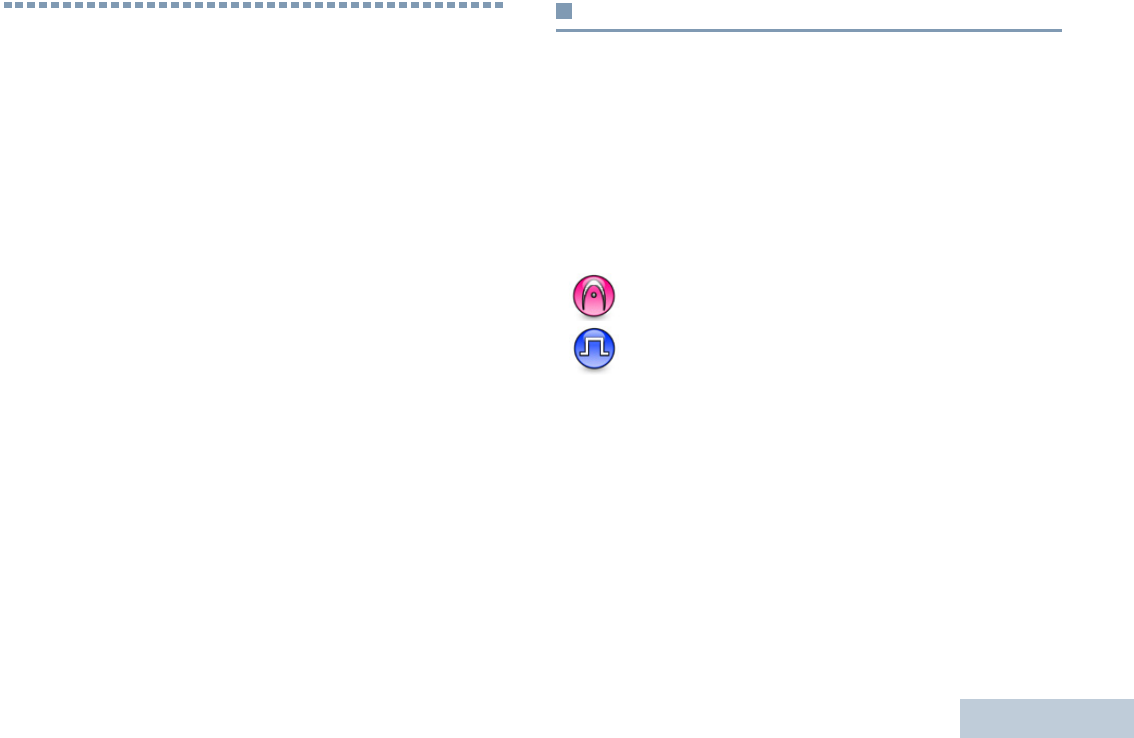
Getting Started
English
1
Getting Started
Take a moment to review the following:
How to Use This User Guide. . . . . . . . . . . . . . . . . . . . . page 1
What Your Dealer/System Administrator
Can Tell You. . . . . . . . . . . . . . . . . . . . . . . . . . . . . . . . page 2
Powering Up the Radio . . . . . . . . . . . . . . . . . . . . . . . . . page 2
Adjusting the Volume. . . . . . . . . . . . . . . . . . . . . . . . . . . page 3
How to Use This User Guide
This User Guide covers the basic operation of the MOTOTRBO
Mobiles.
However, your dealer or system administrator may have
customized your radio for your specific needs. Check with your
dealer or system administrator for more information.
Throughout this publication, the icons below are used to
indicate features supported in either the conventional Analog
mode or conventional Digital mode:
For features that are available in both Analog and Digital
modes, no icon is shown.
For features that are available in a conventional multi-site
mode, see IP Site Connect on page 10 for more information.
Selected features are available in the single-site trunking mode,
Capacity Plus. See Capacity Plus on page 11 for more
information.
Selected features are also available in the multi-site trunking
mode, Linked Capacity Plus. See Linked Capacity Plus on
page 11 for more information.
Indicates a conventional Analog Mode-Only feature.
Indicates a conventional Digital Mode-Only feature.
NAG.book Page 1 Thursday, January 3, 2013 3:15 PM

Getting Started
English
2
What Your Dealer/System Administrator
Can Tell You
You can consult your dealer or system administrator about the
following:
•Is your radio programmed with any preset conventional
channels?
•Which buttons have been programmed to access other
features?
•What optional accessories may suit your needs?
•What are the best radio usage practices for effective
communication?
•What maintenance procedures will help promote longer radio
life?
Powering Up the Radio
Press the On/Off
Button briefly. You see
MOTOTRBO (TM) on the
radio’s display
momentarily, followed
by a welcome message
or welcome image.
The green LED lights
up and the Home
screen lights up.
A brief tone sounds,
indicating that the
power up test is
successful.
NOTE: There is no power up tone if the radio tones/alerts
function is disabled (see Turning the Radio Tones/
Alerts On or Off on page 74).
If your radio does not power up, contact your dealer.
To turn off the radio, press and hold the On/Off Button until you
see
Powering Down
on the radio’s display.
NOTE: Your radio may take up to 7 seconds to completely turn
off.
On/Off Button
NAG.book Page 2 Thursday, January 3, 2013 3:15 PM

Getting Started
English
3
Adjusting the Volume
To increase the volume, turn the Volume/Channel Knob
clockwise.
To decrease the volume, turn this knob counterclockwise.
NOTE: Your radio can be programmed to have a minimum
volume offset where the volume level cannot be turned
past the programmed minimum volume. Check with
your dealer or system administrator for more
information.
Volume/Channel Knob
NAG.book Page 3 Thursday, January 3, 2013 3:15 PM

Identifying Radio Controls
English
4
Identifying Radio Controls
Take a moment to review the following:
Radio Controls . . . . . . . . . . . . . . . . . . . . . . . . . . . . . . . page 5
Programmable Buttons . . . . . . . . . . . . . . . . . . . . . . . . . page 6
Accessing the Programmed Functions . . . . . . . . . . . . . page 8
Push-To-Talk (PTT) Button . . . . . . . . . . . . . . . . . . . . . . page 9
Using the Volume/Channel Knob . . . . . . . . . . . . . . . . page 10
Switching Between Conventional Analog and
Digital Mode. . . . . . . . . . . . . . . . . . . . . . . . . . . . . . . . page 9
IP Site Connect . . . . . . . . . . . . . . . . . . . . . . . . . . . . . . page 10
Capacity Plus . . . . . . . . . . . . . . . . . . . . . . . . . . . . . . . page 11
Linked Capacity Plus. . . . . . . . . . . . . . . . . . . . . . . . . . page 11
NAG.book Page 4 Thursday, January 3, 2013 3:15 PM

Identifying Radio Controls
English
5
Radio Controls
On/Off Button
Volume/Channel Knob
Display
OK/Menu Button
Scroll Up/Down
12 643
10 9 78
5
1
2
3
4
5
Speaker
Return/Home Button
Front Programmable Buttons
Accessory Connector
LED Indicators
6
7
8
9
10
NAG.book Page 5 Thursday, January 3, 2013 3:15 PM

Identifying Radio Controls
English
6
Programmable Buttons
Your dealer can program the programmable buttons as
shortcuts to radio functions or up to a maximum of six (6)
preset channels/groups depending on the duration of a button
press:
•Short press – Pressing and releasing rapidly.
•Long press – Pressing and holding for the programmed
duration.
•Hold down – Keeping the button pressed.
NOTE: The programmed duration of a button press is
applicable for all assignable radio/utility functions or
settings. See Emergency Operation on page 49 for
more information on the programmed duration of the
Emergency button.
Assignable Radio Functions
Contacts – Provides direct access to the contacts list.
Call Alert – Provides direct access to the contacts list for you to
select a contact to whom a Call Alert can be sent.
Call Forwarding – Toggles Call Forwarding on or off.
Call Log – Selects the call log list.
Voice Announcement for Channel – Plays zone and channel
announcement voice messages for the current channel. This
function is unavailable when Voice Announcement is disabled.
Emergency – Depending on the programming, initiates or
cancels an Emergency alarm or call.
Ext PA On/Off – Toggles the audio routing between the
connected public address (PA) loudspeaker amplifier and the
radio’s internal public address (PA) system.
Intelligent Audio On/Off – Toggles Intelligent Audio on or off.
Manual Dial – Depending on the programming, initiates a
Private or Phone call by keying in any subscriber ID or phone
number.
Manual Site Roam*‡ – Starts the manual site search.
Monitor – Monitors a selected channel for activity.
Notifications – Provides direct access to the Notifications List.
Nuisance Channel Delete*‡ – Temporarily removes an
unwanted channel, except for the Selected Channel, from the
scan list. The Selected Channel refers to the user’s selected
zone/channel combination from which scan is initiated.
* Not applicable in Capacity Plus
‡ Not applicable in Linked Capacity Plus
NAG.book Page 6 Thursday, January 3, 2013 3:15 PM

Identifying Radio Controls
English
7
One Touch Access – Directly initiates a predefined
Private, Phone or Group Call, a Call Alert or a Quick Text
message.
Option Board Feature – Toggles option board feature(s) on or
off for option board-enabled channels.
PA On/Off – Toggles the radio’s internal public address (PA)
system on or off.
Permanent Monitor*‡ – Monitors a selected channel for all
radio traffic until function is disabled.
Phone – Provides direct access to the Phone Contacts list.
Privacy – Toggles privacy on or off.
Radio Alias and ID – Provides radio alias and ID.
Radio Check – Determines if a radio is active in a system.
Radio Enable – Allows a target radio to be remotely
enabled.
Radio Disable – Allows a target radio to be remotely
disabled.
Remote Monitor – Turns on the microphone of a target
radio without it giving any indicators.
Repeater/Talkaround*‡ – Toggles between using a repeater
and communicating directly with another radio.
Scan*‡ – Toggles scan on or off.
Site Info* – Displays current Linked Capacity Plus site name
and ID. Plays site announcement voice messages for the
current site (this function is unavailable when Voice
Announcement is disabled).
Site Lock On/Off* – Toggles the automatic site roam on or
off.
Status – Selects the status list menu.
Telemetry Control – Controls the Output Pin on a local or
remote radio.
Text Message – Selects the text message menu.
Transmit Interrupt Remote Dekey – Stops the
transmission of a remote monitored radio without giving any
indicators, or an ongoing interruptible call to free the channel.
Voice Announcement On/Off – Toggles Voice Announcement
on or off.
Voice Operating Transmission (VOX) – Toggles VOX on or
off.
* Not applicable in Capacity Plus
‡ Not applicable in Linked Capacity Plus
NAG.book Page 7 Thursday, January 3, 2013 3:15 PM

Identifying Radio Controls
English
8
Zone Toggle – Allows radio to switch between zones.
Assignable Settings or Utility Functions
All Tones/Alerts – Toggles all tones and alerts on or off.
Backlight – Adjusts the brightness level.
Channel Up/Down – Depending on the programming, changes
channel to previous or next channel.
Display Mode – Toggles the day/night display mode on or off.
Power Level – Toggles transmit power level between high and
low.
Squelch – Toggles squelch level between tight and
normal.
Accessing the Programmed Functions
You can access various radio functions through one of the
following ways:
•A short or long press of the relevant programmable buttons.
OR
•Use the Menu Navigation Buttons as follows:
1To access the menu, press the g button. Press the
appropriate Scroll Up/Down button (f or h) to access
the menu functions.
2To select a function or enter a sub-menu, press the g
button.
3To go back one menu level, or to return to the previous
screen, press the e button. Long press the e button to
return to the Home screen.
The Menu Navigation Buttons are also available on a keypad
microphone (see Using the Keypad on page 87).
NOTE: Your radio automatically exits the menu after a period
of inactivity and returns to your Home screen.
* Not applicable in Capacity Plus
‡ Not applicable in Linked Capacity Plus
NAG.book Page 8 Thursday, January 3, 2013 3:15 PM

Identifying Radio Controls
English
9
Push-To-Talk (PTT) Button
The PTT button on the side of
the microphone serves two
basic purposes:
•While a call is in progress,
the PTT button allows the
radio to transmit to other
radios in the call.
Press and hold down PTT
button to talk. Release the
PTT button to listen.
The microphone is activated when the PTT button is pressed.
•While a call is not in progress, the PTT button is used to make
a new call (see Making a Radio Call on page 24).
If the Talk Permit Tone (see Turning the Talk Permit Tone On
or Off on page 75) or the PTT Sidetone is enabled, wait
until the short alert tone ends before talking.
During a call, if the Channel Free Indication feature is
enabled on your radio (programmed by your dealer), you
hear a short alert tone the moment the target radio (the
radio that is receiving your call) releases the PTT button,
indicating the channel is free for you to respond.
You will also hear a continuous talk prohibit tone, if your
call is interrupted, indicating that you should release the
PTT button, for example when the radio receives an
Emergency Call.
Switching Between Conventional Analog
and Digital Mode
Each channel in your
radio can be configured
as a conventional
analog or conventional
digital channel.
To switch between an
analog or a digital
channel, use the
•Scroll Up/Down buttons, or
•Volume/Channel Knob, or
•programmed Channel Up or Channel Down buttons
When switching from digital to analog mode, certain features
are unavailable. Icons for the digital features (such as
Messages) reflect this change by appearing ‘grayed out’.
Disabled features are hidden in the menu.
Your radio also has features available in both analog and digital
mode. However, the minor differences in the way each feature
works does NOT affect the performance of your radio.
PTT Button
Scroll Up/Down
Volume/Channel Knob
NAG.book Page 9 Thursday, January 3, 2013 3:15 PM

Identifying Radio Controls
English
10
NOTE: Your radio also switches between digital and analog
modes during a dual mode scan (see Scan on
page 36).
To use the Scroll Up/Down buttons, while in the Home
Screen of the required Zone, press f or h to select
the required channel.
To use the programmed Channel Up or Channel
Down buttons, while in the Home Screen of the
required Zone, press Channel Up or Channel Down
to select the required channel.
Using the Volume/Channel Knob
The Volume/Channel Knob can be programmed as dual
purpose for both volume and channel or as a volume-only
control.
To adjust volume, see Adjusting the Volume on page 3.
To change channels, push and hold the knob until channel
selection screen is displayed, then turn the knob to the required
channel.
To exit channel selection state, do any of the following.
•Push the Volume/Channel Knob again
•Press g
•Press e
•Wait for the menu timer to expire
IP Site Connect
This feature allows your radio to extend conventional
communication beyond the reach of a single site, by connecting
to different available sites which are connected via an Internet
Protocol (IP) network.
When the radio moves out of range from one site and into the
range of another, it connects to the new site's repeater to send
or receive calls/data transmissions. Depending on your settings,
this is done automatically or manually.
If the radio is set to do this automatically, it scans through all
available sites when the signal from the current site is weak or
when the radio is unable to detect any signal from the current
site. It then locks on to the repeater with the strongest Received
Signal Strength Indicator (RSSI) value.
In a manual site search, the radio searches for the next site in
the roam list that is currently in range (but which may not have
the strongest signal) and locks on to it.
NOTE: Each channel can only have either Scan or Roam
enabled, not both at the same time.
Channels with this feature enabled can be added to a particular
roam list. The radio searches the channel(s) in the roam list
during the automatic roam operation to locate the best site.
A roam list supports a maximum of 16 channels (including the
Selected Channel).
NAG.book Page 10 Thursday, January 3, 2013 3:15 PM

Identifying Radio Controls
English
11
NOTE: You cannot manually add or delete an entry to the roam
list. Check with your dealer or system administrator for
more information.
Capacity Plus
Capacity Plus is a single-site trunking configuration of the
MOTOTRBO radio system, which uses a pool of channels to
support hundreds of users and up to 254 Groups. This feature
allows your radio to efficiently utilize the available number of
programmed channels while in Repeater Mode.
Icons of features not applicable to Capacity Plus are not
available in the menu. You hear a negative indicator tone if you
try to access a feature not applicable to Capacity Plus via a
programmable button press.
Your radio also has features that are available in conventional
digital mode, IP Site Connect, Capacity Plus and Linked
Capacity Plus. However, the minor differences in the way each
feature works does NOT affect the performance of your radio.
Check with your dealer or system administrator for more
information on this configuration.
Linked Capacity Plus
Linked Capacity Plus is a multi-site multi-channel trunking
configuration of the MOTOTRBO radio system, combining the
best of both Capacity Plus and IP Site Connect configurations.
Linked Capacity Plus allows your radio to extend trunking
communication beyond the reach of a single site, by connecting
to different available sites which are connected via an Internet
Protocol (IP) network. It also provides an increase in capacity by
efficiently utilizing the combined available number of
programmed channels supported by each of the available sites.
When the radio moves out of range from one site and into the
range of another, it connects to the new site's repeater to send
or receive calls/data transmissions. Depending on your settings,
this is done automatically or manually.
If the radio is set to do this automatically, it scans through all
available sites when the signal from the current site is weak or
when the radio is unable to detect any signal from the current
site. It then locks on to the repeater with the strongest Received
Signal Strength Indicator (RSSI) value.
In a manual site search, the radio searches for the next site in
the roam list that is currently in range (but which may not have
the strongest signal) and locks on to it.
Any channel with Linked Capacity Plus enabled can be added
to a particular roam list. The radio searches these channels
during the automatic roam operation to locate the best site.
NAG.book Page 11 Thursday, January 3, 2013 3:15 PM

Identifying Radio Controls
English
12
NOTE: You cannot manually add or delete an entry to the roam
list. Check with your dealer or system administrator for
more information.
Similar to Capacity Plus, icons of features not applicable to
Linked Capacity Plus are not available in the menu. You hear a
negative indicator tone if you try to access a feature not
applicable to Linked Capacity Plus via a programmable button
press.
Check with your dealer or system administrator for more
information on this configuration.
NAG.book Page 12 Thursday, January 3, 2013 3:15 PM
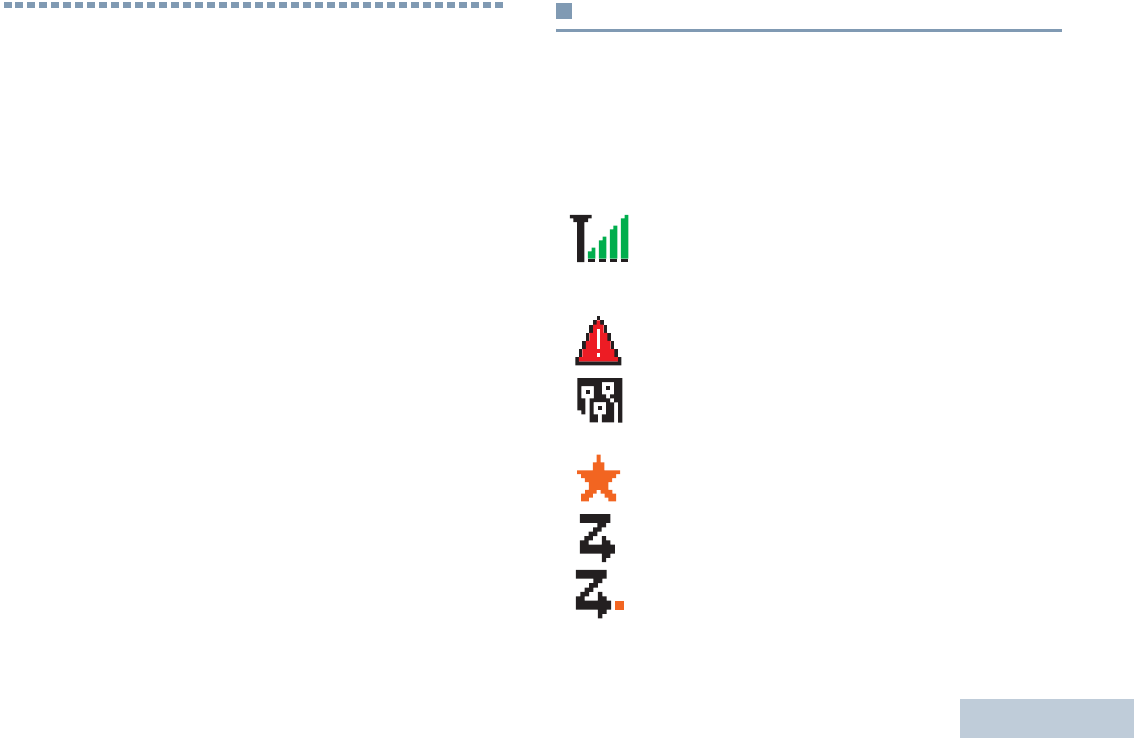
Identifying Status Indicators
English
13
Identifying Status Indicators
Your radio indicates its operational status through the following:
Display Icons . . . . . . . . . . . . . . . . . . . . . . . . . . . . . . . . page 13
Call Icons. . . . . . . . . . . . . . . . . . . . . . . . . . . . . . . . . . . page 15
Sent Item Icons . . . . . . . . . . . . . . . . . . . . . . . . . . . . . . page 16
LED Indicators. . . . . . . . . . . . . . . . . . . . . . . . . . . . . . . page 17
Audio Tones. . . . . . . . . . . . . . . . . . . . . . . . . . . . . . . . . page 18
Indicator Tones . . . . . . . . . . . . . . . . . . . . . . . . . . . . . . page 18
Display Icons
The liquid crystal display (LCD) of your radio shows the radio
status, text entries, and menu entries.
The following are icons that appear on the status bar at the top
of the radio’s display. Icons are displayed on the status bar,
arranged left-to-right, in order of appearance/usage and are
channel specific.
Received Signal Strength Indicator (RSSI)
The number of bars displayed represents the radio
signal strength. Four bars indicate the strongest
signal. This icon is only displayed while receiving.
Emergency
Radio is in Emergency mode.
High Volume Data
Radio is receiving high volume data and channel is
busy.
Notification
Notification List has one or more missed events.
Scan*‡
Scan feature is enabled.
Scan – Priority 1*‡
Radio detects activity on channel/group designated
as Priority 1).
NAG.book Page 13 Thursday, January 3, 2013 3:15 PM
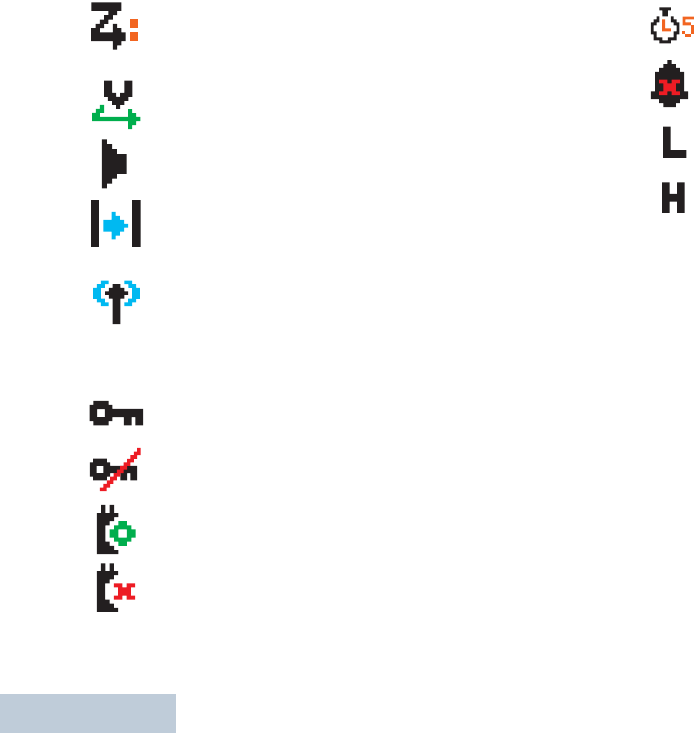
Identifying Status Indicators
English
14
Scan – Priority 2*‡
Radio detects activity on channel/group designated
as Priority 2.
Vote Scan
Vote scan feature is enabled.
Monitor
Selected channel is being monitored.
Talkaround*‡
In the absence of a repeater, radio is currently
configured for direct radio to radio communication.
Site Roaming*
The site roaming feature is enabled.
Secure
The Privacy feature is enabled.
Unsecure
The Privacy feature is disabled.
Option Board
The Option Board is enabled.
Option Board Non-Function
The Option Board is disabled.
* Not applicable in Capacity Plus
‡ Not applicable in Linked Capacity Plus
Over-the-Air Programming Delay Timer
Indicates time left before automatic restart of radio.
Tones Disable
Tones are turned off.
Power Level
Radio is set at Low power.
Radio is set at High power.
OR
* Not applicable in Capacity Plus
‡ Not applicable in Linked Capacity Plus
NAG.book Page 14 Thursday, January 3, 2013 3:15 PM
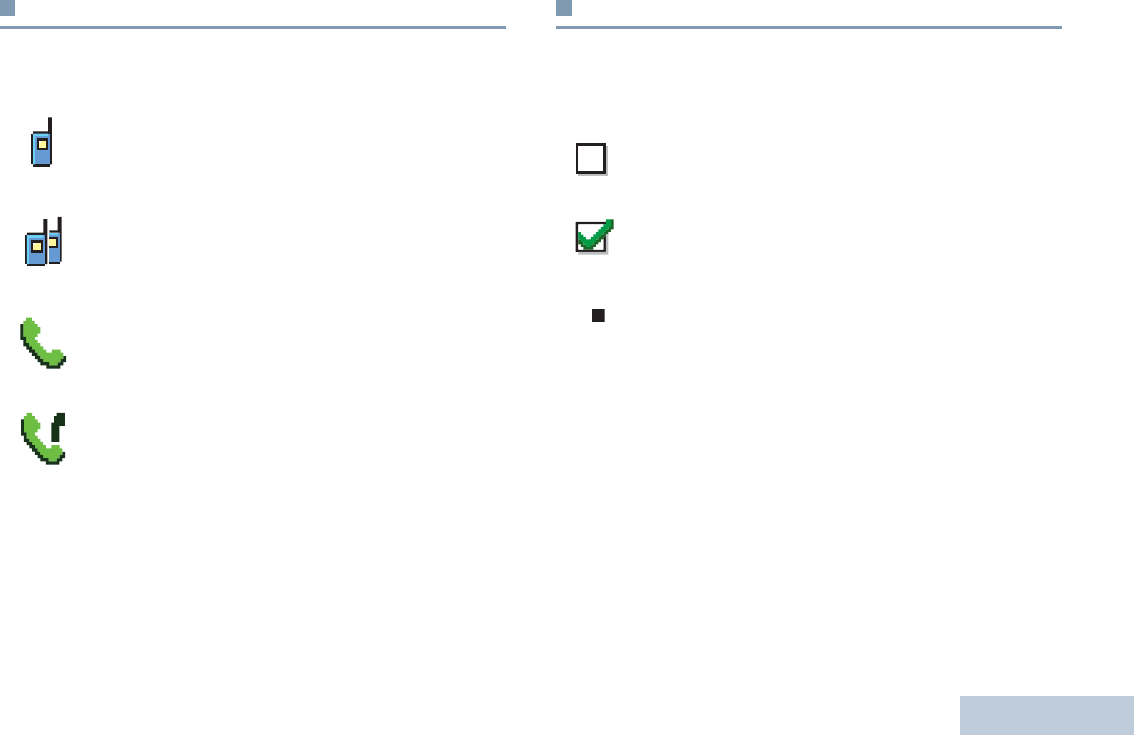
Identifying Status Indicators
English
15
Call Icons
The following icons appear on the radio’s display during a call.
These icons also appear in the Contacts list to indicate alias or
ID type.
Advanced Menu Icons
The following icons appear beside menu items on the radio’s
display that offer a choice between two options or as an
indication that there is a sub-menu offering two options.
Private Call
Indicates a Private Call in progress.
In the Contacts list, it indicates a subscriber alias
(name) or ID (number).
Group Call/All Call
Indicates a Group Call or All Call in progress.
In the Contacts list, it indicates a group alias (name)
or ID (number).
Phone Call as Private Call
Indicates a Phone Call as Private Call in progress. In
the Contacts list, it indicates a phone alias (name) or
ID (number).
Phone Call as Group/All Call
Indicates a Phone Call as Group/All Call in progress.
In the Contacts list, it indicates a group alias (name)
or ID (number).
Checkbox (Empty)
Indicates the option is not selected.
Checkbox (Checked)
Indicates the option is selected.
Solid Black Box
Indicates the option selected for the menu item with a
sub-menu.
NAG.book Page 15 Thursday, January 3, 2013 3:15 PM
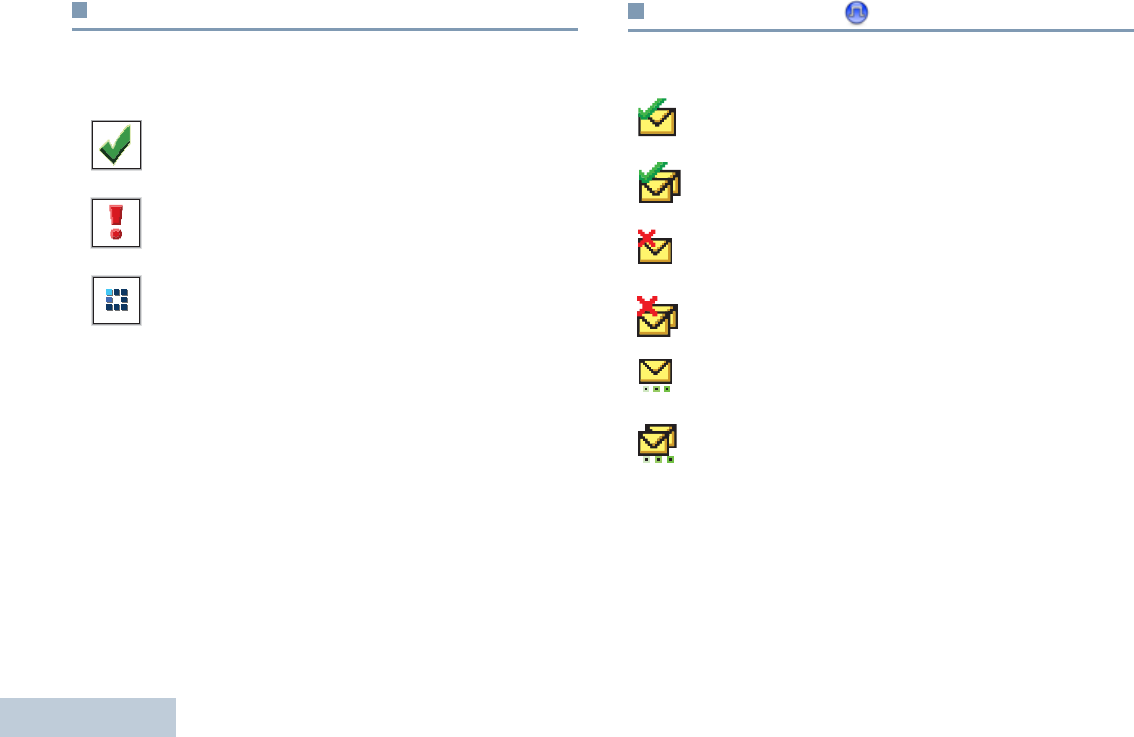
Identifying Status Indicators
English
16
Mini Notice Icons
The following icons appear momentarily on the radio’s display
after an action to perform task is taken.
Sent Item Icons
The following icons appear in the Sent Items folder.
Successful Transmission (Positive)
Successful action taken.
Failed Transmission (Negative)
Failed action taken.
Transmission in Progress (Transitional)
Transmitting. This dynamic icon is seen before
indication for Successful Transmission or Failed
Transmission.
Sent Successfully
The text message is sent successfully.
Send Failed
The text message cannot be sent.
In-Progress
•The text message to a subscriber alias or ID is
pending transmission, followed by waiting for
acknowledgement.
•The text message to a group alias or ID is pending
transmission.
OR
OR
OR
NAG.book Page 16 Thursday, January 3, 2013 3:15 PM

Identifying Status Indicators
English
17
LED Indicators
LED indicators show the operational status of your radio.
Blinking red – Radio is receiving an emergency transmission
or has failed the self-test upon powering up, or has moved out
of range if radio is configured with Auto-Range Transponder
System.
Solid green – Radio is powering up, or transmitting.
Blinking green – Radio is receiving a non-privacy-enabled call
or data, or detecting activity or retrieving Over-the-Air
Programming transmissions over the air.
Double blinking green – Radio is receiving a privacy-enabled
call or data.
Solid yellow – Radio is monitoring a conventional channel .
Blinking yellow – Radio is scanning for activity or receiving a
Call Alert, or all local Linked Capacity Plus channels are busy.
Double blinking yellow – Radio is no longer connected to the
repeater while in Capacity Plus or Linked Capacity Plus, all
Capacity Plus channels or Linked Capacity Plus channels are
currently busy, Auto Roaming is enabled, radio is actively
searching for a new site. Also indicates radio has yet to respond
to a group call alert, or radio is locked.
NOTE: While in conventional mode, when the green LED
blinks, it indicates the radio detects activity over the air.
Due to the nature of the digital protocol, this activity
may or may not affect the radio's programmed channel.
For Capacity Plus and Linked Capacity Plus, there is
no LED indication when the radio is detecting activity
over the air.
Red
Yellow
Green
NAG.book Page 17 Thursday, January 3, 2013 3:15 PM
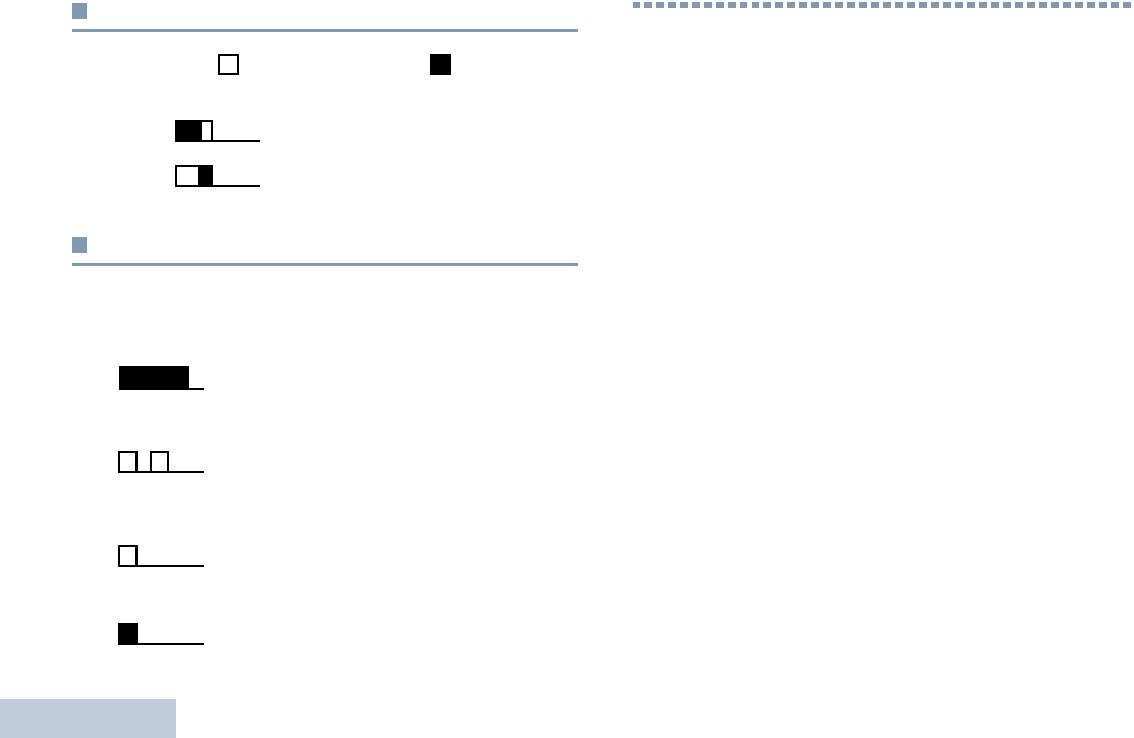
Receiving and Making Calls
English
18
Indicator Tones
High pitched tone Low pitched tone
Audio Tones
Alert tones provide you with audible indications of the radio’s
status or the radio’s response to data received.
Receiving and Making Calls
Once you understand how your MOTOTRBO Mobile is
configured, you are ready to use your radio.
Use this navigation guide to familiarize yourself with the basic
Call features:
Selecting a Zone . . . . . . . . . . . . . . . . . . . . . . . . . . . . . page 19
Selecting a Radio Channel, Subscriber Alias or ID,
or Group Alias or ID . . . . . . . . . . . . . . . . . . . . . . . . . page 19
Receiving and Responding to a Radio Call . . . . . . . . . page 20
Making a Radio Call. . . . . . . . . . . . . . . . . . . . . . . . . . . page 24
Stopping a Radio Call . . . . . . . . . . . . . . . . . . . . . . . . . page 29
Talkaround . . . . . . . . . . . . . . . . . . . . . . . . . . . . . . . . . . page 29
Permanent Monitor . . . . . . . . . . . . . . . . . . . . . . . . . . . page 30
Positive Indicator Tone
Negative Indicator Tone
Continuous Tone A monotone sound. Sounds
continuously until termination.
Periodic Tone Sounds periodically depending on the
duration set by the radio. Tone starts,
stops, and repeats itself.
Repetitive Tone A single tone that repeats itself until it is
terminated by the user.
Momentary Tone Sounds only once for a short period of
time defined by the radio.
NAG.book Page 18 Thursday, January 3, 2013 3:15 PM

Receiving and Making Calls
English
19
Selecting a Zone
A zone is a group of channels. Your radio supports up to 99
channels and 2 zones, with a maximum of 99 channels per
zone.
Use the following procedure to select a zone.
Procedure:
Press the programmed Zone button and proceed to Step 3.
OR
Follow the procedure below.
1g to access the menu.
2f or h to Zone and press g to select.
3The current zone is displayed and indicated by a 9.
4f or h to the required zone and press g to select.
5The display shows <Zone> Selected momentarily and
returns to the selected zone screen.
Selecting a Channel
Transmissions are sent and received on a channel. Depending
on your radio's configuration, each channel may have been
programmed differently to support different groups of users or
supplied with different features. After selecting the required
zone, select the channel you require to transmit or receive on.
Procedure:
Select a channel by using:
•Scroll Up/Down buttons, OR
•Volume/Channel Knob, OR
•The programmed Channel Up or Channel Down buttons
See Selecting a Zone on page 19 for more information on
selecting your required zone.
See Switching Between Conventional Analog and Digital
Mode on page 9 for information about Scroll Up/Down buttons.
See Using the Volume/Channel Knob on page 10 for
information about using the Volume/Channel Knob.
See Programmable Buttons on page 6 for information about
the Channel Up or Channel Down buttons.
NAG.book Page 19 Thursday, January 3, 2013 3:15 PM

Receiving and Making Calls
English
20
Receiving and Responding to a Radio Call
Once the channel, subscriber
alias or ID, or group alias or ID
is displayed, you can proceed
to receive and respond to
calls.
The green LED lights up
while the radio is transmitting
and blinks when the radio is
receiving.
NOTE: The green LED lights up while the radio is transmitting
and double blinks when the radio is receiving a privacy-
enabled call.
To unscramble a privacy-enabled call, your radio must
have the same Privacy Key, or the same Key Value and
Key ID (programmed by your dealer) as the
transmitting radio (the radio you are receiving the call
from).
See Privacy on page 65 for more information.
Receiving and Responding to a Group Call
To receive a call made to a group of users, your radio must be
configured as part of that group.
Procedure:
When you receive a Group Call (while on the Home screen):
1The green LED blinks.
2The Group Call icon appears in the top right corner. The first
text line shows the caller alias. The second text line displays
the group call alias. Your radio unmutes and the incoming
call sounds through the radio's speaker.
3 If the Channel Free Indication feature is enabled, you
hear a short alert tone the moment the transmitting radio
releases the PTT button, indicating the channel is free for
you to respond.
Press the PTT button to respond to the call.
OR
If the Voice Interrupt feature is enabled, press the PTT
button to stop the current call from the transmitting radio and
free the channel for you to talk/respond.
4The green LED lights up.
5Wait for the Talk Permit Tone to finish (if enabled) and speak
clearly into the microphone.
OR
Green
LED
NAG.book Page 20 Thursday, January 3, 2013 3:15 PM

Receiving and Making Calls
English
21
Wait for the PTT Sidetone to finish (if enabled) and
speak clearly into the microphone.
6Release the PTT button to listen.
7If there is no voice activity for a predetermined period of
time, the call ends.
See Making a Group Call on page 25 for details on making a
Group Call.
Receiving and Responding to a Private Call
A Private Call is a call from an individual radio to another
individual radio.
Procedure:
When you receive a Private Call:
1The green LED blinks.
2The Private Call icon appears in the top right corner. The
first text line shows the caller alias. Your radio unmutes and
the incoming call sounds through the radio's speaker.
3If the Channel Free Indication feature is enabled, you hear a
short alert tone the moment the transmitting radio releases
the PTT button, indicating the channel is free for you to
respond.
Press the PTT button to respond to the call.
OR
If the Voice Interrupt feature is enabled, press the PTT
button to stop the current call from the transmitting radio and
free the channel for you to talk/respond.
4The green LED lights up.
5Wait for the Talk Permit Tone to finish (if enabled) and speak
clearly into the microphone.
6Release the PTT button to listen.
7If there is no voice activity for a predetermined period of
time, the call ends.
8You hear a short tone. The display shows Call Ended.
See Making a Private Call on page 25 for details on making a
Private Call.
NAG.book Page 21 Thursday, January 3, 2013 3:15 PM

Receiving and Making Calls
English
22
Receiving an All Call
An All Call is a call from an individual radio to every radio on the
channel. It is used to make important announcements requiring
the user’s full attention.
Procedure:
When you receive an All Call:
1A tone sounds and the green LED blinks.
2The Group Call icon appears in the top right corner. The first
text line shows the caller alias. The second text line displays
All Call. Your radio unmutes and the incoming call sounds
through the radio's speaker.
3Once the All Call ends, the radio returns to the previous
screen before receiving the call. An All Call does not wait for
a predetermined period of time before ending.
If the Channel Free Indication feature is enabled, you
hear a short alert tone the moment the transmitting radio
releases the PTT button, indicating the channel is now
available for use.
You cannot respond to an All Call.
See Making an All Call on page 26 for details on making an All
Call.
NOTE: The radio stops receiving the All Call if you switch to a
different channel while receiving the call.
During an All Call, you are not able to continue with
any menu navigation or editing until the call ends.
Receiving and Responding to a Selective Call
A Selective Call is a call from an individual radio to another
individual radio. It is a Private Call on an analog system.
Procedure:
When you receive a Selective Call:
1The green LED blinks.
2The Private Call icon appears in the top right corner. The
first text line shows the caller alias or Selective Call or
Alert with Call. Your radio unmutes and the incoming
call sounds through the radio's speaker.
3If the Channel Free Indication feature is enabled, you hear a
short alert tone the moment the transmitting radio releases
the PTT button, indicating the channel is free for you to
respond.
Press the PTT button to respond to the call.
4The green LED lights up.
5Wait for the Talk Permit Tone to finish (if enabled) and speak
clearly into the microphone.
6Release the PTT button to listen.
7If there is no voice activity for a predetermined period of
time, the call ends.
8You hear a short tone. The display shows Call Ended.
NAG.book Page 22 Thursday, January 3, 2013 3:15 PM

Receiving and Making Calls
English
23
NOTE: See Making a Selective Call on page 27 for details on
making a Selective Call.
Receiving and Responding to a Phone Call
NOTE: If Phone Call capability is enabled, you are able to
respond to a Phone Call. Check with your dealer or
system administrator for more information.
Phone Call as Private Call
Procedure:
When you receive a Phone Call as a Private Call:
1The Phone Call icon appears in the top right corner. The
display shows the caller alias or Phone Call.
2Press the PTT button to talk and release it to listen.
3Press e to end the call.
The display shows Ending Phone Call.
4If successful:
A tone sounds and the display shows Call Ended.
OR
If unsuccessful:
Your radio returns to the Phone Call screen. Repeat Step 3
or wait for the telephone user to end the call.
If Phone Call capability is not enabled in your radio, the display
shows
Unavailable
and your radio mutes the call. Your radio
returns to the previous screen when the call ends.
Phone Call as Group Call
Procedure:
When you receive a Phone Call as a Group Call:
1The Phone Group Call icon appears in the top right corner.
The display shows the group alias and Phone Call.
2Press the PTT button to talk and release it to listen.
3Press e to end the call.
The display shows Ending Phone Call.
4If successful:
A tone sounds and the display shows Call Ended.
OR
If unsuccessful:
Your radio returns to the Phone Call screen. Repeat Step 3
or wait for the telephone user to end the call.
If Phone Call capability is not enabled in your radio, the display
shows
Unavailable
and your radio mutes the call. Your radio
returns to the previous screen when the call ends.
NAG.book Page 23 Thursday, January 3, 2013 3:15 PM

Receiving and Making Calls
English
24
Phone Call as All Call
Procedure:
When you receive a Phone Call as an All Call:
1The Phone Call icon appears in the top right corner. The
display shows All Call and Phone Call.
2Press the PTT button to talk and release it to listen.
3Press e to end the call.
The display shows Ending Phone Call.
4If successful:
A tone sounds and the display shows All Call and
Call Ended.
OR
If unsuccessful:
Your radio returns to the Phone Call screen. Repeat Step 3
to end the call.
If Phone Call capability is not enabled in your radio, the display
shows
Unavailable
and your radio mutes the call. Your radio
returns to the previous screen when the call ends.
NOTE: When you receive a Phone Call as an All Call, you can
respond to the call or end the call, only if an All Call
type is assigned to the channel.
Making a Radio Call
After selecting your channel, you can select a subscriber alias
or ID, or group alias or ID by using:
•The Contacts list (see Contacts Settings on page 39)
•A programmed One Touch Access button
•The programmed number keys – This method is for Group,
Private and All Calls only and is used with the keypad
microphone (see Making a Group, Private or All Call with
the Programmable Number Key on page 94).
•Manual Dial (via Contacts) – This method is for Private Calls
and Phone Calls only and is dialed using a keypad
microphone (see Making a Private Call by Manual Dial on
page 90, Making a Phone Call by Manual Dial on page 90)
•A programmable button – This method is for Phone Calls only
(see Making a Private Call by Manual Dial on page 90)
NOTE: Your radio must have the Privacy feature enabled on
the channel to send a privacy-enabled transmission.
Only target radios with the same Privacy Key as your
radio are able to unscramble the transmission.
See Privacy on page 65 for more information.
NAG.book Page 24 Thursday, January 3, 2013 3:15 PM

Receiving and Making Calls
English
25
The One Touch Access feature allows you to make a
Group or Private Call to a predefined ID easily. This
feature can be assigned to a short or long
programmable button press.You can ONLY have one
ID assigned to a One Touch Access button. Your
radio can have multiple One Touch Access buttons
programmed.
Making a Group Call
To make a call to a group of users, your radio must be
configured as part of that group.
Procedure:
1Select the channel with the active group alias or ID. See
Selecting a Channel on page 19.
OR
Press the programmed One Touch Access button.
2Press the PTT button to make the call. The green LED lights
up. The Group Call icon appears in the top right corner. The
first text line shows the group call alias.
3Wait for the Talk Permit Tone to finish (if enabled) and speak
clearly into the microphone.
OR
Wait for the PTT Sidetone to finish (if enabled) and
speak clearly into the microphone.
4Release the PTT button to listen. When the target radio
responds, the green LED blinks. You see the Group Call
icon, the group alias or ID, and transmitting radio alias
or ID on your display.
5 If the Channel Free Indication feature is enabled, you
hear a short alert tone the moment the target radio releases
the PTT button, indicating the channel is free for you to
respond. Press the PTT button to respond.
OR
If there is no voice activity for a predetermined period of
time, the call ends.
6Radio returns to the screen you were on prior to initiating the
call.
You can also make a Group Call via Contacts (see Making a
Group Call from Contacts on page 39).
Making a Private Call
While you can receive and/or respond to a Private Call
initiated by an authorized individual radio, your radio must
be programmed for you to initiate a Private Call.
There are two types of Private Calls. The first type, where a
radio presence check is performed prior to setting up the call,
while the other sets up the call immediately.
Only one of these call types can be programmed to your radio
by your dealer.
NAG.book Page 25 Thursday, January 3, 2013 3:15 PM

Receiving and Making Calls
English
26
You hear a negative indicator tone, when you make a Private
Call via the Menu, Call Log, Contacts list, One Touch Access
button, the programmed number keys, Scroll Up/Down
buttons, or the Volume/Channel Knob if this feature is not
enabled.
Use the Text Message or Call Alert features to contact an
individual radio. See Text Messaging Features on page 55 or
Call Alert Operation on page 48 for more information.
Procedure:
1Select the channel with the active subscriber alias or ID.
See Selecting a Channel on page 19.
OR
Press the programmed One Touch Access button.
2Press the PTT button to make the call. The green LED lights
up. The Private Call icon appears in the top right corner. The
first text line shows the subscriber alias. The second text
line displays the call status.
3Wait for the Talk Permit Tone to finish (if enabled) and speak
clearly into the microphone.
4Release the PTT button to listen. When the target radio
responds, the green LED blinks.
5If the Channel Free Indication feature is enabled, you hear a
short alert tone the moment the target radio releases the
PTT button, indicating the channel is free for you to respond.
Press the PTT button to respond.
OR
If there is no voice activity for a predetermined period of
time, the call ends.
6You hear a short tone. The display shows Call Ended.
You can also make a Private Call via Contacts (see Making a
Private Call from Contacts on page 40), manually dial a
Private Call (see Making a Private Call by Manual Dial on
page 90) or perform a quick alphanumeric search for the
required target alias via a keypad entry (see Making a Group,
Private, Phone or All Call by Alias Search on page 98).
Making an All Call
This feature allows you to transmit to all users on the channel.
Your radio must be programmed to allow you to use this feature.
Procedure:
1Select the channel with the active All Call group alias or ID.
See Selecting a Channel on page 19.
2Press the PTT button to make the call. The green LED lights
up. The Group Call icon appears in the top right corner. The
first text line shows All Call.
3Wait for the Talk Permit Tone to finish (if enabled) and speak
clearly into the microphone.
OR
NAG.book Page 26 Thursday, January 3, 2013 3:15 PM

Receiving and Making Calls
English
27
Wait for the PTT Sidetone to finish (if enabled) and
speak clearly into the microphone.
Users on the channel cannot respond to an All Call.
Making a Selective Call
Just like a Private Call, while you can receive and/or respond to
a Selective Call initiated by an authorized individual radio, your
radio must be programmed for you to initiate a Selective Call.
Procedure:
1Select the channel with the active subscriber alias or ID.
See Selecting a Channel on page 19.
2Press the PTT button to make the call. The green LED lights
up. The Private Call icon appears in the top right corner. The
first text line shows the subscriber alias. The second text
line displays the call status.
3Wait for the Talk Permit Tone to finish (if enabled) and speak
clearly into the microphone.
4Release the PTT button to listen. When the target radio
responds, the green LED blinks.
5If the Channel Free Indication feature is enabled, you hear a
short alert tone the moment the target radio releases the
PTT button, indicating the channel is free for you to respond.
Press the PTT button to respond.
OR
If there is no voice activity for a predetermined period of
time, the call ends.
6You hear a short tone. The display shows Call Ended.
Making a Phone Call
1Press the programmed Phone button to enter into the
Phone Entry list. ^ or v to the required subscriber alias or
ID, and press g to select.
OR
Press the programmed One Touch Access button.
2If the access code was not preconfigured, the display shows
Access Code:. Enter the access code and press g to
proceed.
3Press the PTT button to make the call. The green LED lights
up. The Phone Call icon appears in the top right corner. The
first text line shows the subscriber alias. The second text
line displays the call status.
4If successful:
The DTMF tone sounds. You hear the dialing tone of the
telephone user. The first text line shows the subscriber alias.
The Phone Call icon remains in the top right corner.
OR
If unsuccessful:
A tone sounds and the display shows Phone Call Failed.
Your radio returns to the Access Code input screen.
If the access code was preconfigured in the Contacts list,
NAG.book Page 27 Thursday, January 3, 2013 3:15 PM

Receiving and Making Calls
English
28
the radio returns to the screen you were on prior to initiating
the call.
5Hold the radio vertically 1 to 2 inches (2.5 to 5.0 cm) from
your mouth.
6Press the PTT button to talk and release it to listen.
To enter extra digits, if requested by the Phone Call:
Enter the extra digits using the keypad and press g to
proceed. The DTMF tone sounds and the radio returns to
the previous screen.
7Press e to end the call.
If de-access code was not preconfigured in the Contacts list,
the display shows De-Access Code:. Enter the de-access
code and press g to proceed. The radio returns to the
previous screen.
OR
Press One Touch Access button. The DTMF tone sounds.
If the entry for the One Touch Access button is empty, a
negative indicator tone sounds.
8The DTMF tone sounds and the display shows Ending
Phone Call.
9If successful:
A tone sounds and the display shows Call Ended.
OR
If unsuccessful:
Your radio returns to the Phone Call screen. Repeat Steps 6
and 7 or wait for the telephone user to end the call.
When the telephone user ends the call, a tone sounds and the
display shows Call Ended.
If the call ends while you are entering the extra digits requested
by the Phone Call, your radio returns to the screen you were on
prior to initiating the call.
During channel access, press e to dismiss the call attempt
and a tone sounds.
During the call, when you press One Touch Access button with
the deaccess code preconfigured or enter the deaccess code
as the input for extra digits, your radio attempts to end the call.
The access or deaccess code cannot be more than 10
characters.
NAG.book Page 28 Thursday, January 3, 2013 3:15 PM

Receiving and Making Calls
English
29
Stopping a Radio Call
This feature allows you to stop an ongoing Group or Private Call
to free the channel for transmission. For example, when a radio
experiences a “stuck microphone” condition where the PTT
button is inadvertently pressed by the user.
Your radio must be programmed to allow you to use this feature.
Procedure:
While on the required channel:
1Press the programmed Transmit Interrupt Remote Dekey
button.
2The display shows Remote Dekey.
3Wait for acknowledgment.
4The radio sounds a positive indicator tone and the display
shows Remote Dekey Success, indicating that the channel
is now free.
OR
The radio sounds a negative indicator tone and the display
shows Remote Dekey Failed.
On the interrupted radio, the display shows
Call Interrupted
, and the radio sounds a negative indicator
tone until you release the PTT button, if it is transmitting an
interruptible call that is stopped via this feature.
Talkaround
You can continue to communicate when your repeater is not
operating, or when your radio is out of the repeater’s range but
within talking range of other radios. This is called “talkaround”.
NOTE: This feature is not applicable in Capacity Plus and
Linked Capacity Plus.
Procedure:
Press the programmed Repeater/Talkaround button to toggle
between talkaround and repeater modes.
OR
Follow the procedure below.
1g to access the menu.
2f or h to Utilities and press g to select.
3f or h to Radio Settings and press g to select.
4f or h to Talkaround and press g to select.
5Press g to enable Talkaround. The display shows 9
beside Enabled.
OR
Press g to disable Talkaround. The 9 disappears from
beside Enabled.
6The screen automatically returns to the previous menu.
The Talkaround setting is retained even after powering down.
NAG.book Page 29 Thursday, January 3, 2013 3:15 PM

Receiving and Making Calls
English
30
Permanent Monitor
Use the Permanent Monitor feature to continuously monitor a
selected channel for activity.
NOTE: This feature is not applicable in Capacity Plus and
Linked Capacity Plus.
Procedure:
1Press the programmed Permanent Monitor button.
2Radio sounds an alert tone, the yellow LED lights up, and
the display shows Permanent Monitor On. The monitor
icon appears on the status bar.
3Press the programmed Permanent Monitor button to exit
Permanent Monitor mode.
4Radio sounds an alert tone, the yellow LED turns off, and
display shows Permanent Monitor Off.
NAG.book Page 30 Thursday, January 3, 2013 3:15 PM

Advanced Features
English
31
Advanced Features
Use this navigation guide to learn more about advanced
features available with your radio:
Radio Check . . . . . . . . . . . . . . . . . . . . . . . . . . . . . . . . page 32
Remote Monitor. . . . . . . . . . . . . . . . . . . . . . . . . . . . . . page 33
Scan Lists . . . . . . . . . . . . . . . . . . . . . . . . . . . . . . . . . . page 34
Scan . . . . . . . . . . . . . . . . . . . . . . . . . . . . . . . . . . . . . . page 36
Vote Scan . . . . . . . . . . . . . . . . . . . . . . . . . . . . . . . . . . page 38
Contacts Settings . . . . . . . . . . . . . . . . . . . . . . . . . . . . page 39
Call Indicator Settings. . . . . . . . . . . . . . . . . . . . . . . . . page 43
Call Log Features . . . . . . . . . . . . . . . . . . . . . . . . . . . . page 46
Call Alert Operation. . . . . . . . . . . . . . . . . . . . . . . . . . . page 48
Emergency Operation . . . . . . . . . . . . . . . . . . . . . . . . . page 49
Text Messaging Features . . . . . . . . . . . . . . . . . . . . . . page 55
Analog Message Encode . . . . . . . . . . . . . . . . . . . . . . page 64
Analog Status Update . . . . . . . . . . . . . . . . . . . . . . . . . page 64
Privacy . . . . . . . . . . . . . . . . . . . . . . . . . . . . . . . . . . . . page 65
Analog Scrambling . . . . . . . . . . . . . . . . . . . . . . . . . . . page 66
Multi-Site Controls. . . . . . . . . . . . . . . . . . . . . . . . . . . . page 66
Security . . . . . . . . . . . . . . . . . . . . . . . . . . . . . . . . . . . . page 68
Lone Worker . . . . . . . . . . . . . . . . . . . . . . . . . . . . . . . . page 70
Notification List . . . . . . . . . . . . . . . . . . . . . . . . . . . . . . page 72
Auto-Range Transponder System (ARTS) . . . . . . . . . page 73
Over-the-Air Programming (OTAP). . . . . . . . . . . . . . . page 73
Utilities . . . . . . . . . . . . . . . . . . . . . . . . . . . . . . . . . . . . . page 74
NAG.book Page 31 Thursday, January 3, 2013 3:15 PM

Advanced Features
English
32
Radio Check
If enabled, this feature allows you to determine if another radio
is active in a system without disturbing the user of that radio. No
audible or visual notification is shown on the target radio.
This feature is only applicable for subscriber aliases or IDs.
Sending a Radio Check
Procedure:
Use the programmed Radio Check button.
1Press the programmed Radio Check button.
2f or h to the required subscriber alias or ID and press
g to select.
3The display shows transitional mini notice, indicating the
request is in progress. The green LED lights up.
4Wait for acknowledgement.
5If successful, a positive indicator tone sounds and the
display shows positive mini notice.
OR
If unsuccessful, a negative indicator tone sounds and the
display shows negative mini notice.
6Radio returns to the subscriber alias or ID screen.
OR
Procedure:
Use the menu.
1g to access the menu.
2f or h to Contacts and press g to select.
3f or h to the required subscriber alias or ID and press
g to select.
4f or h to Radio Check and press g to select.
5The display shows transitional mini notice, indicating the
request is in progress. The green LED lights up.
6Wait for acknowledgement.
7If successful, a positive indicator tone sounds and the
display shows positive mini notice.
OR
If unsuccessful, a negative indicator tone sounds and the
display shows negative mini notice.
8Radio returns to the subscriber alias or ID screen.
If the e button is pressed when the radio is waiting for
acknowledgement, a tone sounds, and the radio terminates all
retries and exits Radio Check mode.
You can also initiate Radio Check via manual dial (see
Initiating a Radio Check by Manual Dial on page 89).
NAG.book Page 32 Thursday, January 3, 2013 3:15 PM

Advanced Features
English
33
Remote Monitor
Use the Remote Monitor feature to turn on the microphone of a
target radio (subscriber IDs only). No audible or visual indication
is given to the target radio. You can use this feature to monitor,
remotely, any audible activity surrounding the target radio.
Your radio must be programmed to allow you to use this feature.
Initiating Remote Monitor
Procedure:
Use the programmed Remote Monitor button.
1Press the programmed Remote Monitor button.
2f or h to the required subscriber alias or ID and press
g to select.
3The display shows transitional mini notice, indicating the
request is in progress. The green LED lights up.
4Wait for acknowledgment.
5If successful, a positive indicator tone sounds and the
display shows positive mini notice. Your radio starts playing
audio from the monitored radio for a programmed duration
and display shows Rem. Monitor.
Once the timer expires, the radio sounds an alert tone and
the LED turns off.
OR
If unsuccessful, a negative indicator tone sounds and the
display shows negative mini notice.
OR
Procedure:
Use the menu.
1g to access the menu.
2f or h to Contacts and press g to select.
3f or h to the required subscriber alias or ID and press
g to select.
4f or h to Remote Mon. and press g to select.
5The display shows transitional mini notice, indicating the
request is in progress. The green LED lights up.
6Wait for acknowledgment.
7If successful, a positive indicator tone sounds and the
display shows positive mini notice. Your radio starts playing
audio from the monitored radio for a programmed duration
and display shows Rem. Monitor.
Once the timer expires, the radio sounds an alert tone and
the LED turns off.
OR
If unsuccessful, the radio sounds a negative indicator tone
the display shows negative mini notice.
You can also manually select a target radio address (see
Initiating Remote Monitor by Manual Dial on page 89).
NAG.book Page 33 Thursday, January 3, 2013 3:15 PM

Advanced Features
English
34
Stopping Remote Monitor
Remote Monitor automatically stops after a programmed
duration or when there is any user operation on the target radio.
Procedure:
1Press the programmed Transmit Interrupt Remote Dekey
button.
2The display shows transitional mini notice, indicating the
request is in progress. The green LED lights up.
3Wait for acknowledgment.
4If successful, a positive indicator tone sounds and the
display shows positive mini notice.
OR
If unsuccessful, a negative indicator tone sounds and the
display shows negative mini notice.
Scan Lists
Scan lists are created and assigned to individual channels/
groups. Your radio scans for voice activity by cycling through the
channel/group sequence specified in the scan list for the current
channel/group.
Your radio can support up to 250 scan lists, with a maximum of
16 members in a list. Each scan list supports a mixture of both
analog and digital entries.
You can add, delete, or prioritize channels by editing a scan list.
You can attach a new scan list to your radio via Front Panel
Programming.
NOTE: This feature is not applicable in Capacity Plus and
Linked Capacity Plus.
Viewing an Entry in the Scan List
Procedure:
1g to access the menu.
2f or h to Scan and press g to select.
3f or h to Scan List and press g to select.
4Use f or h to view each member on the list.
NAG.book Page 34 Thursday, January 3, 2013 3:15 PM

Advanced Features
English
35
The priority icon appears left of the member’s alias, if set, to
indicate whether the member is on a Priority 1 or Priority 2
channel list. You cannot have multiple Priority 1 or Priority 2
channels in a scan list.
There is no priority icon if priority is set to None.
Editing the Scan List
Adding a New Entry to the Scan List
Procedure:
1g to access the menu.
2f or h to Scan and press g to select.
3f or h to Scan List and press g to select.
4f or h to Add Member and press g to select.
5f or h to the required alias or ID and press g to
select.
6f or h to the required priority level and press g to
select.
7The display shows positive mini notice, followed
immediately by Add Another?.
8f or h to Yes and press g to select, to add another
entry, and repeat Steps 5 and 6.
OR
f or h to No and press g to select to save the current
list.
Deleting an Entry from the Scan List
Procedure:
1g to access the menu.
2f or h to Scan and press g to select.
3f or h to Scan List and press g to select.
4f or h to the required alias or ID and press g to
select.
5f or h to Delete and press g to select.
6At Delete Entry?, f or h to Yes and press g to
select, to delete the entry. The display shows positive mini
notice.
OR
f or h to No and press g to select to return to the
previous screen.
7Repeat Steps 4 to 6 to delete other entries.
After deleting all required aliases or IDs, long press e to
return to the Home screen.
NAG.book Page 35 Thursday, January 3, 2013 3:15 PM

Advanced Features
English
36
Setting and Editing Priority for an Entry in the Scan
List
Procedure:
1g to access the menu.
2f or h to Scan and press g to select.
3f or h to Scan List and press g to select.
4f or h to the required alias or ID and press g to
select.
5f or h to Edit Priority and press g to select.
6f or h to the required priority level and press g to
select.
7The display shows positive mini notice before returning to
the previous screen.
8The priority icon appears left of the member’s name.
There is no priority icon if priority is set to None.
Scan
When you start a scan, your radio cycles through the
programmed scan list for the current channel looking for voice
activity.
The yellow LED blinks and the scan icon appears on the status
bar.
During a dual mode scan, if you are on a digital channel, and
your radio locks onto an analog channel, it automatically
switches from digital mode to analog mode for the duration of
the call. This is also true for the reverse.
There are two ways of initiating scan:
•Main Channel Scan (Manual): Your radio scans all the
channels/groups in your scan list. On entering scan, your
radio may – depending on the settings – automatically start
on the last scanned “active” channel/group or on the channel
where scan was initiated.
•Auto Scan (Automatic): Your radio automatically starts
scanning when you select a channel/group that has Auto
Scan enabled.
NOTE: This feature is not applicable in Capacity Plus and
Linked Capacity Plus.
NAG.book Page 36 Thursday, January 3, 2013 3:15 PM

Advanced Features
English
37
Starting and Stopping Scan
Procedure:
Press the programmed Scan button to start or stop Scan. OR
Follow the procedure below.
1Use the Scroll Up/Down buttons to select a channel
programmed with a scan list.
2g to access the menu.
3f or h to Scan and press g to select.
4f or h to Scan State and press g to select.
5f or h to required scan state and press g to select.
6The display shows Scan On when scan is enabled. The
yellow LED blinks and the scan icon appears.
OR
The display shows Scan Off if scan is disabled. The LED
turns off and the scan icon disappears.
While scanning, the radio can only accept data (e.g. text
message, location, telemetry, or PC data) if received on its
Selected Channel.
Responding to a Transmission During a Scan
During scanning, your radio stops on a channel/group where
activity is detected. The radio stays on that channel for a
programmed time period known as “hang time”.
Procedure:
1 If the Channel Free Indication feature is enabled, you
hear a short alert tone the moment the transmitting radio
releases the PTT button, indicating the channel is free for
you to respond.
2Press the PTT button during hang time. The green LED
lights up.
3Wait for the Talk Permit Tone to finish (if enabled) and speak
clearly into the microphone.
OR
Wait for the PTT Sidetone to finish (if enabled) and
speak clearly into the microphone.
4Release the PTT button to listen.
5If you do not respond within the hang time, the radio returns
to scanning other channels/groups.
NAG.book Page 37 Thursday, January 3, 2013 3:15 PM

Advanced Features
English
38
Deleting a Nuisance Channel
If a channel continually generates unwanted calls or noise
(termed a “nuisance” channel), you can temporarily remove the
unwanted channel from the scan list.
This capability does not apply to the channel designated as the
Selected Channel.
Procedure:
1When your radio “locks on to” an unwanted or nuisance
channel, press the programmed Nuisance Channel Delete
button until you hear a tone.
2Release the Nuisance Channel Delete button. The
nuisance channel is deleted.
Deleting a “nuisance” channel is only possible through the
programmed Nuisance Channel Delete button. This feature is
not accessible through the menu.
Restoring a Nuisance Channel
Procedure:
To restore the deleted nuisance channel, do one of the
following:
•Turn the radio off and then power it on again, OR
•Stop and restart a scan via the programmed Scan button or
menu, OR
•Change the channel via the Scroll Up/Down buttons.
Vote Scan
Vote Scan provides you with wide area coverage in areas where
there are multiple base stations transmitting identical
information on different analog channels.
Your radio scans analog channels of multiple base stations and
performs a voting process to select the strongest received
signal. Once that is established, your radio unmutes to
transmissions from that base station.
The yellow LED blinks and the vote scan icon appears on the
status bar.
To respond to a transmission during a Vote Scan, follow the
same procedures as Responding to a Transmission During a
Scan on page 37.
NAG.book Page 38 Thursday, January 3, 2013 3:15 PM

Advanced Features
English
39
Contacts Settings
Contacts provides “address-book” capabilities on your radio.
Each entry corresponds to an alias or ID that you use to initiate
a call.
Each entry, depending on context, associates with one of five
types of calls: Group Call, Private Call, All Call, PC Call or
Dispatch Call.
PC Call and Dispatch Call are data-related. They are only
available with the applications. Refer to the data applications
documentation for further details.
NOTE: If the Privacy feature is enabled on a channel, you can
make privacy-enabled Group Call, Private Call, and All
Call on that channel. Only target radios with the same
Privacy Key OR the same Key Value and
Key ID as your radio are able to unscramble the
transmission.
See Privacy on page 65 for more information.
Additionally, Contacts menu allows you to assign each entry to a
programmable number key or more on a keypad microphone. If
an entry is assigned to a number key, your radio can perform a
quick dial on the entry.
Your radio supports two Contacts lists, one for Analog contacts
and one for Digital contacts, with a a maximum of 500 members
for each Contacts list.
Each entry within Contacts displays the following information:
•Call Type
•Call Alias
•Call ID
NOTE: You can add, or edit subscriber IDs for the Digital
Contacts list. Deleting subscriber IDs can only be
performed by your dealer.
For the Analog Contacts list, you can only view the
subscriber IDs, edit the subscriber IDs, and initiate a
Call Alert. Adding and deleting capabilities can only be
performed by your dealer.
Making a Group Call from Contacts
Procedure:
1g to access the menu.
2f or h to Contacts and press g to select.The entries
are alphabetically sorted.
3f or h to the required group alias or ID.
4Press the PTT button to make the call. The green LED lights
up.
5Wait for the Talk Permit Tone to finish (if enabled) and speak
clearly into the microphone.
OR
NAG.book Page 39 Thursday, January 3, 2013 3:15 PM

Advanced Features
English
40
Wait for the PTT Sidetone to finish (if enabled) and
speak clearly into the microphone.
6Release the PTT button to listen. When any user in the
group responds, the green LED blinks. You see the Group
Call icon, the group alias or ID, and that user’s alias or ID
on your display.
7 If the Channel Free Indication feature is enabled, you
hear a short alert tone the moment the target radio releases
the PTT button, indicating the channel is free for you to
respond. Press the PTT button to respond.
OR
If there is no voice activity for a programmed period of time,
the call ends.
Making a Private Call from Contacts
Procedure:
1g to access the menu.
2f or h to Contacts and press g to select.The entries
are alphabetically sorted.
3f or h to the required subscriber alias or ID.
4Press the PTT button to make the call. The green LED lights
up. The display shows the destination alias.
5Wait for the Talk Permit Tone to finish (if enabled) and speak
clearly into the microphone.
6Release the PTT button to listen. When the target radio
responds, the green LED blinks and the display shows the
transmitting user's alias or ID.
7If the Channel Free Indication feature is enabled, you hear a
short alert tone the moment the target radio releases the
PTT button, indicating the channel is free for you to respond.
Press the PTT button to respond.
OR
If there is no voice activity for a programmed period of time,
the call ends.
8You hear a short tone. The display shows Call Ended.
NOTE: If you release the PTT button while the radio is setting
up the call, it exits without any indication and returns to
the previous screen.
Your radio may be programmed to perform a radio
presence check prior to setting up the Private Call. If
the target radio is not available, you hear a short tone
and see negative mini notice on the display.
The radio returns to the menu prior to initiating the
radio presence check.
NAG.book Page 40 Thursday, January 3, 2013 3:15 PM

Advanced Features
English
41
Assigning an Entry to a Programmable
Number Key
Procedure:
1g to access the menu.
2f or h to Contacts and press g to select. The entries
are alphabetically sorted.
3f or h to the required alias or ID and press g to
select.
4f or h to Program Key and press g to select.
5f or h to the desired number key and press g to
select.
OR
If the number key is currently assigned to another entry, the
display shows The Key is Already Used and then, the
first line of the display shows Overwrite?.
f or h to Yes and press g to select.
6The radio sounds a positive indicator tone and the display
shows positive mini notice.
7The screen automatically returns to the previous menu.
NOTE: Each entry can be associated to different number keys.
You see a checkmark before each number key that is
assigned to an entry. If the checkmark is before Empty,
you have not assign a number key to the entry.
If a number key is assigned to an entry in a particular
mode, this feature is not supported when you long
press the number key in another mode.
See Making a Group, Private or All Call with the
Programmable Number Key on page 94 for details on making
a Group, Private or All Call with the programmed number keys.
Removing the Association between Entry and
Programmable Number Key
Procedure:
Long press the programmed number key to the required alias or
ID, press g to select, and proceed to Step 4.
OR
Follow the procedure below.
1g to access the menu.
2f or h to Contacts and press g to select. The entries
are alphabetically sorted.
3f or h to the required alias or ID and press g to
select.
4f or h to Program Key and press g to select.
5f or h to Empty and press g to select.
6The first line of the display shows Clear from all keys?.
NAG.book Page 41 Thursday, January 3, 2013 3:15 PM

Advanced Features
English
42
7f or h to Yes and press g to select.
8The radio sounds a positive indicator tone and the display
shows positive mini notice.
9The screen automatically returns to the previous menu.
NOTE: When an entry is deleted, the association between the
entry and its programmed number key(s) is removed.
Setting Default Contact
Procedure:
Follow the procedure below.
1g to access the menu.
2f or h to Contacts and press g to select.
3f or h to the required alias or ID and press g to
select.
4f or h to Set as Default and press g to select.
5The radio sounds a positive indicator tone and the display
shows positive mini notice.
6A 9 appears beside the selected default alias or ID.
Adding a New Contact
Procedure:
Follow the procedure below.
1g to access the menu.
2f or h to Contacts and press g to select.
3f or h to New Contact and press g to select.
4f or h to the required contact type, either Radio
Contact or Phone Contact, and press g to select.
5Use the keypad to enter the contact number and press g
to confirm.
6Use the keypad to enter the contact name and press g to
confirm.
7If adding a Radio Contact, f or h to the required ringer
type and press g to select.
8The radio sounds a positive indicator tone and the display
shows positive mini notice.
NAG.book Page 42 Thursday, January 3, 2013 3:15 PM
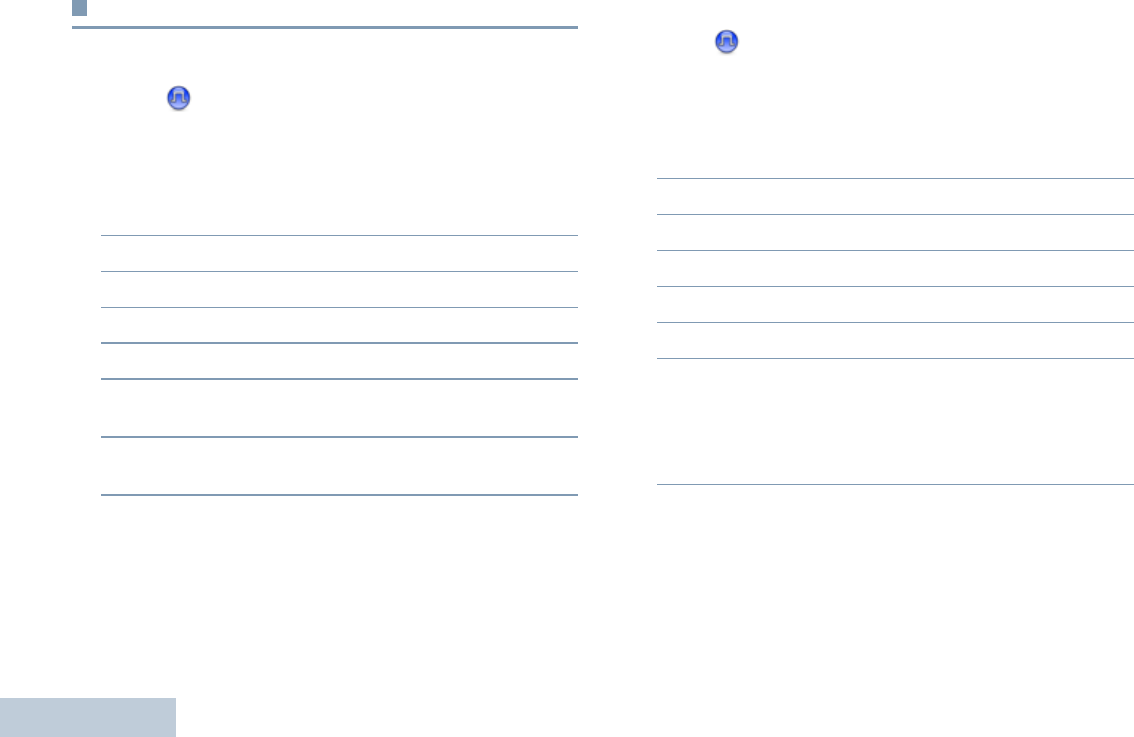
Advanced Features
English
43
Call Indicator Settings
Activating or Deactivating Call Ringers for Call
Alerts
You can select, or turn on or off ringing tones for a received Call
Alert.
Procedure:
1g to access the menu.
2f or h to Utilities and press g to select.
3f or h to Radio Settings and press g to select.
4f or h to Tones/Alerts and press g to select.
5f or h to Call Ringers and press g to select.
6f or h to Call Alert and press g to select. The
current tone is indicated by a 9.
7f or h to the required tone and press g to select. 9
appears beside selected tone.
Activating or Deactivating Call Ringers for Private
Calls
You can turn on or off the ringing tones for a received Private
Call.
Procedure:
1g to access the menu.
2f or h to Utilities and press g to select.
3f or h to Radio Settings and press g to select.
4f or h to Tones/Alerts and press g to select.
5f or h to Call Ringers and press g to select.
6f or h to Private Call.
7Press g to enable Private Call ringing tones. The display
shows 9 beside Enabled.
OR
Press g to disable Private Call ringing tones. The 9
disappears from beside Enabled.
NAG.book Page 43 Thursday, January 3, 2013 3:15 PM

Advanced Features
English
44
Activating or Deactivating Call Ringers for
Selective Call
You can select, or turn on or off ringing tones for a received
Selective Call.
Procedure:
1g to access the menu.
2f or h to Utilities and press g to select.
3f or h to Radio Settings and press g to select.
4f or h to Tones/Alerts and press g to select.
5f or h to Call Ringers and press g to select.
6f or h to Selective Call and press g to select. The
current tone is indicated by a 9.
7f or h to the required tone and press g to select. 9
appears beside selected tone.
Activating or Deactivating Call Ringers for Text
Message
You can turn on or off the ringing tones for a received Text
Message.
Procedure:
1g to access the menu.
2f or h to Utilities and press g to select.
3f or h to Radio Settings and press g to select.
4f or h to Tones/Alerts and press g to select.
5f or h to Call Ringers and press g to select.
6f or h to Messages and press g to select. The
current tone is indicated by a 9.
7f or h to the required tone and press g to select. 9
appears beside selected tone.
NAG.book Page 44 Thursday, January 3, 2013 3:15 PM

Advanced Features
English
45
Activating or Deactivating Call Ringers for
Telemetry Status with Text
You can turn on or off the alert tones for a received Telemetry
Status with Text.
Procedure:
1g to access the menu.
2f or h to Utilities and press g to select.
3f or h to Radio Settings and press g to select.
4f or h to Tones/Alerts and press g to select.
5f or h to Call Ringers and press g to select.
6f or h to Telemetry and press g to select. The
current tone is indicated by a 9.
7f or h to the required tone and press g to select. 9
appears beside selected tone.
Assigning Ring Styles
You can program your radio to sound one of ten predefined
ringing tones when receiving a Call Alert or a Text Message
from a particular contact.
Procedure:
1g to access the menu.
2f or h to Contacts and press g to select.The entries
are alphabetically sorted.
3f or h to the required alias or ID and press g to
select.
4f or h to Edit and press g to select.
5Press g until display shows Edit Ringtone menu.
6A 9 indicates the current selected tone.
7 f or h to the required tone and press g to select. 9
appears beside selected tone.
8The display shows a positive mini notice.
The radio sounds out each ring style as you navigate through
the list.
NAG.book Page 45 Thursday, January 3, 2013 3:15 PM

Advanced Features
English
46
Escalating Alarm Tone Volume
You can program your radio to continually alert you when a
radio call remains unanswered. This is done by automatically
increasing the alarm tone volume over time. This feature is
known as Escalert.
Procedure:
1g to access the menu.
2f or h to Utilities and press g to select.
3f or h to Radio Settings and press g to select.
4f or h to Tones/Alerts and press g to select.
5f or h to Escalert.
6Press g to enable Escalert. The display shows 9 beside
Enabled.
OR
Press g to disable Escalert. The 9 disappears from
beside Enabled.
Call Log Features
Your radio keeps track of all recent outgoing, answered, and
missed Private Calls. Use the call log feature to view and
manage recent calls.
You can perform the following tasks in each of your call lists:
•Store alias or ID to Contacts
•Delete
•View Details
Viewing Recent Calls
The lists are Missed, Answered, and Outgoing.
Procedure:
1g to access the menu.
2f or h to Call Log and press g to select.
3f or h to preferred list and press g to select.
4The display shows the most recent entry at the top of the
list.
5f or h to view the list.
Press the PTT button to start a Private Call with the current
selected alias or ID.
NAG.book Page 46 Thursday, January 3, 2013 3:15 PM

Advanced Features
English
47
Deleting a Call from a Call List
Procedure:
1g to access the menu.
2f or h to Call Log and press g to select.
3f or h to the required list and press g to select.
4f or h to the required alias or ID and press g to
select.
5f or h to Delete and press g to select.
6Press g to select Yes to delete the entry. The display
shows positive mini notice.
OR
f or h to No to return to the previous screen.
When you select a call list and it contains no entries, the display
shows
List Empty
, and sounds a low tone if Keypad Tones are
turned on (see Turning Keypad Tones On or Off on page 88).
Viewing Details from a Call List
Procedure:
1g to access the menu.
2f or h to Call Log and press g to select.
3f or h to the required list and press g to select.
4f or h to the required alias or ID and press g to
select.
5f or h to View Details and press g to select.
Display shows details.
NAG.book Page 47 Thursday, January 3, 2013 3:15 PM

Advanced Features
English
48
Call Alert Operation
Call Alert paging enables you to alert a specific radio user to call
you back when they are able to do so.
This feature is applicable for subscriber aliases or IDs only and
is accessible through the menu via Contacts or manual dial.
Receiving and Responding to a Call Alert
When you receive a Call Alert page, you see the notification list
listing a Call Alert with the alias or ID of the calling radio on the
display.
Procedure:
1You hear a repetitive tone. The yellow LED blinks.
2Press the PTT button while the display still shows the Call
Alert in the Notification List to respond with a Private Call.
OR
Press g to exit the Notification List. The alert is moved to
the Missed Call Log.
See Notification List on page 72 for details about the
Notification List.
See Call Log Features on page 46 for details about the Missed
Call List.
Making a Call Alert from the Contacts List
Procedure:
1g to access the menu.
2f or h to Contacts and press g to select.
3f or h to the required subscriber alias or ID and press
g to select.
4f or h to Call Alert and press g to select.
5The display shows Call Alert and the subscriber alias or
ID, indicating that the Call Alert has been sent.
6The green LED lights up when your radio is sending the Call
Alert.
7If the Call Alert acknowledgement is received, the display
shows positive mini notice.
OR
If the Call Alert acknowledgement is not received, the
display shows negative mini notice.
You can also send a Call Alert by manually dialing the
subscriber ID (see Making a Call Alert by Manual Dial on
page 102).
NAG.book Page 48 Thursday, January 3, 2013 3:15 PM

Advanced Features
English
49
Making a Call Alert with the One Touch Access
Button
Procedure:
1Press the programmed One Touch Access button to make
a Call Alert to the predefined alias or ID.
2The display shows Call Alert and the subscriber alias or
ID, indicating that the Call Alert has been sent.
3The green LED lights up when your radio is sending the Call
Alert.
4If the Call Alert acknowledgement is received, the display
shows positive mini notice.
OR
If the Call Alert acknowledgement is not received, the
display shows negative mini notice.
Emergency Operation
An Emergency Alarm is used to indicate a critical situation. You
are able to initiate an Emergency at any time on any screen
display even when there is activity on the current channel.
Your dealer can set the duration of a button press for the
programmed Emergency button, except for long press, which is
similar with all other buttons:
•Short press – Between 0.05 seconds and 0.75 seconds
•Long press – Between 1.00 second and 3.75 seconds
The Emergency button is assigned with the Emergency On/ Off
feature. Check with your dealer for the assigned operation of
the Emergency button.
If short press the Emergency button is assigned to turn on the
Emergency mode, then long press the Emergency button is
assigned to exit the Emergency mode.
If long press the Emergency button is assigned to turn on the
Emergency mode, then short press the Emergency button is
assigned to exit the Emergency mode.
Your radio supports three Emergency Alarms:
•Emergency Alarm
•Emergency Alarm with Call
•Emergency Alarm with Voice to Follow
NAG.book Page 49 Thursday, January 3, 2013 3:15 PM

Advanced Features
English
50
In addition, each alarm has the following types:
•Regular – Radio transmits an alarm signal and shows audio
and/or visual indicators.
•Silent – Radio transmits an alarm signal without any audio or
visual indicators. Radio receives calls without any sound
through the radio’s speaker, until you press the PTT button to
initiate the call.
•Silent with Voice – Radio transmits an alarm signal without
any audio or visual indicators, but allow incoming calls to
sound through the radio’s speaker.
Only one of the Emergency Alarms above can be assigned to
the programmed Emergency button or the Emergency
footswitch.
Receiving an Emergency Alarm
Procedure:
1The emergency icon appears, a tone sounds, the red LED
blinks, and the radio displays the Alarm List if there is more
than one alarm listed. The emergency caller aliases are
listed. f or h to the required alias and press g to view
more details. Press g again to view your action options.
OR
The emergency icon appears, a tone sounds, the red LED
blinks, and the radio displays the emergency caller alias
Press g to view more details. Press g again to view
your action options.
2Press e and select Yes to exit the Alarm List.
To revisit the Alarm List, press g to access the menu and
select Alarm List.
Responding to an Emergency Alarm
Procedure:
When receiving an Emergency Alarm:
1In the Alarm List, f or h to the required alias.
2If the Channel Free Indication feature is enabled, you
hear a short alert tone the moment the transmitting radio
releases the PTT button, indicating the channel is free for
you to respond.
3Press PTT button to transmit non-emergency voice to the
same group that the Emergency Alarm was targeted to. The
green LED lights up. Your radio remains in the Emergency
mode.
4Wait for the Talk Permit Tone to finish (if enabled) and speak
clearly into the microphone.
OR
Wait for the PTT Sidetone to finish (if enabled) and
speak clearly into the microphone.
NAG.book Page 50 Thursday, January 3, 2013 3:15 PM

Advanced Features
English
51
5Release the PTT button to listen. When the emergency
initiating radio responds, the green LED blinks. You see the
Group Call icon, the group alias or ID, and transmitting radio
alias or ID on your display.
6Your radio displays the Alarm List.
Emergency voice can only be transmitted by the emergency
initiating radio. All other radios (including the emergency
receiving radio) transmit non-emergency voice.
Sending an Emergency Alarm
This feature allows you to send an Emergency Alarm, a
non-voice signal, which triggers an alert indication on a group of
radios.
Procedure:
1Press the programmed Emergency On button or the
Emergency footswitch.
2The display shows Tx Alarm and the destination alias. The
green LED lights up and the Emergency icon appears.
OR
The display shows Tx Telegram and the destination
alias. The green LED lights up and the Emergency icon
appears.
3When an Emergency Alarm acknowledgment is received,
the Emergency tone sounds and the green LED blinks. The
display shows Alarm Sent.
OR
If your radio does not receive an Emergency Alarm
acknowledgement, and after all retries have been
exhausted, a tone sounds and the display shows Alarm
Failed.
4Radio exits the Emergency Alarm mode and returns to the
Home screen.
If your radio is set to Silent, it does not display any audio or
visual indicators during Emergency mode.
Sending an Emergency Alarm with Call
This feature allows you to send an Emergency Alarm to a group
of radios. Upon acknowledgement by a radio within the group,
the group of radios can communicate over a programmed
Emergency channel.
Procedure:
1Press the programmed Emergency On button or the
Emergency footswitch.
2The display shows Tx Alarm and the destination alias. The
green LED lights up and the Emergency icon appears.
OR
The display shows Tx Telegram and the destination
alias. The green LED lights up and the Emergency icon
appears.
NAG.book Page 51 Thursday, January 3, 2013 3:15 PM

Advanced Features
English
52
3When an Emergency Alarm acknowledgment is received,
the Emergency tone sounds and the green LED blinks. The
display shows Alarm Sent.
4Your radio enters the emergency call mode when the display
shows Emergency and the destination group alias.
5Press PTT button to make the call. The green LED lights up
and the group icon appears on the display.
6Wait for the Talk Permit Tone to finish (if enabled) and speak
clearly into the microphone.
OR
Wait for the PTT Sidetone to finish (if enabled) and
speak clearly into the microphone.
7Release the PTT button to listen.
When you receive a group call, the display shows the caller
alias and group alias.
8When the channel is free for you to respond, a short alert
tone sounds ( if the Channel Free Indication feature is
enabled). Press the PTT button to respond.
OR
Once your call ends, press Emergency Off button to exit
the Emergency mode.
9The radio returns to the Home screen.
If your radio is set to Silent, it does not display any audio or
visual indicators during Emergency mode, or allow any received
calls to sound through the radio’s speaker, until you press the
PTT button to initiate the call.
If your radio is set to Silent with Voice, it does not display any
audio or visual indicators during Emergency mode, but allow
incoming calls to sound through the radio’s speaker. The
indicators only appear once you press the PTT button to initiate,
or respond to, the call.
Sending an Emergency Alarm with Voice to
Follow
This feature allows you to send an Emergency Alarm to a group
of radios. Your radio’s microphone is automatically activated,
allowing you to communicate with the group of radios without
pressing the PTT button.
This activated microphone state is also known as “hot mic”.
If your radio has Emergency Cycle Mode enabled, repetitions of
hot mic and receiving period are made for a programmed
duration.
NOTE: During Emergency Cycle Mode, received calls sound
through the radio’s speaker.
NAG.book Page 52 Thursday, January 3, 2013 3:15 PM

Advanced Features
English
53
If you press the PTT button during the programmed receiving
period, you will hear a prohibit tone, indicating that you should
release the PTT button. The radio ignores the PTT press and
remains in Emergency mode.
NOTE: If you press the PTT button during hot mic, and
continue to press it after the hot mic duration expires,
the radio continues to transmit until you release the
PTT button.
Procedure:
1Press the programmed Emergency On button or the
Emergency footswitch.
2The display shows Tx Alarm and the destination alias. The
green LED lights up and the Emergency icon appears.
OR
The display shows Tx Telegram and the destination
alias. The green LED lights up and the Emergency icon
appears.
3Once the display shows Alarm Sent, speak clearly into the
microphone. When hot mic has been enabled, the radio
automatically transmits without a PTT press until the hot mic
duration expires.
While transmitting, the green LED lights up and the
Emergency icon appears.
4The radio automatically stops transmitting when:
Once the cycling duration between hot mic and receiving
calls expires, if Emergency Cycle Mode is enabled.
OR
Once the hot mic duration expires, if Emergency Cycle
Mode is disabled.
5To transmit again, press the PTT button.
OR
Press the programmed Emergency Off button to exit the
Emergency mode.
6The radio returns to the Home screen.
If your radio is set to Silent, it does not display any audio or
visual indicators during Emergency mode, or allow any received
calls to sound through the radio’s speaker, until the
programmed hot mic transmission period is over, and you press
the PTT button.
If your radio is set to Silent with Voice, it does not display any
audio or visual indicators during Emergency mode when you
are making the call with hot mic, but allow sound through the
radio’s speaker when the target radio responds after the
programmed hot mic transmission period is over. The indicators
only appear when you press the PTT button.
NOTE: If the Emergency Alarm request fails, the radio does
not retry to send the request, and enters the hot mic
state directly.
NAG.book Page 53 Thursday, January 3, 2013 3:15 PM

Advanced Features
English
54
Reinitiating an Emergency Mode
NOTE: This feature is only applicable to the radio sending the
Emergency Alarm.
There are two instances where this can happen:
•You change the channel while the radio is in Emergency
mode. This exits the Emergency mode. If Emergency Alarm is
enabled on this new channel, the radio reinitiates Emergency.
•You press the programmed Emergency On button during an
Emergency initiation/transmission state. This causes the
radio to exit this state, and to reinitiate Emergency.
Exiting Emergency Mode
NOTE: This feature is only applicable to the radio sending the
Emergency Alarm.
Your radio exits Emergency mode when one of the following
occurs:
•Emergency Alarm acknowledgement is received (for
Emergency Alarm only), OR
•An Emergency Exit Telegram is received, OR
•All retries to send the alarm have been exhausted, OR
•The Emergency Off button is pressed, OR
•Turn the radio off and then power it on again if your radio has
been programmed to remain on the Emergency Revert
channel even after acknowledgement is received.
NOTE: If your radio is powered off, it exits the Emergency
mode. The radio does not reinitiate the Emergency
mode automatically when it is turned on again.
If you change channels when your radio is in
Emergency mode to a channel that has no emergency
system configured, No Emergency is shown on your
display.
NAG.book Page 54 Thursday, January 3, 2013 3:15 PM

Advanced Features
English
55
Text Messaging Features
Your radio is able to receive data, for example a text message,
from another radio or an e-mail application.
Sending a Quick Text Message
Your radio supports a maximum of 50 Quick Text messages as
programmed by your dealer.
NOTE: While Quick Text messages are programmed, you can
edit each message before sending it. Only available
with a keypad microphone (see Editing a Quick Reply
Message on page 105).
Procedure:
Press the programmed Text Message button and proceed to
Step 3.
OR
Follow the procedure below.
1g to access the menu.
2f or h to Messages and press g to select.
3f or h to Quick Text and press g to select.
4f or h to the required Quick Text and press g to
select.
5f or h to the required alias or ID and press g to
select.
6The display shows transitional mini notice, confirming your
message is being sent.
7If the message is sent, a tone sounds and the display shows
positive mini notice.
OR
If the message is not sent, a low tone sounds and the
display shows negative mini notice.
If the text message fails to send, the radio returns you to the
Resend
option screen (see Managing Fail-to-Send Text
Messages on page 57).
Sending a Quick Text Message with the One Touch
Access Button
1Press the programmed One Touch Access button to send
a predefined Quick Text message to a predefined alias or
ID.
2The display shows transitional mini notice, confirming your
message is being sent.
3If the message is sent, a tone sounds and the display shows
positive mini notice.
OR
If the message is not sent, a low tone sounds and the
display shows negative mini notice.
NAG.book Page 55 Thursday, January 3, 2013 3:15 PM

Advanced Features
English
56
If the text message fails to send, the radio returns you to the
Resend
option screen (see Managing Fail-to-Send Text
Messages on page 57).
Managing Text Messages in the Drafts Folder
The Drafts folder stores a maximum of ten (10) last saved
messages. When the folder is full, the next saved text message
automatically replaces the oldest text message in the folder.
See Accessing the Drafts Folder on page 106 for more
information.
NOTE: You can edit a saved text message before sending it.
Only available with a keypad microphone (see Editing
and Sending a Saved Text Message on page 106).
Long press e at any time to return to the Home
screen.
Viewing a Saved Text Message
Procedure:
Press the programmed Text Message button and proceed to
Step 3.
OR
Follow the procedure below.
1g to access the menu.
2f or h to Messages and press g to select.
3f or h to Drafts and press g to select.
4f or h to the required message and press g to select.
Deleting a Saved Text Message from Drafts
Procedure:
Press the programmed Text Message button and proceed to
Step 3.
OR
Follow the procedure below.
1g to access the menu.
2f or h to Messages and press g to select.
3f or h to Drafts and press g to select.
4f or h to the required message and press g to select.
5Press g again while viewing the message.
6f or h to Delete and press g to delete the text
message.
NAG.book Page 56 Thursday, January 3, 2013 3:15 PM

Advanced Features
English
57
Managing Fail-to-Send Text Messages
You can select one of the following options while at the Resend
option screen:
•Resend
•Forward
•Edit (Only available with a keypad microphone – see Editing
a Text Message on page 107 for more information)
NOTE: If the channel type (i.e. conventional digital or Capacity
Plus or Linked Capacity Plus) is not a match, you can
only edit and forward a Fail-to-Send message.
Resending a Text Message
Procedure:
1Press g to resend the same message to the same
subscriber/group alias or ID.
2If the message is sent successfully, a tone sounds and the
display shows positive mini notice.
OR
If the message cannot be sent, the display shows negative
mini notice.
Forwarding a Text Message
Select Forward to send the message to another subscriber/
group alias or ID.
Procedure:
1f or h to Forward and press g to select.
2f or h to the required alias or ID and press g to
select.
3The display shows transitional mini notice, confirming your
message is being sent.
4If the message is sent, a tone sounds and the display shows
positive mini notice.
OR
If the message is not sent, a low tone sounds and the
display shows negative mini notice.
You can also manually select a target radio address (see
Forwarding a Text Message by Manual Dial on page 107).
NAG.book Page 57 Thursday, January 3, 2013 3:15 PM

Advanced Features
English
58
Managing Sent Text Messages
Once a message is sent to another radio, it is saved in Sent
Items. The most recent sent text message is always added to
the top of the Sent Items list.
The Sent Items folder is capable of storing a maximum of
thirty (30) last sent messages. When the folder is full, the next
sent text message automatically replaces the oldest text
message in the folder.
NOTE: Long press e at any time to return to the Home
screen.
Viewing a Sent Text Message
Procedure:
Press the programmed Text Message button and proceed to
Step 3.
OR
Follow the procedure below.
1g to access the menu.
2f or h to Messages and press g to select.
3f or h to Sent Items and press g to select.
4f or h to the required message and press g to select.
A subject line may be shown if the message is from an
e-mail application.
The icon beside each message indicates the status of the
message (see Sent Item Icons on page 16).
Sending a Sent Text Message
You can select one of the following options while viewing a sent
text message:
•Resend
•Forward
•Edit
•Delete
NOTE: If the channel type (i.e. conventional digital or Capacity
Plus or Linked Capacity Plus) is not a match, you can
only edit, forward, or delete a Sent message.
Procedure:
1Press g again while viewing the message.
2f or h to Resend and press g to select.
3The display shows transitional mini notice, confirming that
the same message is being sent to the same target radio.
4If the message is sent, a tone sounds and the display shows
positive mini notice.
OR
If the message is not sent, a low tone sounds and the
display shows negative mini notice.
NAG.book Page 58 Thursday, January 3, 2013 3:15 PM

Advanced Features
English
59
If the text message fails to send, the radio returns you to the
Resend
option screen. Press g to resend the message to the
same subscriber/group alias or ID.
NOTE: Changing the volume, and pressing any button, except
for g, f, or h, returns you to the message.
The radio exits the Resend option screen if you press
the PTT button to initiate a Private or Group Call, or to
respond to a Group Call. It also exits the screen when
the radio receives a text or telemetry message, an
emergency call or alarm, or a call alert.
The display returns to the Resend option screen if you
press the PTT button to respond to a Private Call
(except if the radio is displaying the Missed Call
screen), and at the end of an All Call.
Press f or h to access the
Forward
,
Edit
, or
Delete
option screen:
•Select
Forward
to send the selected text message to another
target radio (see Forwarding a Text Message on page 57).
You can also manually select a target radio address using a
keypad microphone (see Forwarding a Text Message by
Manual Dial on page 107).
•Select
Edit
to edit the selected text message before sending
it (see Editing a Text Message on page 107). Only available
with a keypad microphone.
•Select
Delete
to delete the text message.
NOTE: If you exit the message sending screen while the
message is being sent, the radio updates the status of
the message in the Sent Items folder without providing
any indication in the display or via sound.
If the radio changes mode or powers down before the
status of the message in Sent Items is updated, the
radio cannot complete any In-Progress messages and
automatically marks it with a Send Failed icon.
The radio supports a maximum of five (5) In-Progress
messages at one time. During this period, the radio
cannot send any new message and automatically
marks it with a Send Failed icon.
Deleting All Sent Text Messages from Sent Items
Procedure:
Press the programmed Text Message button and proceed to
Step 3.
OR
Follow the procedure below.
1g to access the menu.
2f or h to Messages and press g to select.
3f or h to Sent Items and press g to select.
4f or h to Delete All and press g to select.
NAG.book Page 59 Thursday, January 3, 2013 3:15 PM

Advanced Features
English
60
5 f or h to Yes and press g to select. The display
shows positive mini notice
OR
f or h to No and press g to return to the previous
screen.
When you select Sent Items and it contains no text messages,
the display shows
List Empty
, and sounds a low tone if
Keypad Tones are turned on (see Turning Keypad Tones On
or Off on page 88).
Receiving a Text Message
When your radio receives a message, the display shows the
Notification List with the alias or ID of the sender and the
message icon.
You can select one of the following options when receiving a
text message:
•Read
•Read Later
•Delete
NOTE: The radio exits the Text Message alert screen and sets
up a Private or Group Call to the sender of the
message if the PTT button is pressed when the radio is
displaying the alert screen.
Reading a Text Message
Procedure:
1f or h to Read and press g to select.
2Selected message in the Inbox opens.
A subject line may be shown if the message is from an
e-mail application.
3Press e to return to the Inbox.
OR
Press g to reply, forward, or delete the text message.
Press f or h to access the
Read Later
or
Delete
option
screen:
•Select
Read Later
to return to the screen you were on prior
to receiving the text message.
•Select
Delete
to delete the text message.
NAG.book Page 60 Thursday, January 3, 2013 3:15 PM

Advanced Features
English
61
Managing Received Text Messages
Use the Inbox to manage your text messages. The Inbox is
capable of storing a maximum of 30 messages.
Your radio supports the following options for text messages:
•Reply (via Quick Text)
•Forward
•Delete
•Delete All
NOTE: If the channel type (i.e. conventional digital or Capacity
Plus or Linked Capacity Plus) is not a match, you can
only forward, delete, or delete all Received messages.
Text messages in the Inbox are sorted according to the
most recently received.
NOTE: Long press e at any time to return to the Home
screen.
Viewing a Text Message from the Inbox
Procedure:
1g to access the menu.
2f or h to Messages and press g to select.
3f or h to Inbox and press g to select.
4f or h to view the messages.
A subject line may be shown if the message is from an
e-mail application.
5Press g to select the current message, and press g
again to reply, forward, or delete that message.
OR
Long press e to return to the Home screen.
Viewing a Telemetry Status Text Message from the
Inbox
Procedure:
1g to access the menu.
2f or h to Messages and press g to select.
3f or h to Inbox and press g to select.
4f or h to the required message and press g to select.
NAG.book Page 61 Thursday, January 3, 2013 3:15 PM

Advanced Features
English
62
5The display shows Telemetry: <Status Text Message>.
6Long press e to return to the Home screen.
You cannot reply to a Telemetry Status text message.
Replying to a Text Message with Quick Text
Procedure:
Press the programmed Text Message button and proceed to
Step 3.
OR
Follow the procedure below.
1g to access the menu.
2f or h to Messages and press g to select.
3f or h to Inbox and press g to select.
4f or h to the required message and press g to select.
A subject line may be shown if the message is from an
e-mail application.
5Press g once more to access the sub-menu.
6f or h to Reply and press g to select.
7f or h to Quick Reply and press g to select.
8f or h to the required message and press g to select.
9The display shows transitional mini notice, confirming your
message is being sent.
10 If the message is sent successfully, a tone sounds and the
display shows positive mini notice.
OR
If the message cannot be sent, the display shows negative
mini notice.
If the text message fails to send, the radio returns you to the
Resend
option screen (see Managing Fail-to-Send Text
Messages on page 57).
NOTE: If you are using a keypad microphone, you can also
write and send a new message (see Writing and
Sending a Text Message on page 103) or modify a
Quick Text message before sending it (see Editing a
Quick Reply Message on page 105).
NAG.book Page 62 Thursday, January 3, 2013 3:15 PM

Advanced Features
English
63
Deleting a Text Message from the Inbox
Procedure:
Press the programmed Text Message button and proceed to
Step 3.
OR
Follow the procedure below.
1g to access the menu.
2f or h to Messages and press g to select.
3f or h to Inbox and press g to select.
4f or h to the required message and press g to select.
A subject line may be shown if the message is from an
e-mail application.
5Press g once more to access the sub-menu.
6f or h to Delete and press g to select.
7f or h to Yes and press g to select.
8The display shows positive mini notice.
9The screen returns to the Inbox.
Deleting All Text Messages from the Inbox
Procedure:
Press the programmed Text Message button and proceed to
Step 3.
OR
Follow the procedure below.
1g to access the menu.
2f or h to Messages and press g to select.
3f or h to Inbox and press g to select.
4f or h to Delete All and press g to select.
5f or h to Yes and press g to select.
6The display shows positive mini notice.
When you select the Inbox and it contains no text messages,
the display shows
List Empty
, and sounds a low tone if
Keypad Tones are turned on (see Turning Keypad Tones On
or Off on page 88).
NOTE: Additional text messaging features are available with a
keypad-enabled microphone. Refer to Text Messaging
on page 103 for more details.
NAG.book Page 63 Thursday, January 3, 2013 3:15 PM
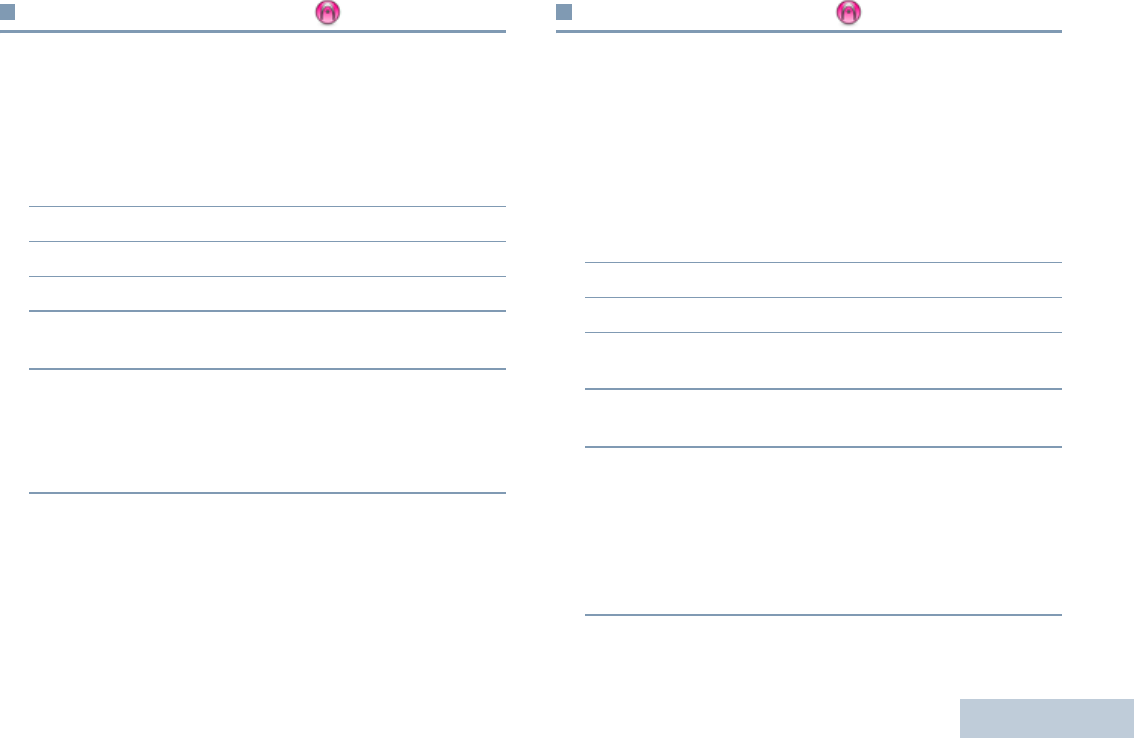
Advanced Features
English
64
Analog Message Encode
Your radio is able to send preprogrammed messages from the
Message list to a radio alias or to the dispatcher.
Sending MDC Message Encode to Dispatcher
Procedure:
1g to access the menu.
2f or h to Message and press g to select.
3f or h to Quick Text and press g to select.
4f or h to the required message. Press g to send.
5 The display shows transitional mini notice, confirming your
message is being sent.
6If the message is sent, a tone sounds and the display shows
positive mini notice.
OR
If the message is not sent, a low tone sounds and the
display shows negative mini notice.
Analog Status Update
Your radio is able to send preprogrammed messages from the
Status List indicating your current activity to the dispatcher.
The last acknowledged message is kept at the top of the Status
List. The other messages are arranged in alphanumeric order.
Sending Status Update to Predefined Contact
Procedure:
1g to access the menu.
2f or h to Status and press g to select.
3f or h to the required status. Press g to select.
4f or h to Set as Default. Press g to send the
status update.
5The display shows transitional mini notice, confirming your
status update is being sent.
6If the status update is acknowledged, a tone sounds and the
display shows positive mini notice. A 9 appears beside the
acknowledged status.
OR
If the status update is not acknowledged, a low tone sounds
and the display shows negative mini notice. A 9 remains
beside the previous status.
NAG.book Page 64 Thursday, January 3, 2013 3:15 PM

Advanced Features
English
65
Privacy
If enabled, this feature helps to prevent eavesdropping by
unauthorized users on a channel by the use of a software-
based scrambling solution. The signaling and user identification
portions of a transmission are not scrambled.
Your radio must have privacy enabled on the channel to send a
privacy-enabled transmission, although this is not a necessary
requirement for receiving a transmission. While on a privacy-
enabled channel, the radio is still able to receive clear
(unscrambled) transmissions.
Your radio supports two types of privacy:
•Basic Privacy
•Enhanced Privacy.
Only ONE of the privacy types above can be assigned to the
radio.
To unscramble a privacy-enabled call or data transmission, your
radio must be programmed to have the same Privacy Key (for
Basic Privacy), OR the same Key Value and Key ID (for
Enhanced Privacy) as the transmitting radio.
If your radio receives a scrambled call that is of a different
Privacy Key, OR a different Key Value and Key ID, you will
either hear a garbled transmission (Basic Privacy) or nothing at
all (Enhanced Privacy).
The green LED lights up while the radio is transmitting and
double blinks when the radio is receiving an ongoing privacy-
enabled transmission.
NOTE: Some radio models may not offer this Privacy feature.
Check with your dealer or system administrator for
more information.
Procedure:
Press the programmed Privacy button to toggle privacy on or
off.
OR
Follow the procedure below.
1g to access the menu.
2f or h to Utilities and press g to select.
3f or h to Radio Settings and press g to select.
4f or h to Privacy.
5Press g to enable Privacy. The display shows 9 beside
Enabled.
OR
Press g to disable Privacy. The 9 disappears from beside
Enabled.
If the radio has a privacy type assigned, the secure or unsecure
icon appears on the status bar, except when the radio is
sending or receiving an Emergency call or alarm.
NAG.book Page 65 Thursday, January 3, 2013 3:15 PM

Advanced Features
English
66
Analog Scrambling
Analog Scrambling is an analog-only feature designed to
prevent eavesdropping by unauthorized users on a channel by
the use of a software-based scrambling solution. The signaling
and user identification portions of a transmission are not
scrambled.
Your radio must have analog scrambling enabled on the
channel to send and receive an analog scrambling-enabled
transmission. While on an analog scrambling-enabled channel,
the radio is NOT able to receive clear (unscrambled)
transmissions.
Your radio supports TWO analog scrambling codes that can be
toggled via the programmable button.
Procedure:
Press the programmed Analog Scrambling button to enable or
disable this function.
Multi-Site Controls
These features are applicable when your current radio channel
is part of an IP Site Connect or Linked Capacity Plus
configuration.
See IP Site Connect on page 10 and Linked Capacity Plus on
page 11 for more details about these configurations.
Starting an Automatic Site Search
NOTE: The radio only scans for a new site if the current signal
is weak or when the radio is unable to detect any signal
from the current site. If the RSSI value is strong, the
radio remains on the current site.
Procedure:
Press the programmed Site Lock On/Off button.
1A tone sounds and the display shows Site Unlocked.
2The yellow LED blinks rapidly when the radio is actively
searching for a new site, and turns off once the radio locks
on to a site.
3The display shows the channel alias and the site roaming
icon appears.
OR
NAG.book Page 66 Thursday, January 3, 2013 3:15 PM

Advanced Features
English
67
Procedure:
Use the menu.
1g to access the menu.
2f or h to Utilities and press g to select.
3f or h to Radio Settings and press g to select.
4f or h to Site Roaming and press g to select.
5f or h to Unlock Site and press g to select. A tone
sounds and the display shows Site Unlocked.
6The radio returns to the Home screen. The display shows
the channel alias and the site roaming icon appears.
7The yellow LED blinks rapidly when the radio is actively
searching for a new site, and turns off once the radio locks
on to a site.
The radio also performs an automatic site search (site is
unlocked) during a PTT button press or data transmission if the
current channel, a multi-site channel with an attached roam list,
is out of range.
Stopping an Automatic Site Search
When the radio is actively searching for a new site:
Procedure:
Press the programmed Site Lock On/Off button.
1A tone sounds and the display shows Site Locked.
2The LED turns off and the display shows the channel alias.
OR
Procedure:
Use the menu.
1g to access the menu.
2f or h to Utilities and press g to select.
3f or h to Radio Settings and press g to select.
4f or h to Site Roaming and press g to select.
5f or h to Lock Site State.
6Press g to lock site. The display shows 9 beside Enabled.
OR
Press g to unlock site. The 9 disappears from beside
Enabled.
7The LED turns off and the radio returns to the Home screen.
The display shows the channel alias.
NAG.book Page 67 Thursday, January 3, 2013 3:15 PM
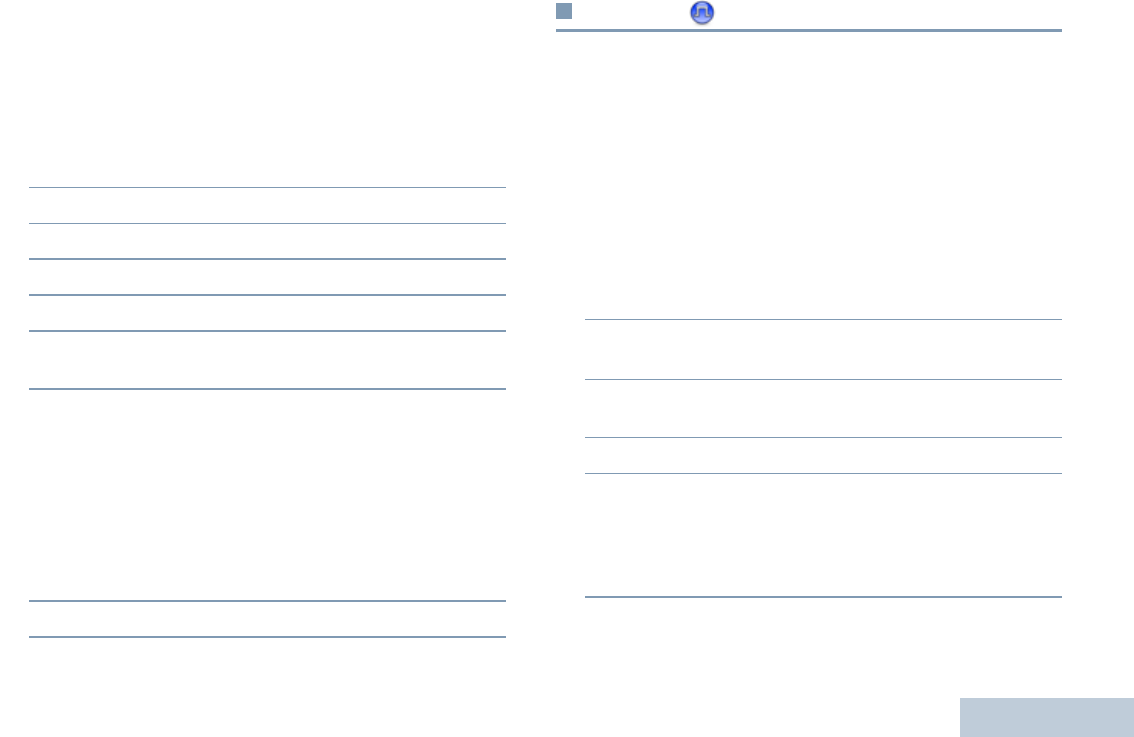
Advanced Features
English
68
Starting a Manual Site Search
Procedure:
Press the programmed Manual Site Roam button and proceed
to Step 6.
OR
Follow the procedure below.
1g to access the menu.
2f or h to Utilities and press g to select.
3f or h to Radio Settings and press g to select.
4f or h to Site Roaming and press g to select.
5f or h to Active Search and press g to select.
6A tone sounds and the display shows Finding Site.
The green LED blinks.
7If a new site is found, a tone sounds and the LED turns off.
The display shows Site <Alias> Found.
OR
If there is no available site within range, a tone sounds and
the LED turns off. The display shows Out of Range.
OR
If a new site is within range, but the radio is unable to
connect to it, a tone sounds and the LED turns off. The
display shows Channel Busy.
8The radio returns to the Home screen.
Security
You can enable or disable any radio in the system. For example,
you might want to disable a stolen radio, to prevent the thief
from using it, and enable that radio, when it is recovered.
NOTE: Performing Radio Disable and Enable is limited to
radios with these functions enabled.
Radio Disable
Procedure:
Use the programmed Radio Disable button.
1Press the programmed Radio Disable button.
2f or h to the required subscriber alias or ID and press
g to select.
3 The display shows transitional mini notice, indicating the
request is in progress. The green LED blinks.
4Wait for acknowledgment.
5If successful, a positive indicator tone sounds and the
display shows positive mini notice.
OR
If unsuccessful, a negative indicator tone sounds and the
display shows negative mini notice.
OR
NAG.book Page 68 Thursday, January 3, 2013 3:15 PM

Advanced Features
English
69
Procedure:
Use the menu.
1g to access the menu.
2f or h to Contacts and press g to select. The entries
are alphabetically sorted.
3f or h to the required subscriber alias or ID and press
g to select.
4f or h to Radio Disable and press g to select.
5The display shows transitional mini notice, indicating the
request is in progress. The green LED blinks.
6Wait for acknowledgment.
7If successful, a positive indicator tone sounds and the
display shows positive mini notice.
OR
If unsuccessful, a negative indicator tone sounds and the
display shows negative mini notice.
Do not press e during the Radio Disable operation as you will
not get an acknowledgement message.
You can also access this feature using manual dial (see Radio
Disable via Manual Dial on page 108).
Radio Enable
Procedure:
Use the programmed Radio Enable button.
1Press the programmed Radio Enable button.
2f or h to the required subscriber alias or ID and press
g to select.
3The display shows Radio Enable and the subscriber alias
or ID. The green LED lights up.
4Wait for acknowledgment.
5If successful, the radio sounds a positive indicator tone and
the display shows positive mini notice.
OR
If unsuccessful, the radio sounds a negative indicator tone
and the display shows negative mini notice.
OR
Procedure:
Use the menu.
1g to access the menu.
2f or h to Contacts and press g to select. The entries
are alphabetically sorted.
NAG.book Page 69 Thursday, January 3, 2013 3:15 PM

Advanced Features
English
70
3f or h to the required subscriber alias or ID and press
g to select.
4f or h to Radio Enable and press g to select. The
green LED blinks.
5The display shows Radio Enable and the subscriber alias
or ID. The green LED lights up.
6Wait for acknowledgment.
7If successful, a tone sounds and the display shows Radio
Enable Successful.
OR
If not successful, a tone sounds and the display shows
Radio Enable Failed.
Do not press e during the Radio Enable operation as you will
not get an acknowledgement message.
You can also access this feature using manual dial (see Radio
Enable via Manual Dial on page 109).
Lone Worker
This feature prompts an emergency to be raised if there is no
user activity, such as any radio button press or activation of the
channel selector, for a predefined time.
Following no user activity for a programmed duration, the radio
pre-warns the user via an audio indicator once the inactivity
timer expires.
If there is still no acknowledgment by the user before the
predefined reminder timer expires, the radio initiates an
Emergency Alarm.
Only one of the following Emergency Alarms is assigned to this
feature:
•Emergency Alarm
•Emergency Alarm with Call
•Emergency Alarm with Voice to Follow
The radio remains in the emergency state allowing voice
messages to proceed until action is taken. See Emergency
Operation on page 49 on ways to exit Emergency.
NOTE: This feature is limited to radios with this function
enabled. Check with your dealer or system
administrator for more information.
NAG.book Page 70 Thursday, January 3, 2013 3:15 PM

Advanced Features
English
71
Third Party Peripherals Connection
Modes
You can select one of the third party peripherals connection
modes:
•Motorola
•PC and Audio
•Data Accessory
•Telemetry
•Generic
Procedure:
1g to access the menu.
2f or h to Utilities and press g to select.
3f or h to Radio Settings and press g to select.
4f or h to Cable Type and press g to select.
5f or h to the required connection mode and press g
to select.
6The display shows the selected connection mode.
7The screen automatically returns to the previous menu.
NOTE: You cannot change the connection mode while the
cable of the third party peripheral is still attached to
your radio.
NAG.book Page 71 Thursday, January 3, 2013 3:15 PM

Advanced Features
English
72
Notification List
Your radio has a Notification List that collects all your “unread”
events on the channel, such as unread text messages,
telegrams, telemetry messages, missed calls, and call alerts.
The Notification icon appears on the status bar when the
Notification List has one or more events.
The list supports a maximum of forty (40) unread events. When
it is full, the next event automatically replaces the oldest event.
After the events are read, they are removed from the
Notification List.
NOTE: Your radio suspends Scan when the Notification List is
displayed. Scanning resumes when your radio exits the
Notification List. Press e to exit the Notification List
or wait for the menu timer to expire.
Accessing the Notification List
Procedure:
Press the programmed Notifications button.
OR
Follow the procedure below.
1g to access the menu.
2f or h to Notification and press g to select.
3f or h to the required event and press g to select.
Long press e to return to the Home screen.
NAG.book Page 72 Thursday, January 3, 2013 3:15 PM

Advanced Features
English
73
Auto-Range Transponder System (ARTS)
ARTS is an analog-only feature designed to inform you when
your radio is out-of-range of other ARTS-equipped radios.
ARTS-equipped radios transmit or receive signals periodically
to confirm that they are within range of each other. Your dealer
can program your radio to transmit or receive the ARTS signal.
Your radio provides indications of states as follows:
•First-Time Alert – A tone sounds and the display shows
In Range after the channel alias.
•ARTS-in-Range Alert – A tone sounds, if programmed, and
the display shows In Range after the channel alias.
ARTS-Out-of-Range Alert – A tone sounds, the LED rapidly
blinks red, and the display alternates between Out of Range
and the home screen.
Over-the-Air Programming (OTAP)
Your radio can be updated by your dealer remotely, via OTAP,
without needing to be physically connected. Additionally, some
settings can also be configured via OTAP.
While undergoing OTAP, the LED blinks green.
NOTE: When the radio is receiving high volume data, the High
Volume Data icon appears and channel is busy. A PTT
button press at this time may cause a negative tone to
sound.
Once the programming is complete, depending on your radio’s
configuration:
•A tone sounds, the display shows Updating Restarting,
and your radio restarts (powers off and on again).
•Select between Restart Now or Postpone. Selecting
Postpone allows your radio to return to the previous display,
with an OTAP Timer icon visible, for a period of time before
the automatic restart occurs.
Upon power up after the automatic restart occurs, the display
shows Sw Update Completed if the OTAP update is successful
or Sw Update Failed if the OTAP update is unsuccessful.
See Software Update on page 85 for your updated software
version.
NAG.book Page 73 Thursday, January 3, 2013 3:15 PM

Advanced Features
English
74
Utilities
Turning the Radio Tones/Alerts On or Off
You can enable and disable all radio tones and alerts (except for
the incoming Emergency alert tone) if needed.
Procedure:
Press the programmed All Tones/Alerts button to toggle all
tones on or off.
OR
Follow the procedure below.
1g to access the menu.
2f or h to Utilities and press g to select.
3f or h to Radio Settings and press g to select.
4f or h to Tones/Alerts and press g to select.
5f or h to All Tones and press g to select.
6Press g to enable all tones. The display shows 9 beside
Enabled.
OR
Press g to disable all tones. The 9 disappears from
beside Enabled.
Setting the Tone Alert Volume Offset Level
You can adjust the Tone Alert Volume Offset level if needed.
This feature adjusts the volume of the tones/alerts, allowing it to
be higher or lower than the voice volume.
Procedure:
1g to access the menu.
2f or h to Utilities and press g to select.
3f or h to Radio Settings and press g to select.
4f or h to Tones/Alerts and press g to select.
5f or h to Vol. Offset and press g to select.
6f or h to the required volume value. The radio sounds a
feedback tone with each corresponding volume value.
7Press g to keep the required displayed volume value.
OR
Repeat Step 6 to select another volume value.
OR
e to exit without changing the current volume offset
settings.
NAG.book Page 74 Thursday, January 3, 2013 3:15 PM

Advanced Features
English
75
Turning the Talk Permit Tone On or Off
You can enable and disable the Talk Permit Tone if needed.
Procedure:
1g to access the menu.
2f or h to Utilities and press g to select.
3f or h to Radio Settings and press g to select.
4f or h to Tones/Alerts and press g to select.
5f or h to Talk Permit and press g to select.
6Press g to enable Talk Permit Tone. The display shows 9
beside Enabled.
OR
Press g to disable Talk Permit Tone. The 9 disappears
from beside Enabled.
Turning the Power Up Alert Tone On or Off
You can enable and disable the Power Up Alert Tone if needed.
Procedure:
1g to access the menu.
2f or h to Utilities and press g to select.
3f or h to Radio Settings and press g to select.
4f or h to Tones/Alerts and press g to select.
5f or h to Power Up and press g to select.
6Press g to enable Power Up Tone. The display shows 9
beside Enabled.
OR
Press g to disable Power Up Tone. The 9 disappears
from beside Enabled
Setting the Text Message Alert Tone
You can customize your radio’s text message alert tone to
Momentary or Repetitive for each entry in the Contacts list.
Procedure:
1g to access the menu.
2f or h to Contacts and press g to select.
3f or h to the required subscriber alias or ID and press
g to select.
4f or h to Message Alert and press g to select.
5The display shows Momentary and Repetitive. f or h
to the required setting and press g to enable. 9 appears
besides selected setting.
NAG.book Page 75 Thursday, January 3, 2013 3:15 PM

Advanced Features
English
76
Setting the Power Level
You can customize your radio’s power setting to high or low for
each channel.
Settings: High enables communication with radios located at
a considerable distance from you. Low enables communication
with radios in closer proximity.
Procedure:
Press the programmed Power Level button to toggle transmit
power level between high and low.
OR
Follow the procedure below.
1g to access the menu.
2f or h to Utilities and press g to select.
3f or h to Radio Settings and press g to select.
4f or h to Power and press g to select.
5f or h to the required setting and press g to select. 9
appears beside selected setting.
6Screen returns to the previous menu.
Long press e to return to the Home screen. The power level
icon is visible.
Changing the Display Mode
You can change radio’s display mode between Day or Night, as
needed. This affects the color palette of the display.
Procedure:
Press the programmed Display Mode button to toggle the
display mode settings.
OR
Follow the procedure below.
1g to access the menu.
2f or h to Utilities and press g to select.
3f or h to Radio Settings and press g to select.
4f or h to Day/Night and press g to select.
5The display shows Day Mode and Night Mode. f or h
to the required setting and press g to enable. 9 appears
beside selected setting.
NAG.book Page 76 Thursday, January 3, 2013 3:15 PM

Advanced Features
English
77
Adjusting the Display Brightness
You can adjust radio’s display brightness as needed.
Procedure:
Press the programmed Brightness button and proceed to
Step 5.
OR
Follow the procedure below.
1g to access the menu.
2f or h to Utilities and press g to select.
3f or h to Radio Settings and press g to select.
4f or h to Brightness and press g to select.
5The display shows a progress bar. Decrease display
brightness by pressing h or increase the display
brightness by pressing f. Press g to confirm your entry.
Turning Horns/Lights On or Off
Your radio is able to notify you of an incoming call via the horns
and lights feature. When activated, an incoming call sounds
your vehicle's horn and turns on its lights.
This feature needs to be installed through your radio’s rear
accessory connector by your dealer.
Procedure:
Press the programmed Horns/Lights button to toggle horns
and lights feature on or off.
OR
Follow the procedure below.
1g to access the menu.
2f or h to Utilities and press g to select.
3f or h to Radio Settings and press g to select.
4f or h to Horns/Lights and press g to select.
5Press g to enable Horns/Lights. The display shows 9
beside Enabled.
OR
Press g to disable Horns/Lights. The 9 disappears from
beside Enabled
Turning the Public Address System On or Off
You can enable and disable the radio’s internal public address
(PA) system.
Procedure:
Press the programmed PA On/Off button to toggle the feature
on or off.
NAG.book Page 77 Thursday, January 3, 2013 3:15 PM

Advanced Features
English
78
Turning the External Public Address System On
or Off
You can enable or disable the audio routing between the
connected public address (PA) loudspeaker amplifier and the
radio’s internal public address (PA) system.
Procedure:
Press the programmed Ext PA On/Off button to toggle the
feature on or off.
Setting the Squelch Level
You can adjust your radio's squelch level to filter out unwanted
calls with low signal strength or channels that have a higher
than normal background noise.
Settings: Normal is the default. Tight filters out (unwanted)
calls and/or background noise. However, calls from remote
locations may also be filtered out.
Procedure:
Press the programmed Squelch button to toggle squelch level
between normal and tight.
OR
Follow the procedure below.
1g to access the menu.
2f or h to Utilities and press g to select.
3f or h to Radio Settings and press g to select.
4f or h to Squelch and press g to select.
5The display shows Tight and Normal. f or h to the
required setting and press g to enable. 9 appears
besides selected setting.
6Screen returns to the previous menu.
Turning the Introduction Screen On or Off
You can enable and disable the Introduction Screen if needed.
Procedure:
1g to access the menu.
2f or h to Utilities and press g to select.
3f or h to Radio Settings and press g to select.
4f or h to Intro Screen and press g to select.
5Press g to enable Introduction Screen. The display shows
9 beside Enabled.
OR
Press g to disable Introduction Screen. The 9 disappears
from beside Enabled.
NAG.book Page 78 Thursday, January 3, 2013 3:15 PM

Advanced Features
English
79
Turning the LED Indicators On or Off
You can enable and disable the LED Indicators if needed.
Procedure:
1g to access the menu.
2f or h to Utilities and press g to select.
3f or h to Radio Settings and press g to select.
4f or h to LED Indicator and press g to select.
5Press g to enable LED indicator. The display shows 9
beside Enabled.
OR
Press g to disable LED indicator. The 9 disappears from
beside Enabled.
Setting Dual Knob Operation Preference
Your radio has a dual-purpose Volume/Channel Knob.
Disabling the dual-purpose option sets the knob to work as a
Volume Knob only.
1g to access the menu.
2f or h to Utilities and press g to select.
3f or h to Radio Settings and press g to select.
4f or h to Dual Knob and press g to select.
5The display shows Volume Only and Volume & Ch.
f or h to the required setting and press g to enable.
9 appears besides selected setting.
6Screen returns to the previous menu.
Language
You can set your radio display to be in your required language.
Procedure:
1g to access the menu.
2f or h to Utilities and press g to select.
3f or h to Language and press g to select.
4f or h to the required language and press g to
enable. 9 appears beside selected language.
NAG.book Page 79 Thursday, January 3, 2013 3:15 PM

Advanced Features
English
80
Turning the Voice Operating Transmission (VOX)
Feature On or Off
This feature allows you to initiate a hands-free voice activated
call on a programmed channel. The radio automatically
transmits, for a programmed period, whenever the microphone
on the VOX-capable accessory detects voice.
NOTE: You may need to turn off the radio and power it up
again after detaching the VOX-capable microphone
from it to allow the radio to switch to another valid
accessory.
Pressing the PTT button during radio operation disables VOX.
To re-enable VOX, do one of the following:
•Turn the radio off and power it on again, OR
•Change the channel via the Scroll Up/Down buttons, OR
•Change the channel via the Volume/Channel Knob, OR
•Follow the procedure below.
NOTE: Turning this feature on or off is limited to radios with
this function enabled. Check with your dealer or system
administrator for more information.
Procedure:
Press the programmed VOX button to toggle the feature on or
off.
OR
Follow the procedure below.
1g to access the menu.
2f or h to Utilities and press g to select.
3f or h to Radio Settings and press g to select.
4f or h to VOX and press g to select.
5Press g to enable VOX. The display shows 9 beside
Enabled.
OR
Press g to disable VOX. The 9 disappears from beside
Enabled.
If the Talk Permit Tone feature is enabled (see Turning the Talk
Permit Tone On or Off on page 75), use a trigger word to
initiate the call. Wait for the Talk Permit Tone to finish before
speaking clearly into the microphone.
NAG.book Page 80 Thursday, January 3, 2013 3:15 PM

Advanced Features
English
81
Turning the Option Board Feature(s) On or Off
Option board capabilities within each channel and can be
assigned to programmable buttons. Refer to your dealer or
system administrator for more information.
Procedure:
Press the programmed Option Board Feature button to toggle
the feature on or off.
Identifying Cable Type
You can select the type of cable your radio uses.
Procedure:
1g to access the menu.
2f or h to Utilities and press g to select.
3f or h to Radio Settings and press g to select.
4f or h to Cable Type and press g to select.
5The current cable type is indicated by a 9.
Voice Announcement
This feature enables the radio to audibly indicate the current
Zone or Channel the user has just assigned, or programmable
button press. This audio indicator can be customized per
customer requirements. This is typically useful when the user is
in a difficult condition to read the content shown on the display.
Use the following features to toggle Voice Announcement on or
off.
Procedure:
Press the programmed Voice Announcement button.
OR
Follow the procedure below.
1g to access the menu.
2f or h to Utilities and press g to select.
3f or h to Voice Announcement.
4Press g to enable Voice Announcement. The display
shows 9 beside Enabled.
OR
Press g to disable Voice Announcement. The 9
disappears from beside Enabled.
NAG.book Page 81 Thursday, January 3, 2013 3:15 PM

Advanced Features
English
82
Call Forwarding
You can enable your radio to automatically forward voice calls
to another radio.
Procedure:
1g to access the menu.
2f or h to Utilities and press g to select.
3f or h to Call Forward.
4Press g to enable Call Forwarding. The display shows 9
beside Enabled.
OR
Press g to disable Call Forwarding. The 9 disappears
from beside Enabled.
Menu Timer
Set the period of time your radio stays in the menu before it
automatically switches to the Home screen.
Procedure:
1g to access the menu.
2f or h to Utilities and press g to select.
3f or h to Radio Settings and press g to select.
4f or h to Menu Timer and press g to select.
5f or h to the required setting and press g to enable.
Analog Mic AGC (Mic AGC-A)
This feature controls the your radio's microphone gain
automatically while transmitting on an analog system. It
suppresses loud audio or boosts soft audio to a preset value in
order to provide a consistent level of audio.
Procedure:
1g to access the menu.
2f or h to Utilities and press g to select.
3f or h to Radio Settings and press g to select.
4f or h to Analog Mic AGC.
5Press g to enable Analog Mic AGC. The display shows 9
beside Enabled.
OR
Press g to disable Analog Mic AGC. The 9 disappears
from beside Enabled.
NAG.book Page 82 Thursday, January 3, 2013 3:15 PM

Advanced Features
English
83
Digital Mic AGC (Mic AGC-D)
This feature controls the your radio's microphone gain
automatically while transmitting on an digital system. It
suppresses loud audio or boosts soft audio to a preset value in
order to provide a consistent level of audio.
Procedure:
1g to access the menu.
2f or h to Utilities and press g to select.
3f or h to Radio Settings and press g to select.
4f or h to Digital Mic AGC.
5Press g to enable Digital Mic AGC. The display shows 9
beside Enabled.
OR
Press g to disable Digital Mic AGC. The 9 disappears
from beside Enabled.
Intelligent Audio
Your radio automatically adjusts its audio volume to overcome
current background noise in the environment, inclusive of both
stationary and non-stationary noise sources. This feature is a
Receive-only feature and does not affect Transmit audio.
Use the following features to toggle Intelligent Audio on or off.
Procedure:
Press the programmed Intelligent Audio button to toggle the
feature on or off.
OR
Follow the procedure below.
1g to access the menu.
2f or h to Utilities and press g to select.
3f or h to Radio Settings and press g to select.
4f or h to Intelligent Audio.
5Press g to enable Intelligent Audio. The display shows 9
beside Enabled.
OR
Press g to disable Intelligent Audio. The 9 disappears
from beside Enabled.
NAG.book Page 83 Thursday, January 3, 2013 3:15 PM

Advanced Features
English
84
Accessing General Radio Information
Your radio contains information on the following:
•Radio Alias and ID
•Firmware and Codeplug Versions
•Software Update
•Site Information
NOTE: Press e at any time to return to the previous screen
or long press e to return to the Home screen. The
radio exits the current screen once the inactivity timer
expires.
Checking the Radio Alias and ID
Displays the ID of your radio.
Procedure:
Press the programmed Radio Alias and ID button to check your
radio alias and ID. You hear a positive indicator tone.
OR
Follow the procedure below.
1g to access the menu.
2f or h to Utilities and press g to select.
3f or h to Radio Info and press g to select.
4f or h to My Number and press g to select.
5The first line of the display shows the radio alias. The
second line of the display shows the radio ID.
You can also press the programmed Radio Alias and ID button
to return to the previous screen.
Checking the Firmware Version and Codeplug
Version
Displays the firmware and codeplug versions on your radio.
Procedure:
1g to access the menu.
2f or h to Utilities and press g to select.
3f or h to Radio Info and press g to select.
4f or h to Versions and press g to select.
The display shows the current firmware and codeplug versions.
NAG.book Page 84 Thursday, January 3, 2013 3:15 PM

Advanced Features
English
85
Software Update
Displays the date and time of the latest software update carried
out via Over-the-Air Programming (OTAP).
Procedure:
1g to access the menu.
2f or h to Utilities and press g to select.
3f or h to Radio Info and press g to select.
4f or h to SW Update and press g to select.
5The display shows the date and time of the latest software
update.
See Over-the-Air Programming (OTAP) on page 73 for details
on OTAP.
NOTE: Software Update menu is only available after at least
one successful OTAP session.
Site Information
Displays the current Linked Capacity Plus site name your radio
is on.
Procedure:
1g to access the menu.
2f or h to Utilities and press g to select.
3f or h to Radio Info and press g to select.
4f or h to Site Info and press g to select.
5The display shows the current Linked Capacity Plus site
name.
See Linked Capacity Plus on page 11 for details on Linked
Capacity Plus.
NAG.book Page 85 Thursday, January 3, 2013 3:15 PM

Keypad Microphone Features
English
86
Keypad Microphone Features
The following additional features for your radio are available
with a keypad-enabled microphone:
Using the Keypad . . . . . . . . . . . . . . . . . . . . . . . . . . . . page 87
Additional Advanced Features. . . . . . . . . . . . . . . . . . . page 88
Text Messaging . . . . . . . . . . . . . . . . . . . . . . . . . . . . . page 103
Dual Tone Multi Frequency (DTMF) . . . . . . . . . . . . . page 108
Security . . . . . . . . . . . . . . . . . . . . . . . . . . . . . . . . . . . page 108
Password Lock Features. . . . . . . . . . . . . . . . . . . . . . page 109
Text Entry Configuration . . . . . . . . . . . . . . . . . . . . . . page 112
Front Panel Configuration (FPC). . . . . . . . . . . . . . . . page 116
NAG.book Page 86 Thursday, January 3, 2013 3:15 PM

Keypad Microphone Features
English
87
Using the Keypad
You can use the 3 x 4 alphanumeric keypad on the 4-Way Navigation Keypad Microphone (Motorola part number RMN5127_) to
access your radio’s features. You can use the keypad to enter subscriber aliases or IDs, and text messages. Many characters require
that you press a key multiple times. The table below shows the number of times a key needs to be pressed to generate the required
character.
Number of Times Key is Pressed
Key1 2345678910111213
1.,?!@&‘%-:*#
ABC2
DEF3
GHI4
JKL5
MNO6
PQRS7
TUV8
WXYZ9
0NOTE: Press to enter “0” and long press to activate the CAPS lock. Another long press to turn off the CAPS lock.
* or del NOTE: Press during text entry to delete the character. Press during numeric entry to enter a “*”.
# or space NOTE: Press during text entry to insert a space. Press during numeric entry to enter a “#”. Long press to change text entry
method.
1
2
3
4
5
6
7
8
9
0
*
#
NAG.book Page 87 Thursday, January 3, 2013 3:15 PM

Keypad Microphone Features
English
88
Turning Keypad Tones On or Off
You can enable and disable Keypad Tones if needed.
Procedure:
1g to access the menu.
2f or h to Utilities and press g to select.
3f or h to Radio Settings and press g to select.
4f or h to Tones/Alerts and press g to select.
5f or h to Keypad Tones and press g to select.
6Press g to enable keypad tones. The display shows 9
beside Enabled.
OR
Press g to disable keypad tones. The 9 disappears from
beside Enabled.
Additional Advanced Features
Selecting a Zone by Alias Search
Procedure:
1g to access the menu.
2f or h to Zone and press g to select.
3The current zone is displayed and indicated by a 9.
4f or h to the required zone and proceed to Step 7.
OR
Key in the first character of the required zone.
5A blinking cursor appears.
Use the keypad to type the required zone.
Press < to move one space to the left.
Press > to move one space to the right.
Press * to delete any unwanted characters.
Long press # to change text entry method.
6The first line of the display shows the characters you keyed
in. The next lines of the display show the shortlisted search
results.
The alias search is case-insensitive. If there are two or more
zones with the same name, the radio displays the zone that
is listed first in the zone list.
NAG.book Page 88 Thursday, January 3, 2013 3:15 PM
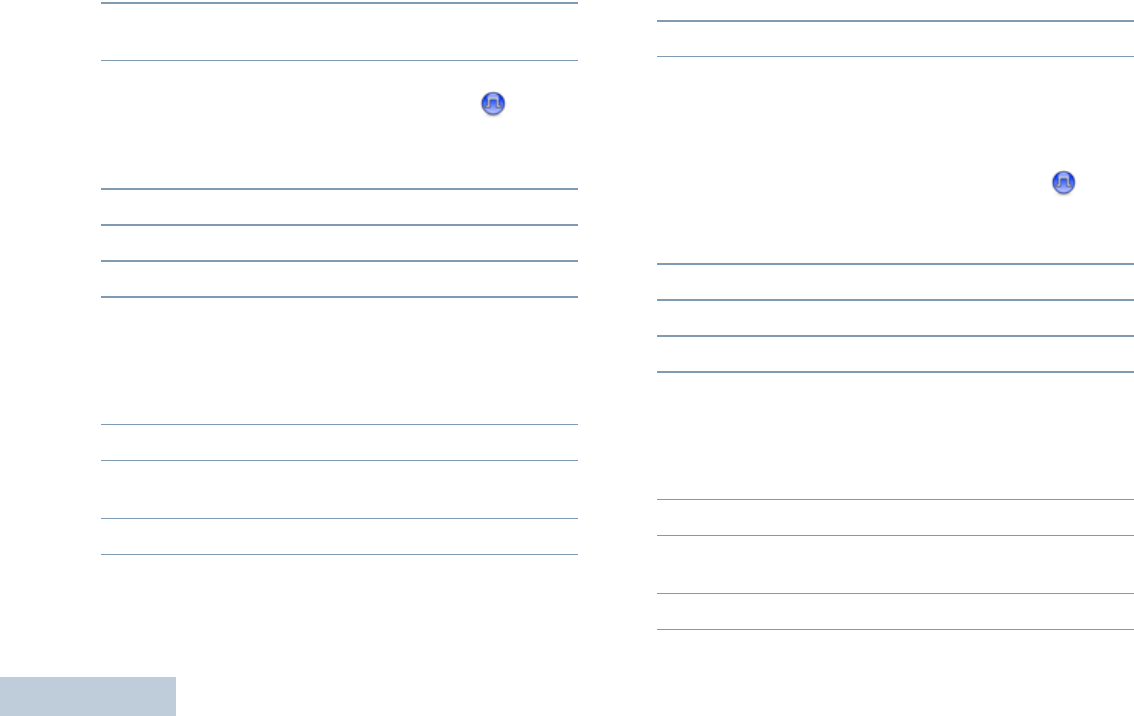
Keypad Microphone Features
English
89
7Press g to select.
8The display shows <Zone> Selected momentarily and
returns to the selected zone screen.
Initiating a Radio Check by Manual Dial
Procedure:
1g to access the menu.
2f or h to Contacts and press g to select.
3f or h to Manual Dial and press g to select.
4f or h to Radio Number and press g to select.
5If there was previously dialed ID, the ID appears along with
a blinking cursor. Use the keypad to edit the ID. Press g to
select.
OR
Key in the subscriber alias or ID and press g.
6f or h to Radio Check and press g to select.
7The display shows transitional mini notice, indicating the
request is in progress. The green LED lights up.
8Wait for acknowledgement.
9If successful, a positive indicator tone sounds and the
display shows positive mini notice.
OR
If unsuccessful, a negative indicator tone sounds and the
display shows negative mini notice.
10 Radio returns to the subscriber alias or ID screen.
If the e button is pressed when the radio is waiting for
acknowledgement, a tone sounds, and the radio terminates all
retries and exits Radio Check mode.
Initiating Remote Monitor by Manual Dial
Procedure:
1g to access the menu.
2f or h to Contacts and press g to select.
3f or h to Manual Dial and press g to select.
4f or h to Radio Number and press g to select.
5If there was previously dialed ID, the ID appears along with
a blinking cursor. Use the keypad to edit the ID. Press g to
select.
OR
Key in the subscriber alias or ID and press g.
6f or h to Remote Mon. and press g to select.
7The display shows transitional mini notice, indicating the
request is in progress. The green LED lights up.
8Wait for acknowledgment.
NAG.book Page 89 Thursday, January 3, 2013 3:15 PM

Keypad Microphone Features
English
90
9If successful, a positive indicator tone sounds and the
display shows positive mini notice. Your radio starts playing
audio from the monitored radio for a programmed duration
and display shows Rem. Monitor.
Once the timer expires, the radio sounds an alert tone and
the LED turns off.
OR
If unsuccessful, the radio sounds a negative indicator tone
the display shows negative mini notice.
Making a Private Call by Manual Dial
Procedure:
1g to access the menu.
2f or h to Contacts and press g to select.The entries
are alphabetically sorted.
3f or h to Manual Dial and press g to select.
4f or h to Radio Number and press g to select.
5If there is a previously dialed subscriber ID, the ID appears
along with a blinking cursor.
Use the keypad to edit the subscriber ID.
OR
Use the keypad to enter a new subscriber ID.
6Press the PTT button to make the call. The green LED lights
up. The display shows the destination alias.
7Wait for the Talk Permit Tone to finish (if enabled) and speak
clearly into the microphone.
8Release the PTT button to listen. When the target radio
responds, the green LED blinks.
9If the Channel Free Indication feature is enabled, you hear a
short alert tone the moment the target radio releases the
PTT button, indicating the channel is free for you to respond.
Press the PTT button to respond.
OR
If there is no voice activity for a programmed period of time,
the call ends.
10 You hear a short tone. The display shows Call Ended.
Making a Phone Call by Manual Dial
Procedure:
1g to access the menu.
2f or h to Contacts and press g to select.The entries
are alphabetically sorted.
3f or h to Manual Dial and press g to select.
4f or h to Phone Number and press g to select.
NAG.book Page 90 Thursday, January 3, 2013 3:15 PM

Keypad Microphone Features
English
91
5The display shows Number:. The second line of the display
shows a blinking cursor. Use the keypad to enter a
telephone number and press g to proceed.
If the access code was not preconfigured in the Contacts
list, the first line of the display shows Access Code:. The
second line of the display shows a blinking cursor. Enter the
access code and press g to proceed.
6The green LED lights up. The Phone Call icon appears in
the top right corner. The first text line shows the subscriber
alias. The second text line displays the call status.
7If successful:
The DTMF tone sounds. You hear the dialing tone of the
telephone user. The first text line shows the subscriber alias.
The Phone Call icon remains in the top right corner.
OR
If unsuccessful:
A tone sounds and the display shows Phone Call Failed.
Your radio returns to the Access Code input screen.
If the access code was preconfigured in the Contacts list,
the radio returns to the screen you were on prior to initiating
the call.
8Press the PTT button to talk and release it to listen. The
To enter extra digits, if requested by the Phone Call:
Enter the extra digits using the keypad and press g to
proceed. The DTMF tone sounds and the radio returns to
the previous screen.
9Press e to end the call.
If deaccess code was not preconfigured in the Contacts list,
the first line of the display shows De-Access Code:. The
second line of the display shows a blinking cursor. Enter the
deaccess code and press g to proceed. The radio returns
to the previous screen.
OR
Press One Touch Access button. The DTMF tone sounds.
If the entry for the One Touch Access button is empty, a
negative indicator tone sounds.
10 The DTMF tone sounds and the display shows Ending
Phone Call.
11 If successful:
A tone sounds and the display shows Call Ended. Your
radio returns to the Phone Call screen.
OR
If unsuccessful:
Your radio returns to the Phone Call screen. Repeat Steps 9
and 10 or wait for the telephone user to end the call.
When you press PTT button while in the Phone Contacts
screen, a tone sounds and the display shows Press OK to
Place Phone Call.
When the telephone user ends the call, a tone sounds and the
display shows Call Ended.
NAG.book Page 91 Thursday, January 3, 2013 3:15 PM

Keypad Microphone Features
English
92
If the call ends while you are entering the extra digits requested
by the Phone Call, your radio returns to the screen you were on
prior to initiating the call.
NOTE: During channel access, press e to dismiss the call
attempt and a tone sounds.
During the call, when you press One Touch Access
button with the deaccess code preconfigured or enter
the deaccess code as the input for extra digits, your
radio attempts to end the call.
During channel access and access/deaccess code or
extra digits transmission, your radio responds to On/
Off button, Volume Knob, and Channel Rocker only.
A tone sounds for every invalid input.
The access or deaccess code cannot be more than 10
characters.
Making a Phone Call with the One Touch Access
Button
Procedure:
1Press the programmed One Touch Access button to make
a Phone Call to the predefined alias or ID.
If the entry for the One Touch Access button is empty, a
negative indicator tone sounds.
If the access code was not preconfigured in the Contacts
list, the first line of the display shows Access Code:. The
second line of the display shows a blinking cursor. Enter the
access code and press g to proceed.
2The green LED lights up. The Phone Call icon appears in
the top right corner. The first text line shows the subscriber
alias. The second text line displays the call status.
3If successful:
The DTMF tone sounds. You hear the dialing tone of the
telephone user. The first text line shows the subscriber alias.
The Phone Call icon remains in the top right corner.
OR
If unsuccessful:
A tone sounds and the display shows Phone Call Failed.
Your radio returns to the Access Code input screen.
If the access code was preconfigured in the Contacts list,
the radio returns to the screen you were on prior to initiating
the call.
NAG.book Page 92 Thursday, January 3, 2013 3:15 PM

Keypad Microphone Features
English
93
4Press the PTT button to talk and release it to listen. The
To enter extra digits, if requested by the Phone Call:
Enter the extra digits using the keypad and press g to
proceed. The DTMF tone sounds and the radio returns to
the previous screen.
5Press e to end the call.
If deaccess code was not preconfigured in the Contacts list,
the first line of the display shows De-Access Code:. The
second line of the display shows a blinking cursor. Enter the
deaccess code and press g to proceed. The radio returns
to the previous screen.
OR
Press One Touch Access button. The DTMF tone sounds.
If the entry for the One Touch Access button is empty, a
negative indicator tone sounds.
6The DTMF tone sounds and the display shows Ending
Phone Call.
7If successful:
A tone sounds and the display shows Call Ended. Your
radio returns to the Phone Call screen.
OR
If unsuccessful:
Your radio returns to the Phone Call screen. Repeat Step 5
or wait for the telephone user to end the call.
When the telephone user ends the call, a tone sounds and the
display shows Phone Call Ended.
If the call ends while you are entering the extra digits requested
by the Phone Call, your radio returns to the screen you were on
prior to initiating the call.
NOTE: During channel access, press e to dismiss the call
attempt and a tone sounds.
During the call, when you press One Touch Access
button with the deaccess code preconfigured or enter
the deaccess code as the input for extra digits, your
radio attempts to end the call.
During channel access and access/deaccess code or
extra digits transmission, your radio responds to On/
Off button, Volume Knob, and Channel Rocker only.
A tone sounds for every invalid input.
The access or deaccess code cannot be more than 10
characters.
NAG.book Page 93 Thursday, January 3, 2013 3:15 PM

Keypad Microphone Features
English
94
Making a Group, Private or All Call with the
Programmable Number Key
The Programmable Number Key feature allows you to make a
Group, Private or All Call to a predefined alias or ID easily. This
feature can be assigned to all the available number keys on a
keypad microphone.
You can ONLY have one alias or ID assigned to a number key,
but you can have more than one number key associated to an
alias or ID.
Procedure:
When you are on the Home screen:
1Long press the programmed number key to make a Group,
Private or All Call to the predefined alias or ID.
If the number key is not associated to an entry, a negative
indicator tone sounds.
2Press the PTT button to make the call. The green LED lights
up. The Group/Private Call icon appears in the top right
corner. The first text line shows the caller alias. The second
text line displays either the call status for a Private Call or
All Call for All Call.
3Wait for the Talk Permit Tone to finish (if enabled) and speak
clearly into the microphone.
OR
For Group Call only: Wait for the PTT Sidetone to
finish (if enabled) and speak clearly into the microphone.
4Release the PTT button to listen. When the target radio
responds, the green LED blinks. The display shows the
destination alias.
5If the Channel Free Indication feature is enabled, you hear a
short alert tone the moment the target radio releases the
PTT button, indicating the channel is free for you to respond.
Press the PTT button to respond.
OR
If there is no voice activity for a predetermined period of
time, the call ends.
6Radio returns to the screen you were on prior to initiating the
call.
For a Private Call, you hear a short tone when the call ends.
See Assigning an Entry to a Programmable Number Key on
page 41 for details on assigning an entry to a number key on
the keypad.
NAG.book Page 94 Thursday, January 3, 2013 3:15 PM

Keypad Microphone Features
English
95
Making a Phone Call with the Programmable
Phone Button
Procedure:
1Press the programmed Phone button to enter into the
Phone Entry list.
2f or h to the required subscriber alias or ID, and press
g to select.
If the access code was not preconfigured in the Contacts
list, the first line of the display shows Access Code:. The
second line of the display shows a blinking cursor. Enter the
access code and press g to proceed.
3The first line of the display shows Calling. The second line
of the display shows the subscriber alias or ID, and the
Phone Call icon.
4If successful:
The DTMF tone sounds. You hear the dialing tone of the
telephone user. The first line of the display shows the
subscriber alias or ID, and the RSSI icon. The second line of
the display shows Phone Call and the Phone Call icon.
OR
If unsuccessful:
A tone sounds and the display shows Phone Call Failed.
Your radio returns to the Access Code input screen.
If the access code was preconfigured in the Contacts list,
the radio returns to the screen you were on prior to initiating
the call.
5Press the PTT button to talk and release it to listen. The
RSSI icon disappears during transmission.
To enter extra digits, if requested by the Phone Call:
The first line of the display shows Extra Digits:. The
second line of the display shows a blinking cursor. Enter the
extra digits using the keypad and press g to proceed. The
DTMF tone sounds and the radio returns to the previous
screen.
OR
Press One Touch Access button. The DTMF tone sounds.
If the entry for the One Touch Access button is empty, a
negative indicator tone sounds.
6Press e to end the call.
If deaccess code was not preconfigured in the Contacts list,
the first line of the display shows De-Access Code:. The
second line of the display shows a blinking cursor. Enter the
deaccess code and press g to proceed. The radio returns
to the previous screen.
7The DTMF tone sounds and the display shows Ending
Phone Call.
8If successful:
A tone sounds and the display shows Phone Call Ended.
Your radio returns to the screen you were on prior to
initiating the call.
OR
NAG.book Page 95 Thursday, January 3, 2013 3:15 PM

Keypad Microphone Features
English
96
If unsuccessful:
Your radio returns to the Phone Call screen. Repeat Steps 6
and 7 or wait for the telephone user to end the call.
When you press PTT button while in the Phone Contacts
screen, a tone sounds and the display shows Press OK to
Place Phone Call.
When the telephone user ends the call, a tone sounds and the
display shows Phone Call Ended.
If the call ends while you are entering the extra digits requested
by the Phone Call, your radio returns to the screen you were on
prior to initiating the call.
NOTE: During channel access, press e to dismiss the call
attempt and a tone sounds.
During the call, when you press One Touch Access
button with the deaccess code preconfigured or enter
the deaccess code as the input for extra digits, your
radio attempts to end the call.
During channel access and access/deaccess code or
extra digits transmission, your radio responds to On/
Off button, Volume Knob, and Channel Rocker only.
A tone sounds for every invalid input.
The access or deaccess code cannot be more than 10
characters.
Making a Phone Call from Contacts
Procedure:
1g to access the menu.
2f or h to Contacts and press g to select.The entries
are alphabetically sorted.
3f or h to the required subscriber alias or ID.
OR
f or h to Manual Dial and press g to select.
f or h to Phone Number and press g to select.
The first line of the display shows Phone Number:. The
second line of the display shows a blinking cursor. Use the
keypad to enter a telephone number.
4Press g to select.
If the entry selected is empty, a negative indicator tone
sounds and the display shows Phone Call Invalid #.
5f or h to Call Phone and press g to select.
If the access code was not preconfigured in the Contacts
list, the first line of the display shows Access Code:. The
second line of the display shows a blinking cursor. Enter the
access code and press g to proceed.
6The first line of the display shows Calling. The second line
of the display shows the subscriber alias or ID, and the
Phone Call icon.
NAG.book Page 96 Thursday, January 3, 2013 3:15 PM

Keypad Microphone Features
English
97
7If successful:
The DTMF tone sounds. You hear the dialing tone of the
telephone user. The first line of the display shows the
subscriber alias or ID, and the RSSI icon. The second line of
the display shows Phone Call and the Phone Call icon.
OR
If unsuccessful:
A tone sounds and the display shows Phone Call Failed.
Your radio returns to the Access Code input screen.
If the access code was preconfigured in the Contacts list,
the radio returns to the screen you were on prior to initiating
the call.
8Press the PTT button to talk and release it to listen. The
RSSI icon disappears during transmission.
To enter extra digits, if requested by the Phone Call:
The first line of the display shows Extra Digits:. The
second line of the display shows a blinking cursor. Enter the
extra digits using the keypad and press g to proceed. The
DTMF tone sounds and the radio returns to the previous
screen.
OR
Press One Touch Access button. The DTMF tone sounds.
If the entry for the One Touch Access button is empty, a
negative indicator tone sounds.
9Press e to end the call.
If deaccess code was not preconfigured in the Contacts list,
the first line of the display shows De-Access Code:. The
second line of the display shows a blinking cursor. Enter the
deaccess code and press g to proceed. The radio returns
to the previous screen.
10 The DTMF tone sounds and the display shows Ending
Phone Call.
11 If successful:
A tone sounds and the display shows Phone Call Ended.
Your radio returns to the Call Phone screen.
OR
If unsuccessful:
Your radio returns to the Phone Call screen. Repeat Steps 9
and 10 or wait for the telephone user to end the call.
When you press PTT button while in the Phone Contacts
screen, a negative indicator tone sounds and the display shows
Press OK to Place Phone Call.
When the telephone user ends the call, a tone sounds and the
display shows Phone Call Ended.
If the call ends while you are entering the extra digits requested
by the Phone Call, your radio returns to the screen you were on
prior to initiating the call.
NAG.book Page 97 Thursday, January 3, 2013 3:15 PM

Keypad Microphone Features
English
98
NOTE: During channel access, press e to dismiss the call
attempt and a negative indicator tone sounds. Your
radio returns to the Call Phone screen.
During the call, when you press One Touch Access
button with the deaccess code preconfigured or enter
the deaccess code as the input for extra digits, your
radio attempts to end the call.
During channel access and access/deaccess code or
extra digits transmission, your radio responds to On/
Off button, Volume Knob, and Channel Rocker only.
A tone sounds for every invalid input.
The access or deaccess code cannot be more than 10
characters.
Making a Group, Private, Phone or All Call by Alias
Search
You can also use alias or alphanumeric search to retrieve the
required subscriber alias.
This feature is only applicable while in Contacts.
Procedure:
1g to access the menu.
2f or h to Contacts and press g to select. The entries
are alphabetically sorted.
3Key in the first character of the required alias.
4A blinking cursor appears.
Use the keypad to type the required alias.
Press < to move one space to the left.
Press > to move one space to the right.
Press * to delete any unwanted characters.
Long press # to change text entry method.
5The first line of the display shows the characters you keyed
in. The next lines of the display show the shortlisted search
results.
The alias search is case-insensitive. If there are two or more
aliases with the same name, the radio displays the alias that
is listed first in the Contacts list.
NAG.book Page 98 Thursday, January 3, 2013 3:15 PM

Keypad Microphone Features
English
99
6Press the PTT button to make the call. The green LED lights
up. The first line displays the target radio’s ID. The second
line displays the call type and the Call icon.
7Wait for the Talk Permit Tone to finish (if enabled) and speak
clearly into the microphone
8Release the PTT button to listen. When the target radio
responds, the green LED blinks. The display shows the
destination alias.
9If the Channel Free Indication feature is enabled, you hear a
short alert tone the moment the target radio releases the
PTT button, indicating the channel is free for you to respond.
Press the PTT button to respond.
OR
If there is no voice activity for a programmed period of time,
the call ends.
10 You hear a short tone. The display shows Call Ended.
NOTE: Press e button or g to exit alias search.
Viewing an Entry in the Scan List by Alias Search
Procedure:
1g to access the menu.
2f or h to Scan and press g to select.
3f or h to Scan List and press g to select.
4Key in the first character of the required alias.
5A blinking cursor appears.
Use the keypad to type the required alias.
Press < to move one space to the left.
Press > to move one space to the right.
Press * to delete any unwanted characters.
Long press # to change text entry method.
6The first line of the display shows the characters you keyed
in. The next lines of the display show the shortlisted search
results.
The alias search is case-insensitive. If there are two or more
entries with the same name, the radio displays the entry that is
listed first in the scan list.
NAG.book Page 99 Thursday, January 3, 2013 3:15 PM

Keypad Microphone Features
English
100
Editing the Scan List by Alias Search
Adding a New Entry to the Scan List
Procedure:
1g to access the menu.
2f or h to Scan and press g to select.
3f or h to Scan List and press g to select.
4f or h to Add Member and press g to select.
5Key in the first character of the required alias.
6A blinking cursor appears.
Use the keypad to type the required alias.
Press < to move one space to the left.
Press > to move one space to the right.
Press * to delete any unwanted characters.
Long press # to change text entry method.
7The first line of the display shows the characters you keyed
in. The next lines of the display show the shortlisted search
results.
The alias search is case-insensitive. If there are two or more
aliases with the same name, the radio displays the alias that
is listed first in the list.
8Press g to select.
9f or h to the required priority level and press g to
select.
10 The display shows positive mini notice, followed
immediately by Add Another?.
11 f or h to Yes and press g to select, to add another
entry, and repeat Steps 5 to 9.
OR
f or h to No and press g to select to save the current
list.
Deleting an Entry from the Scan List
Procedure:
1g to access the menu.
2f or h to Scan and press g to select.
3f or h to Scan List and press g to select.
4Key in the first character of the required alias.
5A blinking cursor appears.
Use the keypad to type the required alias.
Press < to move one space to the left.
Press > to move one space to the right.
Press * to delete any unwanted characters.
Long press # to change text entry method.
NAG.book Page 100 Thursday, January 3, 2013 3:15 PM

Keypad Microphone Features
English
101
6The first line of the display shows the characters you keyed
in. The next lines of the display show the shortlisted search
results.
The alias search is case-insensitive. If there are two or more
entries with the same name, the radio displays the entry that
is listed first in the scan list.
7Press g to select.
8f or h to Delete and press g to select.
9At Delete Entry?, f or h to Yes and press g to
select, to delete the entry. The display shows positive mini
notice.
OR
f or h to No and press g to select to return to the
previous screen.
10 Repeat Steps 4 to 9 to delete other entries.
After deleting all required aliases or IDs, long press e to
return to the Home screen.
Setting and Editing Priority for an Entry in the Scan
List
Procedure:
1g to access the menu.
2f or h to Scan and press g to select.
3f or h to Scan List and press g to select.
4Key in the first character of the required alias.
5A blinking cursor appears.
Use the keypad to type the required alias.
Press < to move one space to the left.
Press > to move one space to the right.
Press * to delete any unwanted characters.
Long press # to change text entry method.
6The first line of the display shows the characters you keyed
in. The next lines of the display show the shortlisted search
results.
The alias search is case-insensitive. If there are two or more
entries with the same name, the radio displays the entry that
is listed first in the scan list.
7Press g to select.
8f or h to Edit Priority and press g to select.
NAG.book Page 101 Thursday, January 3, 2013 3:15 PM

Keypad Microphone Features
English
102
9f or h to the required priority level and press g to
select.
10 The display shows positive mini notice before returning to
the previous screen.
11 The priority icon appears left of the member’s name.
There is no priority icon if priority is set to None.
Storing an Alias or ID from a Call List
Procedure:
1g to access the menu.
2f or h to Call Log and press g to select.
3f or h to the required list and press g to select.
4f or h to the required alias or ID and press g to
select.
5f or h to Store and press g to select.
6A blinking cursor appears. If needed, key in the alias for that
ID and press g.
7The display shows positive mini notice.
You can also store an ID without an alias.
Making a Call Alert by Manual Dial
Procedure:
1g to access the menu.
2f or h to Contacts and press g to select.
3f or h to Manual Dial and press g to select.
4A blinking cursor appears. Enter the subscriber ID you want
to send the Call Alert to and press g.
5f or h to Call Alert and press g to select.
6The display shows Call Alert and the subscriber alias or
ID, indicating that the Call Alert has been sent.
7The green LED lights up when your radio is sending the Call
Alert.
8If the Call Alert acknowledgement is received, the display
shows positive mini notice.
OR
If the Call Alert acknowledgement is not received, the
display shows negative mini notice.
NAG.book Page 102 Thursday, January 3, 2013 3:15 PM

Keypad Microphone Features
English
103
RSSI Values
Your radio shows the Received Signal Strength Indicator (RSSI)
icon at the top of your display. This feature allows you to view
the RSSI values.
Procedure:
When you are on the Home screen:
1Press < three times (<-<-<) and immediately press > three
times (>->->), all within 5 seconds.
2The display shows the current RSSI values.
Long press the e button to return to the Home screen.
See Display Icons on page 13 for details on the RSSI icon.
Text Messaging
The maximum length of characters for a text message,
including the subject line (seen when receiving message from
an e-mail application), is 140, whereas to receive would be a
maximum of 280 characters.
The radio exits the current screen once the inactivity timer
expires. Any text message in the writing/editing screen is
automatically saved to the Drafts folder.
NOTE: Long press e at any time to return to the Home
screen.
Writing and Sending a Text Message
Procedure:
Press the programmed Text Message button and proceed to
Step 3.
OR
Follow the procedure below.
1g to access the menu.
2f or h to Messages and press g to select.
3f or h to Compose and press g to select.
4Use the keypad to type your message.
Press < to move one space to the left.
NAG.book Page 103 Thursday, January 3, 2013 3:15 PM

Keypad Microphone Features
English
104
Press > or the # key to move one space to the right.
Press the * key to delete any unwanted characters.
5Press g once message is composed.
6f or h to the required alias or ID and press g to
select.
OR
f or h to Manual Dial and press g to select.
Key in the subscriber ID and press g.
OR
e to edit the message.
e again to discard the message or save it to the Drafts
folder.
7The display shows transitional mini notice, confirming your
message is being sent.
8If the message is sent, a tone sounds and the display shows
positive mini notice.
OR
If the message is not sent, a low tone sounds and the
display shows negative mini notice.
If the text message fails to send, the radio returns you to the
Resend
option screen (see Managing Fail-to-Send Text
Messages on page 57 and page 106).
Replying to Text Messages from the Inbox
Procedure:
Press the programmed Text Message button and proceed to
Step 3.
OR
Follow the procedure below.
1g to access the menu.
2f or h to Messages and press g to select.
3f or h to Inbox and press g to select.
4f or h to the required message and press g to select.
A subject line may be shown if the message is from an
e-mail application.
5Press g once more to access additional options.
6f or h to Reply and press g to select.
A blinking cursor appears. Use the keypad to type your
message.
Press < to move one space to the left.
Press > to move one space to the right.
Press * to delete any unwanted characters.
Long press # to change text entry method.
7Press g once message is composed.
NAG.book Page 104 Thursday, January 3, 2013 3:15 PM

Keypad Microphone Features
English
105
8The display shows transitional mini notice, confirming your
message is being sent.
9If the message is sent, a tone sounds and the display shows
positive mini notice.
OR
If the message is not sent, a low tone sounds and the
display shows negative mini notice.
If the text message fails to send, the radio returns you to the
Resend
option screen (see Managing Fail-to-Send Text
Messages on page 57 and page 106).
NOTE: If a subject line is present (for messages received from
an e-mail application), you cannot edit it.
Editing a Quick Reply Message
Procedure:
Press the programmed Text Message button and proceed to
Step 3.
OR
Follow the procedure below.
1g to access the menu.
2f or h to Messages and press g to select.
3f or h to Quick Reply and press g to select.
4f or h to the required Quick Text and press g to
select.
5A blinking cursor appears. Use the keypad to edit the
message.
Press < to move one space to the left.
Press > to move one space to the right.
Press * to delete any unwanted characters.
Long press # to change text entry method.
6Press g once message is composed.
7The display shows transitional mini notice, confirming your
message is being sent.
8If the message is sent, a tone sounds and the display shows
positive mini notice.
OR
If the message is not sent, a low tone sounds and the
display shows negative mini notice.
If the text message fails to send, the radio returns you to the
Resend
option screen (see Managing Fail-to-Send Text
Messages on page 57 and page 106).
NAG.book Page 105 Thursday, January 3, 2013 3:15 PM

Keypad Microphone Features
English
106
Accessing the Drafts Folder
You can save a text message to send it at a later time.
If a PTT button press or a mode change causes the radio to exit
the text message writing/editing screen while you are in the
process of writing or editing a text message, your current text
message is automatically saved to the Drafts folder.
The most recent saved text message is always added to the top
of the Drafts list. See Managing Text Messages in the Drafts
Folder on page 56 for more information.
NOTE: Long press e at any time to return to the Home
screen.
Editing and Sending a Saved Text Message
Procedure:
1Press g again while viewing the message.
2f or h to Edit and press g to select.
A blinking cursor appears.
Use the keypad to edit your message.
Press < to move one space to the left.
Press > to move one space to the right.
Press * to delete any unwanted characters.
Long press # to change text entry method.
Press g once message is composed.
3f or h to the required alias or ID and press g to
select.
OR
f or h to Manual Dial and press g to select.
The first line of the display shows Radio Number:.
Key in the subscriber alias or ID and press g.
4The display shows transitional mini notice, confirming your
message is being sent.
5If the message is sent, a tone sounds and the display shows
positive mini notice.
OR
If the message is not sent, a low tone sounds and the
display shows negative mini notice.
If the text message fails to send, it is moved to the Sent Items
folder and marked with a Send Failed icon.
Managing Fail-to-Send Text Messages
if the message fails to send, the radio returns you to the Resend
option screen.
NAG.book Page 106 Thursday, January 3, 2013 3:15 PM

Keypad Microphone Features
English
107
Forwarding a Text Message by Manual Dial
Select Forward to send the message to another subscriber/
group alias or ID.
Procedure:
1f or h to Forward and press g to select.
2f or h to Manual Dial and press g to select.
The first line of the display shows Radio Number:.
Key in the subscriber ID and press g.
3The display shows transitional mini notice, confirming your
message is being sent.
4If the message is sent, a tone sounds and the display shows
positive mini notice.
OR
If the message is not sent, a low tone sounds and the
display shows negative mini notice.
Editing a Text Message
Select Edit to edit the message before sending it.
NOTE: If a subject line is present (for messages received from
an e-mail application), you cannot edit it.
Procedure:
1f or h to Edit and press g to select.
2A blinking cursor appears beside the message.
Use the keypad to edit your message.
Press < to move one space to the left.
Press > to move one space to the right.
Press * to delete any unwanted characters.
Long press # to change text entry method.
3Press g once message is composed.
4f or h to the required alias or ID and press g to
select.
OR
f or h to Manual Dial and press g to select.
The first line of the display shows Radio Number:.
Key in the subscriber ID and press g.
5The display shows transitional mini notice, confirming your
message is being sent.
6If the message is sent, a tone sounds and the display shows
positive mini notice.
OR
If the message is not sent, a low tone sounds and the
display shows negative mini notice.
NAG.book Page 107 Thursday, January 3, 2013 3:15 PM
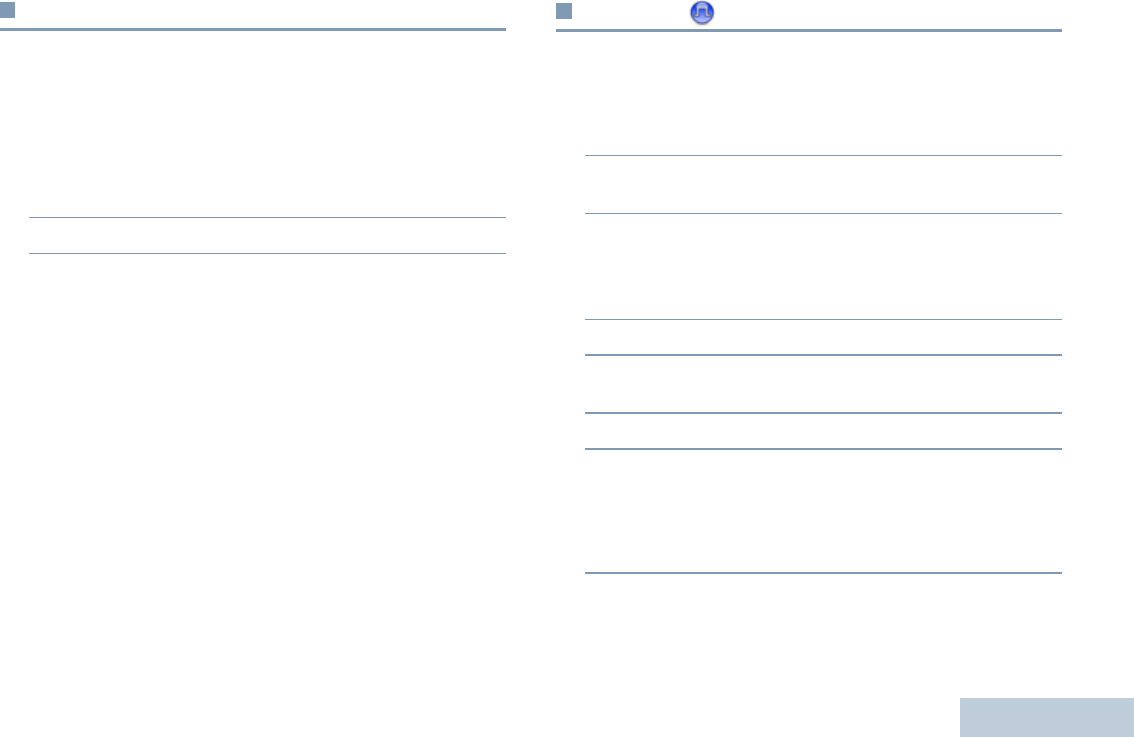
Keypad Microphone Features
English
108
Dual Tone Multi Frequency (DTMF)
The Dual Tone Multi Frequency (DTMF) feature allows the radio
to operate in a radio system with an interface to telephone
systems.
Procedure:
To initiate a DTMF call.
1Press and hold the PTT button.
2Enter the desired number, * or #.
You can turn off the DTMF tone by disabling all radio tones and
alerts (see Turning the Radio Tones/Alerts On or Off on
page 74).
Security
Radio Disable via Manual Dial
Procedure:
1g to access the menu.
2f or h to Contacts and press g to select. The entries
are alphabetically sorted.
3f or h to Manual Dial and press g to select.
f or h to Private Call and press g to select.
The first line of the display shows Radio Number:.
Key in the subscriber ID and press g.
4f or h to Radio Disable and press g to select.
5The display shows transitional mini notice, indicating the
request is in progress. The green LED blinks.
6Wait for acknowledgment.
7If successful, a positive indicator tone sounds and the
display shows positive mini notice.
OR
If unsuccessful, a negative indicator tone sounds and the
display shows negative mini notice.
Do not press e during the Radio Disable operation as you
will not get an acknowledgement message.
NAG.book Page 108 Thursday, January 3, 2013 3:15 PM

Keypad Microphone Features
English
109
Radio Enable via Manual Dial
Procedure:
1g to access the menu.
2f or h to Contacts and press g to select. The entries
are alphabetically sorted.
3f or h to Manual Dial and press g to select.
f or h to Private Call and press g to select.
The first line of the display shows Radio Number:.
Key in the subscriber ID and press g.
4f or h to Radio Enable and press g to select.
5The display shows Radio Enable and the subscriber alias
or ID. The green LED lights up.
6Wait for acknowledgment.
7If successful, the radio sounds a positive indicator tone and
the display shows positive mini notice.
OR
If unsuccessful, the radio sounds a negative indicator tone
and the display shows negative mini notice.
Do not press e during the Radio Enable operation as you will
not get an acknowledgement message.
Password Lock Features
If enabled, this feature allows you to access your radio via
password upon powering up. You can use a keypad microphone
or Scroll Up/Down buttons to enter password.
Accessing the Radio from Password
Procedure:
Power up the radio.
1You hear a continuous tone.
2Enter your current four-digit password via keypad
microphone.
The display shows ●●●●. Press g to proceed.
OR
Enter your current four-digit password. Press f or h to
edit each digit’s numeric value and g to enter the selected
digit and move to the next digit. Each digit changes to ●.
Press g to confirm your selection.
You hear a positive indicator tone for every digit pressed.
Press < to remove the each ● on the display. You hear a
negative indicator tone, if you press < when the line is
empty, or if you press more than four digits.
NAG.book Page 109 Thursday, January 3, 2013 3:15 PM

Keypad Microphone Features
English
110
3If the password is correct:
Your radio proceeds to power up. See Powering Up the
Radio on page 2.
OR
If the password is incorrect:
The display shows Wrong Password. Repeat Step 2.
OR
After the third incorrect password, the display shows
Wrong Password and then, shows Radio Locked. A tone
sounds and the yellow LED double blinks.
Your radio enters into locked state for 15 minutes, and responds
to inputs from On/Off button and programmed Backlight Auto
button only.
NOTE: The radio is unable to receive any call, including
emergency calls, in locked state.
The use of Emergency footswitch cancels out
password input to access the radio.
Unlocking the Radio from Locked State
Procedure:
Wait for 15 minutes. Repeat Steps 1 to 3 in Accessing the
Radio from Password on page 109.
OR
Power up the radio, if you have powered down the radio during
locked state:
1A tone sounds and the yellow LED double blinks. The
display shows Radio Locked.
2Wait for 15 minutes. Repeat Accessing the Radio from
Password on page 109.
Your radio restarts the 15 minutes timer for locked state when
you power up.
Turning the Password Lock On or Off
Procedure:
1g to access the menu.
2f or h to Utilities and press g to select.
3f or h to Radio Settings and press g to select.
4f or h to Passwd Lock and press g to select.
5Enter a four-digit password.
See Step 2 in Accessing the Radio from Password on
page 109.
NAG.book Page 110 Thursday, January 3, 2013 3:15 PM

Keypad Microphone Features
English
111
6If the password is correct:
Press g to enable Password Lock. The display shows 9
beside Enabled.
OR
Press g to disable Password Lock. The 9 disappears
from beside Enabled.
OR
If the password is incorrect:
The display shows Wrong Password and automatically
returns to the previous menu.
Changing the Password
Procedure:
1g to access the menu.
2f or h to Utilities and press g to select.
3f or h to Radio Settings and press g to select.
4f or h to Passwd Lock and press g to select.
5Enter your current four-digit password via keypad
microphone.
See Step 2 in Accessing the Radio from Password on
page 109.
6If the password is correct:
f or h to Change Pwd and press g to select.
OR
If the password is incorrect:
The display shows Wrong Password and automatically
returns to the previous menu.
7Enter a new four-digit password via keypad microphone.
See Step 2 in Accessing the Radio from Password on
page 109.
8Re-enter the new four-digit password. See Step 2 in
Accessing the Radio from Password on page 109.
9If both of the new password inputs match:
The display shows Password Changed.
OR
If both of the new password inputs do not match:
The display shows Passwords Do Not Match.
10 The screen automatically returns to the previous menu.
NAG.book Page 111 Thursday, January 3, 2013 3:15 PM

Keypad Microphone Features
English
112
Text Entry Configuration
You can configure the following settings for entering text on your
radio:
•Word Correct
•Word Predict
•Sentence Cap
•My Words
NOTE: Press e at any time to return to the previous screen
or long press e to return to the Home screen. The
radio exits the current screen once the inactivity timer
expires.
Word Correct
Supplies alternative word choices when the word entered into
the text editor is not recognized by the in-built dictionary.
1g to access the menu.
2f or h to Utilities and press g to select.
3f or h to Radio Settings and press g to select.
4f or h to Text Entry and press g to select.
5f or h to Word Correct and press g to select.
6Press g to enable Word Correct. The display shows 9
beside Enabled.
OR
Press g to disable Word Correct. The 9 disappears from
beside Enabled.
NOTE: At Step 5, you can also use < or > to change the
selected option.
NAG.book Page 112 Thursday, January 3, 2013 3:15 PM

Keypad Microphone Features
English
113
Word Predict
Your radio can learn common word sequences that you often
enter. It then predicts the next word you may want to use after
you enter the first word of a common word sequence into the
text editor.
1g to access the menu.
2f or h to Utilities and press g to select.
3f or h to Radio Settings and press g to select.
4f or h to Text Entry and press g to select.
5f or h to Word Predict and press g to select.
6Press g to enable Word Predict. The display shows 9
beside Enabled.
OR
Press g to disable Word Predict. The 9 disappears from
beside Enabled.
NOTE: At Step 5, you can also use < or > to change the
selected option.
Sentence Cap
Automatically enables capitalization for the first letter in the first
word for every new sentence.
1g to access the menu.
2f or h to Utilities and press g to select.
3f or h to Radio Settings and press g to select.
4f or h to Text Entry and press g to select.
5f or h to Sentence Cap and press g to select.
6Press g to enable Sentence Cap. The display shows 9
beside Enabled.
OR
Press g to disable Sentence Cap. The 9 disappears from
beside Enabled.
NOTE: At Step 5, you can also use < or > to change the
selected option.
NAG.book Page 113 Thursday, January 3, 2013 3:15 PM

Keypad Microphone Features
English
114
Viewing Custom Words
You can add your own custom words into your radio’s in-built
dictionary. Your radio maintains a list to contain these words.
1g to access the menu.
2f or h to Utilities and press g to select.
3f or h to Radio Settings and press g to select.
4f or h to Text Entry and press g to select.
5f or h to My Words and press g to select.
6f or h to List of Words and press g to select.
Display shows the list of custom words.
Editing Custom Word
You can edit the custom words saved in your radio.
1g to access the menu.
2f or h to Utilities and press g to select.
3f or h to Radio Settings and press g to select.
4f or h to Text Entry and press g to select.
5f or h to My Words and press g to select.
6f or h to List of Words and press g to select.
Display shows the list of custom words.
7f or h to the required word and press g to select.
8f or h to the Edit and press g to select.
9Use the keypad to edit your custom word.
Press < to move one space to the left.
Press > or # to move one space to the right.
Press * to delete any unwanted characters.
Long press # to change text entry method.
Press g once your custom word is complete.
10 The display shows transitional mini notice, confirming your
custom word is being saved.
11 If the custom word is saved, a tone sounds and the display
shows positive mini notice.
OR
If the custom word is not saved, a low tone sounds and the
display shows negative mini notice.
Adding Custom Words
You can add your own custom words into your radio’s in-built
dictionary.
1g to access the menu.
2f or h to Utilities and press c to select.
3f or h to Radio Settings and press c to select.
NAG.book Page 114 Thursday, January 3, 2013 3:15 PM

Keypad Microphone Features
English
115
4f or h to Text Entry and press c to select.
5f or h to My Words and press c to select.
6f or h to Add New Word and press c to select.
7Use the keypad to enter your custom word.
Press < to move one space to the left.
Press > or # to move one space to the right.
Press * to delete any unwanted characters.
Long press # to change text entry method.
Press g once your custom word is complete.
8The display shows transitional mini notice, confirming your
custom word is being saved.
9If the custom word is saved, a tone sounds and the display
shows positive mini notice.
OR
If the custom word is not saved, a low tone sounds and the
display shows negative mini notice.
Deleting a Custom Word
You can delete the custom words saved in your radio.
1g to access the menu.
2f or h to Utilities and press g to select.
3f or h to Radio Settings and press g to select.
4f or h to Text Entry and press g to select.
5f or h to My Words and press g to select.
6f or h to the required word and press g to select.
7f or h to Delete and press g to select.
8At Delete Entry?, f or h to Yes and press g to
select, to delete the entry. The display shows Entry
Deleted.
OR
f or h to No and press g to select to return to the
previous screen.
NAG.book Page 115 Thursday, January 3, 2013 3:15 PM

Keypad Microphone Features
English
116
Deleting All Custom Words
You can delete all custom words from your radio’s in-built
dictionary.
1g to access the menu.
2f or h to Utilities and press g to select.
3f or h to Radio Settings and press g to select.
4f or h to Text Entry and press g to select.
5f or h to My Words and press g to select.
6f or h to Delete All and press g to select.
7At Delete All?, f or h to Yes and press g to select,
to delete all custom words. The display shows All Entries
Deleted.
OR
f or h to No and press g to select to return to the
previous screen.
Front Panel Configuration (FPC)
Your radio is able to customize certain feature parameters to
enhance the use of your radio.
Entering FPC Mode
Procedure:
1g to access the menu.
2f or h to Utilities and press g to select.
3f or h to Program Radio and press g to select.
NOTE: Long press e at any time to return to the Home
screen.
Editing FPC Mode Parameters
Use the following buttons as required while navigating through
the feature parameters.
f, h, <, > – Scroll through options, increase/decrease
values, or navigate vertically
g – Select the option or enter a sub-menu
e – Short-press to return to previous menu or to exit the
selection screen. Long-press to return to Home screen.
NAG.book Page 116 Thursday, January 3, 2013 3:15 PM

Accessories
English
117
Accessories
Your radio is compatible with the accessories listed in this
chapter. Contact your dealer for details.
Antennas. . . . . . . . . . . . . . . . . . . . . . . . . . . . . . . . . . page 117
Audio. . . . . . . . . . . . . . . . . . . . . . . . . . . . . . . . . . . . . page 117
Cables. . . . . . . . . . . . . . . . . . . . . . . . . . . . . . . . . . . . page 118
Mounting Kits . . . . . . . . . . . . . . . . . . . . . . . . . . . . . . page 118
Miscellaneous Accessories. . . . . . . . . . . . . . . . . . . . page 118
Antennas
•VHF, 136 – 144 MHz, 1/4 Wave Roof Mount, Mini-U
(HAD4006_)
•VHF, 144 – 150.8 MHz, 1/4 Wave Roof Mount, Mini-U
(HAD4007_)
•VHF, 150.8 – 162 MHz, 1/4 Wave Roof Mount, Mini-U
(HAD4008_)
•VHF, 162 – 174 MHz, 1/4 Wave Roof Mount, Mini-U
(HAD4009_)
•VHF, 132 – 174 MHz, 3.0 dB Gain, Through-Hole Mount,
Mini-U (HAD4022_)
•UHF, 403 – 430 MHz, 1/4 Wave Roof Mount, Mini-U
(HAD4002_)
•UHF, 450 – 470 MHz, 1/4 Wave Roof Mount, Mini-U
(HAD4003_)
•UHF, 470 – 512 MHz, 1/4 Wave Roof Mount, Mini-U
(HAD4004_)
•UHF, 406 – 420 MHz, 3.5 dB Gain Roof Mount, Mini-U
(HAD4010_)
•UHF, 450 – 470 MHz, 3.5 dB Gain Roof Mount, Mini-U
(HAD4011_)
•UHF, 403 – 527 MHz, 2dB Gain, Through-hole Mount, Mini-U
(HAD4012_)
•UHF, 445 – 470 MHz, 5 dB Gain Roof Mount, Mini-U
(with base) (RAE4004_RB)
Audio
•Visor Microphone (Omni-Direction) (GMMN4065_)
•Microphone Hang-up Clip (requires install) (HLN9073_)
•Microphone Hang-up Clip (Universal – no install required)
(HLN9414_)
•External Speaker 7.5 W (HSN8145_)
•Telephone Style Handset (PMLN6481_)
•Compact Microphone with clip (PMMN4090_)
•Heavy Duty Microphone (PMMN4091_)
NAG.book Page 117 Thursday, January 3, 2013 3:15 PM

Accessories
English
118
•External Speaker 13 W (RSN4001_)
•External Speaker 5 W (RSN4004_)
Cables
•Mobile Pwr Cable 10 FT, 14 AWG, 15A (HKN4137_)
•Mobile Pwr Cable 10 FT, 12 AWG, 20A (HKN4191_)
•Mobile Pwr Cable 20 FT, 10 AWG, 20A (HKN4192_)
•Ignition Switch Cable (RKN4136_)
Mounting Kits
•DIN Mount (FTN6083_)
•Low Profile Trunnion Kit (RLN6466_)
•High Profile Trunnion Kit (RLN6467_)
•Key Lock Trunnion Kit (RLN6468_)
Miscellaneous Accessories
•External PTT with Emergency Footswitch (RLN4836AR_)
•Footswitch with Remote PTT (RLN4856_)
•Pushbutton with Remote PTT (RLN4857_)
NAG.book Page 118 Thursday, January 3, 2013 3:15 PM

Appendix: Maritime Radio Use in the VHF Frequency Range
English
119
Appendix: Maritime Radio Use in the
VHF Frequency Range
Take a moment to review the following:
Special Channel Assignments. . . . . . . . . . . . . . . . . . page 119
Operating Frequency Requirements. . . . . . . . . . . . . page 120
Special Channel Assignments
Emergency Channel
If you are in imminent and grave danger at sea and require
emergency assistance, use VHF Channel 16 to send a distress
call to nearby vessels and the United States Coast Guard.
Transmit the following information, in this order:
1“MAYDAY, MAYDAY, MAYDAY.”
2“THIS IS _____________________, CALL SIGN
__________.”
State the name of the vessel in distress 3 times, followed
by the call sign or other identification of the vessel, stated 3
times.
3Repeat “MAYDAY” and the name of the vessel.
4“WE ARE LOCATED AT _______________________.”
State the position of the vessel in distress, using any
information that will help responders to locate you, e.g.:
• latitude and longitude
• bearing (state whether you are using true or magnetic
north)
• distance to a well-known landmark
• vessel course, speed or destination
5State the nature of the distress.
6Specify what kind of assistance you need.
7State the number of persons on board and the number
needing medical attention, if any.
8Mention any other information that would be helpful to
responders, such as type of vessel, vessel length and/or
tonnage, hull color, etc.
9“OVER.”
10 Wait for a response.
11 If you do not receive an immediate response, remain by the
radio and repeat the transmission at intervals until you
receive a response. Be prepared to follow any instructions
given to you.
Non-Commercial Call Channel
For non-commercial transmissions, such as fishing reports,
rendezvous arrangements, repair scheduling, or berthing
information, use VHF Channel 9.
NAG.book Page 119 Thursday, January 3, 2013 3:15 PM

Appendix: Maritime Radio Use in the VHF Frequency Range
English
120
Operating Frequency Requirements
A radio designated for shipboard use must comply with Federal
Communications Commission Rule Part 80 as follows:
•on ships subject to Part II of Title III of the Communications
Act, the radio must be capable of operating on the 156.800
MHz frequency
•on ships subject to the Safety Convention, the radio must be
capable of operating:
• in the simplex mode on the ship station transmitting
frequencies specified in the 156.025 – 157.425 MHz
frequency band, and
• in the semiduplex mode on the two frequency channels
specified in the table below.
NOTE: Simplex channels 3, 21, 23, 61, 64, 81, 82, and 83
cannot be lawfully used by the general public in US
waters.
Additional information about operating requirements in the
Maritime Services can be obtained from the full text of FCC
Rule Part 80 and from the US Coast Guard.
Table A-1: VHF Marine Channel List
Channel
Number
Frequency (MHz)
Transmit Receive
1 156.050 160.650
2 156.100 160.700
* 156.150 160.750
4 156.200 160.800
5 156.250 160.850
6 156.300 –
7 156.350 160.950
8 156.400 –
9 156.450 156.450
10 156.500 156.500
11 156.550 156.550
12 156.600 156.600
13** 156.650 156.650
14 156.700 156.700
15** 156.750 156.750
16 156.800 156.800
17** 156.850 156.850
18 156.900 161.500
19 156.950 161.550
20 157.000 161.600
* 157.050 161.650
22 157.100 161.700
* 157.150 161.750
Table A-1: VHF Marine Channel List (Continued)
Channel
Number
Frequency (MHz)
Transmit Receive
NAG.book Page 120 Thursday, January 3, 2013 3:15 PM

Appendix: Maritime Radio Use in the VHF Frequency Range
English
121
* Simplex channels 3, 21, 23, 61, 64, 81, 82, and 83 cannot be
lawfully used by the general public in US waters.
** Low power (1 W) only
*** Guard band
NOTE: A – in the Receive column indicates that the channel is
transmit only.
24 157.200 161.800
25 157.250 161.850
26 157.300 161.900
27 157.350 161.950
28 157.400 162.000
60 156.025 160.625
* 156.075 160.675
62 156.125 160.725
63 156.175 160.775
* 156.225 160.825
65 156.275 160.875
66 156.325 160.925
67** 156.375 156.375
68 156.425 156.425
69 156.475 156.475
71 156.575 156.575
72 156.625 –
73 156.675 156.675
74 156.725 156.725
75 *** ***
76 *** ***
77** 156.875 –
Table A-1: VHF Marine Channel List (Continued)
Channel
Number
Frequency (MHz)
Transmit Receive
78 156.925 161.525
79 156.975 161.575
80 157.025 161.625
* 157.075 161.675
* 157.125 161.725
* 157.175 161.775
84 157.225 161.825
85 157.275 161.875
86 157.325 161.925
87 157.375 161.975
88 157.425 162.025
Table A-1: VHF Marine Channel List (Continued)
Channel
Number
Frequency (MHz)
Transmit Receive
NAG.book Page 121 Thursday, January 3, 2013 3:15 PM

Limited Warranty
English
122
Limited Warranty
MOTOROLA COMMUNICATION PRODUCTS
I. WHAT THIS WARRANTY COVERS AND FOR HOW
LONG:
MOTOROLA SOLUTIONS INC. (“MOTOROLA”) warrants the
MOTOROLA manufactured Communication Products listed below
(“Product”) against defects in material and workmanship under
normal use and service for a period of time from the date of
purchase as scheduled below:
MOTOROLA, at its option, will at no charge either repair the
Product (with new or reconditioned parts), replace it (with a new or
reconditioned Product), or refund the purchase price of the Product
during the warranty period provided it is returned in accordance
with the terms of this warranty. Replaced parts or boards are
warranted for the balance of the original applicable warranty period.
All replaced parts of Product shall become the property of
MOTOROLA.
This express limited warranty is extended by MOTOROLA to the
original end user purchaser only and is not assignable or
transferable to any other party. This is the complete warranty for the
Product manufactured by MOTOROLA. MOTOROLA assumes no
obligations or liability for additions or modifications to this warranty
unless made in writing and signed by an officer of MOTOROLA.
Unless made in a separate agreement between MOTOROLA and
the original end user purchaser, MOTOROLA does not warrant the
installation, maintenance or service of the Product.
MOTOROLA cannot be responsible in any way for any ancillary
equipment not furnished by MOTOROLA which is attached to or
used in connection with the Product, or for operation of the Product
with any ancillary equipment, and all such equipment is expressly
excluded from this warranty. Because each system which may use
the Product is unique, MOTOROLA disclaims liability for range,
coverage, or operation of the system as a whole under this
warranty.
II. GENERAL PROVISIONS:
This warranty sets forth the full extent of MOTOROLA'S
responsibilities regarding the Product. Repair, replacement or
refund of the purchase price, at MOTOROLA’s option, is the
exclusive remedy. THIS WARRANTY IS GIVEN IN LIEU OF ALL
OTHER EXPRESS WARRANTIES. IMPLIED WARRANTIES,
INCLUDING WITHOUT LIMITATION, IMPLIED WARRANTIES OF
MERCHANTABILITY AND FITNESS FOR A PARTICULAR
PURPOSE, ARE LIMITED TO THE DURATION OF THIS LIMITED
WARRANTY. IN NO EVENT SHALL MOTOROLA BE LIABLE FOR
DAMAGES IN EXCESS OF THE PURCHASE PRICE OF THE
PRODUCT, FOR ANY LOSS OF USE, LOSS OF TIME,
INCONVENIENCE, COMMERCIAL LOSS, LOST PROFITS OR
SAVINGS OR OTHER INCIDENTAL, SPECIAL OR
CONSEQUENTIAL DAMAGES ARISING OUT OF THE USE OR
XPR Series Digital Mobile Radios Two (2) Years
Product Accessories One (1) Year
NAG.book Page 122 Thursday, January 3, 2013 3:15 PM

Limited Warranty
English
123
INABILITY TO USE SUCH PRODUCT, TO THE FULL EXTENT
SUCH MAY BE DISCLAIMED BY LAW.
III. STATE LAW RIGHTS:
SOME STATES DO NOT ALLOW THE EXCLUSION OR
LIMITATION OF INCIDENTAL OR CONSEQUENTIAL DAMAGES
OR LIMITATION ON HOW LONG AN IMPLIED WARRANTY
LASTS, SO THE ABOVE LIMITATION OR EXCLUSIONS MAY
NOT APPLY.
This warranty gives specific legal rights, and there may be other
rights which may vary from state to state.
IV. HOW TO GET WARRANTY SERVICE:
You must provide proof of purchase (bearing the date of purchase
and Product item serial number) in order to receive warranty
service and, also, deliver or send the Product item, transportation
and insurance prepaid, to an authorized warranty service location.
Warranty service will be provided by MOTOROLA through one of its
authorized warranty service locations. If you first contact the
company which sold you the Product (e.g., dealer or
communication service provider), it can facilitate your obtaining
warranty service. You can also call MOTOROLA at 1-800-927-2744
US/Canada.
V. WHAT THIS WARRANTY DOES NOT COVER:
A)Defects or damage resulting from use of the Product in other
than its normal and customary manner.
B)Defects or damage from misuse, accident, water, or neglect.
C)Defects or damage from improper testing, operation,
maintenance, installation, alteration, modification, or adjustment.
D)Breakage or damage to antennas unless caused directly by
defects in material workmanship.
E)A Product subjected to unauthorized Product modifications,
disassembles or repairs (including, without limitation, the addition
to the Product of non-MOTOROLA supplied equipment) which
adversely affect performance of the Product or interfere with
MOTOROLA's normal warranty inspection and testing of the
Product to verify any warranty claim.
F) Product which has had the serial number removed or made
illegible.
G)Rechargeable batteries if:
(1) any of the seals on the battery enclosure of cells are broken
or show evidence of tampering.
(2) the damage or defect is caused by charging or using the
battery in equipment or service other than the Product for which it
is specified.
H)Freight costs to the repair depot.
I) A Product which, due to illegal or unauthorized alteration of the
software/firmware in the Product, does not function in
accordance with MOTOROLA’s published specifications or the
FCC certification labeling in effect for the Product at the time the
Product was initially distributed from MOTOROLA.
J) Scratches or other cosmetic damage to Product surfaces that
does not affect the operation of the Product.
K)Normal and customary wear and tear.
NAG.book Page 123 Thursday, January 3, 2013 3:15 PM

Limited Warranty
English
124
VI. PATENT AND SOFTWARE PROVISIONS:
MOTOROLA will defend, at its own expense, any suit brought
against the end user purchaser to the extent that it is based on a
claim that the Product or parts infringe a United States patent, and
MOTOROLA will pay those costs and damages finally awarded
against the end user purchaser in any such suit which are
attributable to any such claim, but such defense and payments are
conditioned on the following:
A)that MOTOROLA will be notified promptly in writing by such
purchaser of any notice of such claim;
B)that MOTOROLA will have sole control of the defense of such
suit and all negotiations for its settlement or compromise; and
C)should the Product or parts become, or in MOTOROLA’s opinion
be likely to become, the subject of a claim of infringement of a
United States patent, that such purchaser will permit
MOTOROLA, at its option and expense, either to procure for
such purchaser the right to continue using the Product or parts or
to replace or modify the same so that it becomes non-infringing
or to grant such purchaser a credit for the Product or parts as
depreciated and accept its return. The depreciation will be an
equal amount per year over the lifetime of the Product or parts as
established by MOTOROLA.
MOTOROLA will have no liability with respect to any claim of patent
infringement which is based upon the combination of the Product or
parts furnished hereunder with software, apparatus or devices not
furnished by MOTOROLA, nor will MOTOROLA have any liability
for the use of ancillary equipment or software not furnished by
MOTOROLA which is attached to or used in connection with the
Product. The foregoing states the entire liability of MOTOROLA with
respect to infringement of patents by the Product or any parts
thereof.
Laws in the United States and other countries preserve for
MOTOROLA certain exclusive rights for copyrighted MOTOROLA
software such as the exclusive rights to reproduce in copies and
distribute copies of such MOTOROLA software. MOTOROLA
software may be used in only the Product in which the software was
originally embodied and such software in such Product may not be
replaced, copied, distributed, modified in any way, or used to
produce any derivative thereof. No other use including, without
limitation, alteration, modification, reproduction, distribution, or
reverse engineering of such MOTOROLA software or exercise of
rights in such MOTOROLA software is permitted. No license is
granted by implication, estoppel or otherwise under MOTOROLA
patent rights or copyrights.
VII. GOVERNING LAW:
This Warranty is governed by the laws of the State of Illinois, U.S.A
.
NAG.book Page 124 Thursday, January 3, 2013 3:15 PM